#Chicago Convention Hall Proposal
Explore tagged Tumblr posts
Photo

0 notes
Text
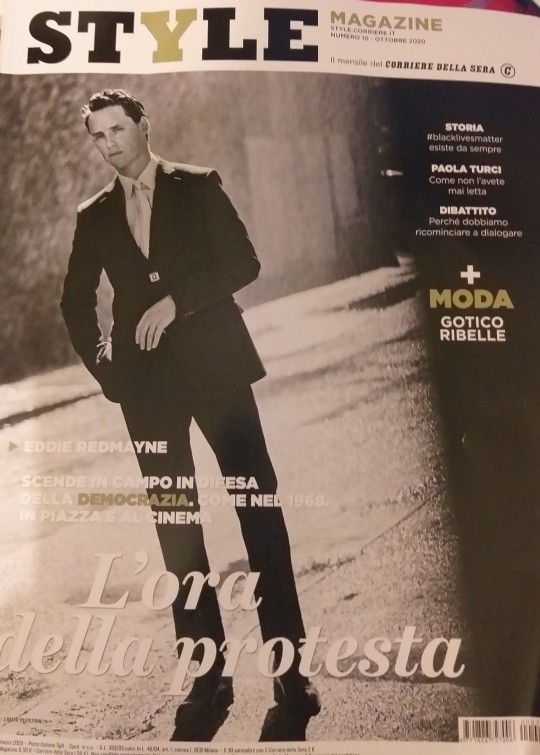

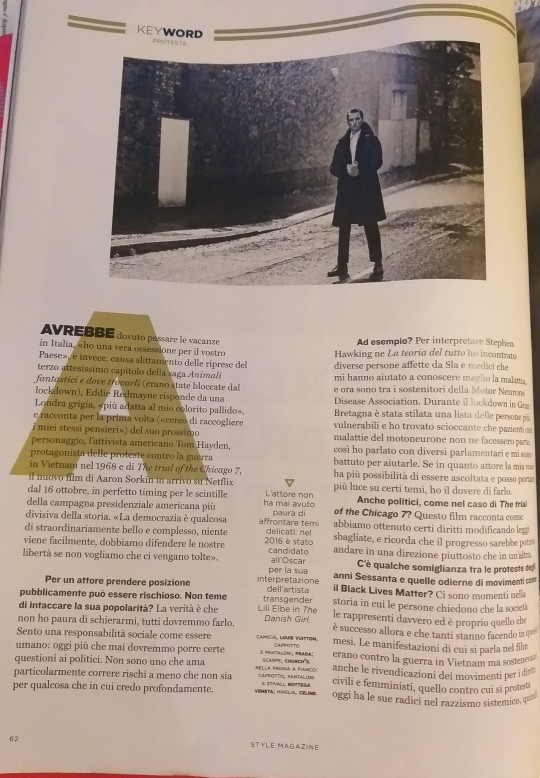
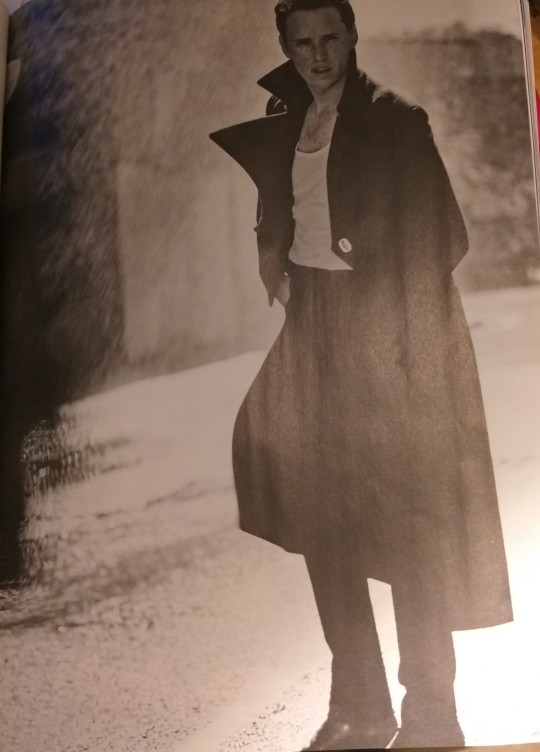

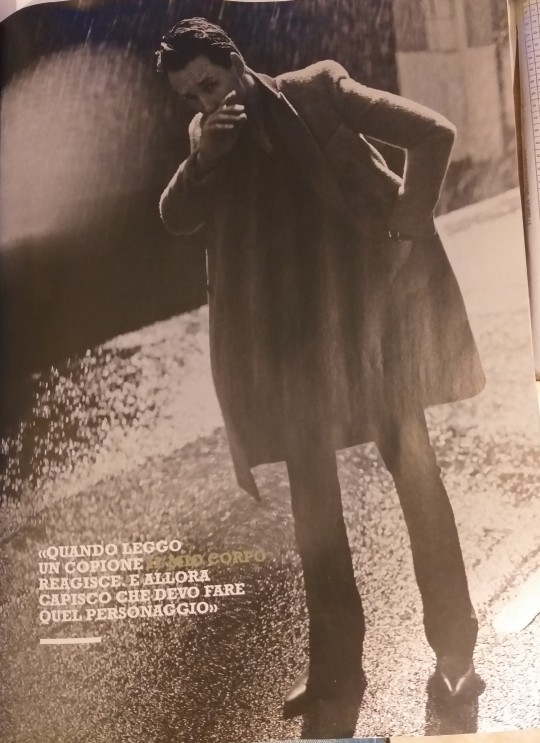

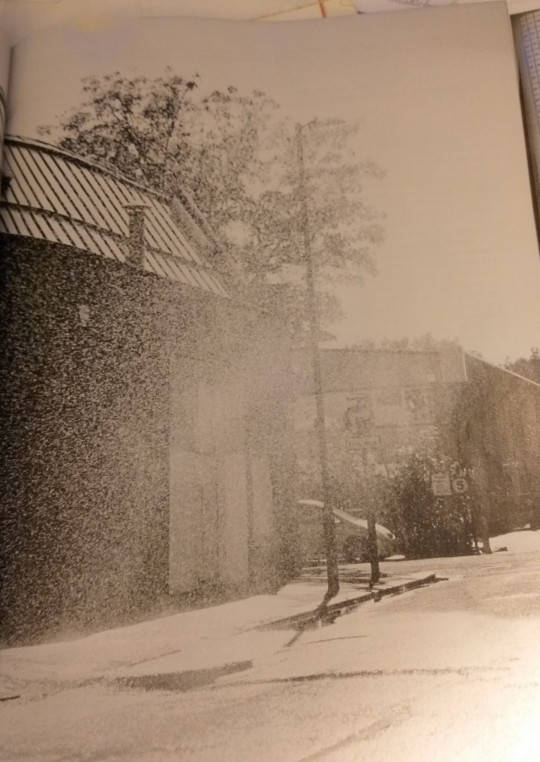
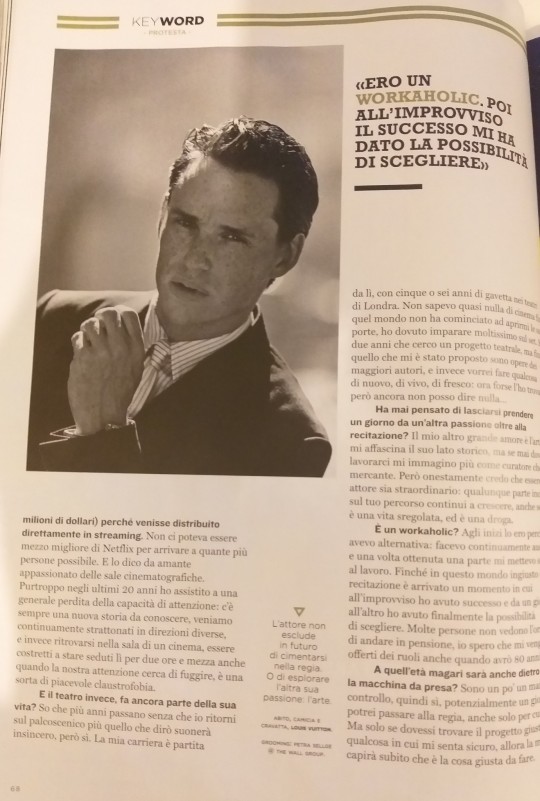

Eddie's interview from Style Magazine
By Valentina Ravizza
Photo: Boo George
Styling by Fabio Immediato.
Translate by me from Italian to English
HE WOULD HAVE had to spend the holiday in Italy,” I have a real obsession for your country “,Eddie Redmayne responds from a gray London,” more suited to my pale complexion”, and tells for the first time (and I try to collect my own thoughts) of his next character, the American activist Tom Hayden, protagonist of the protests against the Vietnam war in 1968 and 77e trial of the Chicago 7, the new film by Aaron Sorkin, arriving on Netflix from October 16. "Democracy is something extraordinarily beautiful and complex, nothing comes easily, we must defend our freedoms if we don't want them to be taken away from us."
It can be risky for an actor to take a public position, Aren't you afraid to undermine your popularity?
“The truth is, I'm not afraid to take sides, we all should. I feel a social responsibility as a human being: today more than ever we should ask politicians certain questions. I'm not one who particularly likes to take risks unless it's for something I deeply believe in.”
For exemple?
To play Stephen Hawking in The Theory of Everything I met several people affected by ALS and doctors who helped me to learn more about the disease, and now I am among the supporters of the Motor Neurone Disease Association. During the lockdown in Britain was made a list of vulnerable people and I found it shocking that patients with motor neuron disease were not part of it, so I spoke to several politicians and went to help them. As an actor my voice has more chances to be heard and I can bring more light on this topics, I have to do it.
Also politicians as in the case of The Trial of Chicago 7?
This film tells how we got rights by changing wrong laws and remember that progress could have gone in one direction rather than another.
Is there any similarity between the protests of the 1960s and those of movements such as Black Lives Matter ?
There are moments in history when people ask for society to really represent them and that's exactly what happened then and what many people are doing in these months. The demonstrations mentioned in the movie were against the Vietnam war, but also supported the claims of the civil rights and feminist movements, the one against which they are protesting today has it’s roots in systemic racism, so the similarities are many.And there are also several other parallels between the two political situations: at the 1968 Democratic convention there was a former vice president, Hubert H. Humphrey, right-hand man of Lyndon Johnson, who ran for the White House, as today former Vice President Joe Biden is in running, and there was a Republican candidate for president who was betting for “law and order” , then it was Richard Nixon, now the same campaign is being carried out by Donald Trump.
Today there is social media, what would have happened if Tom Hayden and the others from Chicago had it?
Hard to say, myself I don't use them . While they represent a great tool of democracy that gives everyone a voice from the shore to power, they also contribute to exacerbate and amplify the falsehoods and prejudices of those who listen only to what they want to hear, in a sort of echo chamber, and they can be used to manipulate things in a very pervasive way.
Is it more difficult to play a figure you esteem like Hayden or one you despise?
I try not to judge, to dissociate my sense of reality to recreate hers. I do as much research as possible, accumulating a lot of information and then throwing everything away and play only what's in the script, hoping that all the prep work has been absorbed somehow into my body, And knowing that that movie will never be. a documentary: I am creating a painting, not a photograph. For this I must accept that I will never be able to be exactly that person, that in something I will necessarily fail.
And when the character is a pure author’s Fantasy product?
It’s like when you were told at school to make a free written essay: I hated it, I said “please, give me a lead!”, In these cases I try first of all to understand what the boundaries are, to find some elements of truth: for example, in the saga of the Fantastic Beasts to become the "Magizoologist" Newt Scamander I started by observing the work of zoologists.
How is it divided between entertainment and committed movies?
In my choices I have always let myself be guided by instinct: I read a script that my body reacts, I get excited, I laugh, I am touched to the point of seeing myself in the role of that and than understand that I really have to do it.
Did the same happen with Tom Hayden?
They first told me about it three years ago while I was on vacation in Morocco, when told me it was Sorkin who wanted me it was like a dream come true. I read the script and it not only ran , but it had a kind of syncopated rhythm I immediately loved it. Then when I got better informed about the project, I found out that it had been written years ago and I couldn't believe he hadn't seen the light yet.
In fact, the first draft is from 2007.
We wondered if this movie had an audience, if it was current enough.Instead with what’s going it has become more and more pressing
So much so that in order to release it this year, given the health emergency Paramount Pictures has decided to sell the film to Netflix (56 millions of dollars) to be distributed directly via streaming.
There could be no better way than Netflix to reach as many people as possible. And I say this as a passionate cinemas’ lover . Unfortunately in the last 20 years I have witnessed a general loss of attention span: there is always a new story to know, we are constantly being pulled in different directions, and instead find ourselves in a cinema hall being forced to sit there for two hours and half even when our attention tries to escape, it’s a kind of pleasant claustrophobia.
And theater, is it still part of your life?
I know that more years go by without me returning to the stage more what I’ll say l’ll sound insincere, but yes, my career started from there, I spent 5 o 6 years working in London theaters. I knew almost nothing about cinema until that world began to open its doors to me, I had to learn a lot on the set. I’ve been looking for a theatrical project, but so far what has been proposed to me are works by the greatest authors, and instead I’d like do something new, fresh. Maybe I found it, but I still can't say anything.
Have you ever thought of letting yourself be taken one day by another passion besides acting?
My other great love is art, but if I ever have to work on it, I imagine myself more as a curator than as a co-worker. But I honestly think that being an actor is extraordinary: whatever part you encounter on your path continues to grow:although sure it’s a wild life and it's a drug.
Are you a workaholic?
In the beginning I was because I had no alternative: I was constantly auditioning and once I got a part immediately got to work, Until in this unfair world of acting there came a moment when I was suddenly successful and overnight I finally had the opportunity to choose. Many people are looking forward to retirement, I hope I’m offered roles even when I’m 80 years old.
At that age maybe you will also be behind the camera?
I'm a bit of a control freak,so yes, I could potentially one day go directing, even just out of curiosity But only if I had to find the right project, something in which I feel safe,
#eddie redmayne#interviewed#best actor#style magazine#boo george#photographer#valentina ravizza#interview#the trial of the chicago 7#tom hayden#activist#civil rights#the theory of everything#newton scamander#the danish girl#fantastic beasts and where to find them#newt scamander#obe#talent#les miserables#oscar winner#stephen hawking#netflix movie#aaron sorkin#script#director
55 notes
·
View notes
Text
RWRB Study Guide: Chapter 10
Hi y’all! I’m going through Casey McQuiston’s Red, White & Royal Blue and defining/explaining references! Feel free to follow along, or block the tag #rwrbStudyGuide if you’re not interested!
Earl Grey (267): Earl Grey tea is an incredibly common caffeinated tea. It is the base of a London fog.
Hamilton to Laurens, “you should not have taken advantage of my sensibility to steal into my affections without my consent” (267): This quote is from an April 1779 letter and is immediately followed by “But, as you have done it, and as we are generally indulgent to those we love, I shall not scruple to pardon the fraud you have committed, on one condition; that for my sake, of not your own, you will always continue to merit the partiality, which you have so artfully instilled into me”. Essentially, “you were rude to me, but I love you so much I forgive you as long as you look after yourself”. Just before it, Hamilton’s like “you taught me what it means to love”. (You can find it here)
Pyramus and Thisbe (268): The pair of lovers whose story inspired Romeo and Juliet, they were separated and could only talk through a wall between their houses (I’ve written a very in-depth analysis of this myth, which you can find here).
Dulles International to Heathrow (268): Dulles International is the airport in Washington, DC, and Heathrow is the classy airport in London.
John Cusack (270): An American actor largely known for his roles in the 1980s. This line in particular likely references Say Anything..., a romantic comedy known in part for a scene where Cusack’s character stands outside a girl’s window and plays music from a boombox.
Y’all had to marry your cousins (270): A reference to the royal tradition of only marrying other royals, which led to a whole lot of inbreeding.
Consummation (275): To consummate a marriage is to have sex for the first time, therefore making it “official”.
Wilde’s complete works (276): Oscar Wilde is an Irish author famous for writing satires and also defining gay culture in the late 1800s.
Fit of pique (277): If someone does something in a fit of pique, they do it spontaneously and out of anger at being wronged.
Mr. Darcy brooding at Pemberley (278): In Austen’s Pride and Prejudice (spoilers, though it’s been out for 207 years), after Elizabeth rejects Darcy’s first marriage proposal (which is essentially “your family sucks but you’re hot; marry me”), he goes back to the house his family owns and thinks about it and misses her.
Anmer Hall (278): A house owned by the Crown in Norfolk, England; it is currently home to Prince William, Duke of Cambridge.
Mel and Sue (280): A comedy duo and hosts of The Great British Bake Off. Sue was outed in 2002, but claims that “being a lesbian is only about the 47th most interesting thing about me”.
South Kensington (284): A district of West London known for its high density of museums and cultural landmarks.
Prince Consort Road (284): Prince Consort Road is a street in London named after Prince Albert, consort to Queen Victoria. A consort is a royal’s spouse or partner (hence Alex laughing at the idea of his being a prince’s consort)
Ferris Bueller/ Sloane (284-285): Ferris Bueller’s Day Off is a popular movie from the 1980s about Ferris, who skips school for a day of wild shenanigans in Chicago. Sloane is his girlfriend who’s roped in for the ride.
Victoria and Albert Museum* (285): The Victoria and Albert Museum, often abbreviated “V&A”, is the world’s largest museum of applied and decorative art and design. (you can explore their collections here)
Renaissance City (285): Room 50a of the V&A is full of Renaissance sculptures. (photo here)
Seated Buddha in black stone (285): The V&A has a bunch of Buddha sculptures, but this one is the only one I saw that’s in black stone.
John the Baptist nude and in bronze (285): Possibly this piece from 1881 by French sculptor Auguste Rodin and is in the V&A’s collection.
Tipu’s Tiger (285): A nearly life-sized semi-automaton that shows a tiger mauling a man in European clothes. The tiger makes growling sounds and the man screams and waves his hand when a handle on the side is turned; it also contains a small pipe organ on the inside and was created to show the power that the Tipu Sultan of India held over invading Brits. The “give it back” that Catherine argues for is officially called repatriation, it would mean that (Western) museums have to give back stolen objects; British museums are famously bad at doing this. (see Tipu’s Tiger here)
Westminster (286): Westminster Abbey, a church in London where royals are crowned and buried. It is covered with intricate carvings and beautiful stained glass.
The Great Bed of Ware (286): A bed made by Hans Vredeman de Vries from the 1590s; it is ten feet wide and made of oak. (see it here)
Twelfth Night (286): A Shakespeare comedy full of chaos that includes a woman cross-dressing, then her twin brother being mistaken for her.
Epocoene (286): A 1609 play that includes a boy dressing as a woman to dupe a man into giving his son an acceptable inheritance.
Don Juan (286): A Spanish figure known for his powers for wooing women; the first text published about him was in the 1630s.
Florence (287): Florence is a city known for its art; it was the cultural center of the Italian renaissance.
Gothic choir screen in the V&A’s Renaissance City (287): This Roodloft, or choir screen, carved by Coenraed van Norenberch is in the back of the Renaissance City in the V&A. It’s a stunning piece; the link above has great pictures and a more in-depth description than I could give.
Zephyr statue by Francavilla (287): You can see this statue here; it was one of thirteen statues commissioned for the garden of a villa near Florence. According to Greek mythology, Zephyr (the west wind) was married to Chloris, goddess of flowers.
Narcissus (by Cioli) (287): This statue may have once been the centerpiece to a fountain with Narcissus looking into an actual pool; it depicts him in the moment he sees and is mesmerised by his reflection.
Pluto stealing Proserpina (287): Likely the statue “The Rape of Proserpina” by Vincenzo de' Rossi. I couldn’t find it on the V&A’s site, but there’s more info here.
Jason with the Golden Fleece (287): This is a sculpture of a very naked Jason, the Greek hero who stole the golden fleece. He was helped by its owner’s daughter, who was in love with him, but whom he later abandoned. You can see the statue here.
Samson Slaying a Philistine (287): You can see this statue here. Henry does a pretty good job of explaining the incredible history behind it; all I have to add from my (limited) research is that it is remarkable in part for the fact that there is no one point on it that draws the eye-- it demands to be looked at completely or not at all.
Victoria and sodomy laws (288): Queen Victoria famously instituted a whole lot of anti-sodomy laws.
Viau on James/George (288): A 1623 poem by Théophile de Viau:
“Apollo with his songs
Debauched young Hyacinthus
Just as Corydon fucked Amyntas,
So Caesar did not spurn boys.
One man fucks Monsieur le Grand de Bellegarde [a friend of Viau],
Another fucks the Comte de Tonnerre.
And it is well known that the King of England
Fucks the Duke of Buckingham.”
“Christ had John, and I have George” (288): This is an actual thing that James I/VI said to the heads of the church. Here’s the full quote, from wikipedia (emphasis is my own): “I, James, am neither a god nor an angel, but a man like any other. Therefore I act like a man and confess to loving those dear to me more than other men. You may be sure that I love the Earl of Buckingham more than anyone else, and more than you who are here, assembled. I wish to speak in my own behalf and not to have it thought to be a defect, for Jesus Christ did the same, and therefore I cannot be blamed. Christ had John, and I have George.”
George iii (289): George III was the king against whom the American colonies revolted. He was deeply religious and instituted laws declaring that royals could not marry without the approval of the court.
Convent church of Santa Chiara in Florence (290): This church is no longer a church, but the altar chapel is in an alcove in the V&A. It is the only Italian Renaissance chapel outside of Italy. (you can see photos of it here and here)
Santa Chiara and Saint Francis of Assisi (290): Saint Francis of Assisi founded a few different monastic orders and is one of the most celebrated saints; Saint Clare of Assisi founded a women’s monastic order and wrote the first set of monastic guidelines by a woman.
Blessed Mother (290): Mary, the mother of Jesus, one of the holiest figures in Catholicism.
“Come, hijo mío, de la miel, porque es Buena, and the honeycomb sweet to thy taste”** (290): “My son, eat thou honey, because it is good; and the honeycomb, which is sweet to thy taste. So shall the knowledge of wisdom be unto thy soul: when thou hast found it, then there shall be a reward, and thy expectation shall not be cut off” -- Proverbs 24:13-14, King James Version (yes, that King James. He translated the Bible to make the church stop hating him).
David and Jonathan (290): An aggressively gay couple from the Bible who have been presented as friends for centuries. Jonathan was a prince and David a shepherd, but God promised that David would be king one day. Rather than argue this or hate David for it, Jonathan welcomed David into his household and loved him despite the prophecy that he would one day usurp him. Following Jonathan’s death, David took in Jonathan’s son and looked after him.
Father, Son, and Holy Spirit, amen (291): Many Christian prayers end with “in the name of the Father, the son, and of the Holy Spirit, amen”. It’s a way of celebrating the god who gives you all of the good things in your life while also giving up control to them.
------
A fill in from chapter 1, as requested by someone on AO3:
Deputy Chief of Staff (Zahra’s position, 23): The Deputy Chief of Staff is the top aide to the president’s top aide, and is responsible for ensuring that everything runs smoothly within the bureaucracy of the White House.
------
*This museum puts out books called “maker’s guides” that teach you how to make pieces based on things in their collections; they’re super duper cool.
**I’m not a theologian, but I am a pastor’s kid, and just... this gets me. This whole bit, but this Proverb especially. Like obviously there’s the “oh we’re kissing and I’m thinking about honey tasting sweet”, but verse 14 coming in with the “when you’ve found what’s right, you will be rewarded with the confidence of that rightness and you will have hope”? Just kill me outright next time. Don’t make me google my own murder weapon.
------
If there’s anything I missed or that you’d like more on, please let me know! And if you’d like to/are able, please consider buying me a ko-fi? I know not everyone can, and that’s fine, but these things take a lot of time/work and I’d really appreciate it!
—–-
Chapter 1 // Chapter 9 // Chapter 11
#this is for that anon who thinks I'm smart and cute#but y'all can read it too#rwrb study guide#rwrb analysis#English Major Brain™#English Major Brain™️#rwrb#alex claremont diaz#henry fox mountchristen windsor x alex claremont diaz#henry fox mountchristen windsor#june claremont diaz#nora holleran#pez okonjo#bea fox mountchristen windsor#firstprince#red white and royal blue
22 notes
·
View notes
Text
Harold Washington
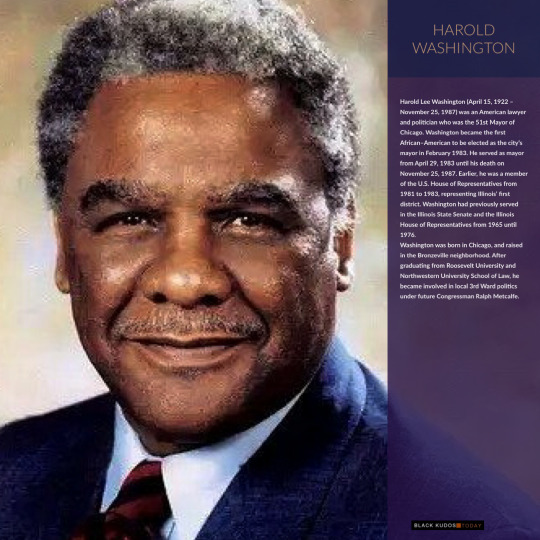
Harold Lee Washington (April 15, 1922 – November 25, 1987) was an American lawyer and politician who was the 51st Mayor of Chicago. Washington became the first African American to be elected as the city's mayor in February 1983. He served as mayor from April 29, 1983 until his death on November 25, 1987. Born in Chicago and raised in the Bronzeville neighborhood, Washington became involved in local 3rd Ward politics under Chicago Alderman and future Congressman Ralph Metcalfe after graduating from Roosevelt University and Northwestern University School of Law. Washington was a member of the U.S. House of Representatives from 1981 to 1983, representing Illinois's first district. Washington had previously served in the Illinois State Senate and the Illinois House of Representatives from 1965 until 1976.
Biography
Ancestry
The earliest known ancestor of Harold Lee Washington, Isam/Isham Washington, was born a slave in 1832 in North Carolina. In 1864 he enlisted in the 8th United States Colored Heavy Artillery, Company L, in Paducah, Kentucky. Following his discharge in 1866, he began farming with his wife Rebecca Neal in Ballard County, Kentucky. Among their six children was Isam/Isom McDaniel (Mack) Washington, who was born in 1875. In 1896, Mack Washington had married Arbella Weeks of Massac County, who had been born in Mississippi in 1878. In 1897, their first son, Roy L. Washington, father of Mayor Washington was born in Ballard County, Kentucky. In 1903, shortly after both families moved to Massac County, Illinois, the elder Washington died. After farming for a time, Mack Washington became a minister in the African Methodist Episcopal (A.M.E.) Church, serving numerous churches in Illinois until the death of his wife in 1952. Reverend I.M.D. Washington died in 1953.
Early life and education
Harold Lee Washington was born on April 15, 1922 at Cook County Hospital in Chicago, Illinois, to Roy and Bertha Washington. While still in high school in Lawrenceville, Illinois, Roy met Bertha from nearby Carrier Mills and the two married in 1916 in Harrisburg, Illinois. Their first son, Roy Jr., was born in Carrier Mills before the family moved to Chicago where Roy enrolled in Kent College of Law. A lawyer, he became one of the first black precinct captains in the city, and a Methodist minister. In 1918, daughter Geneva was born and second son Edward was born in 1920. Bertha left the family, possibly to seek her fortune as a singer, and the couple divorced in 1928. Bertha remarried and had seven more children including Ramon Price, who was an artist and eventually became chief curator of The DuSable Museum of African American History. Harold Washington grew up in Bronzeville, a Chicago neighborhood that was the center of black culture for the entire Midwest in the early and middle 20th century. Edward and Harold stayed with their father while Roy Jr and Geneva were cared by grandparents. After attending St Benedict the Moor Boarding School in Milwaukee from 1928 to 1932, Washington attended DuSable High School, then a newly established racially segregated public high school, and was a member of its first graduating class. In a 1939 citywide track meet, Washington placed first in the 110-meter high hurdles event, and second in the 220-meter low hurdles event. Between his junior and senior year of high school, Washington dropped out, claiming that he no longer felt challenged by the coursework. He worked at a meatpacking plant for a time before his father helped him get a job at the U.S. Treasury branch in the city. There he met Nancy Dorothy Finch, whom he married soon after; Washington was 19 years old and Dorothy was 17 years old. Seven months later, the U.S. was drawn into World War II with the bombing of Pearl Harbor by the Japanese on Sunday, December 7, 1941.
Military service
In 1942, Washington was drafted into the United States Army for the war effort and after basic training, sent overseas as part of a racially segregated unit of the U.S. Army Air Corps unit of Engineers. After the American invasion of the Philippines in 1944, on Leyte Island and later the main Luzon island, Washington was part of a unit building runways for bombers, protective fighter aircraft, refueling planes, and returning damaged aircraft. Eventually, Washington rose to the rank of First Sergeant in the Army Air Corps (later in the war renamed the U.S. Army Air Forces).
Roosevelt College
In the summer of 1946, Washington, aged 24 and a war veteran, enrolled at Roosevelt College (now Roosevelt University). Washington joined other groups of students not permitted to enroll in other local colleges. Local estimates placed the student population of Roosevelt College at about 1/8 black and 1/2 Jewish. A full 75% of the students had enrolled because of the "nondiscriminatory progressive principles." He chaired a fund-raising drive by students, and then was named to a committee that supported citywide efforts to outlaw "restrictive covenants" in housing, the legal means by which minorities (especially blacks ("negroes") and, to a lesser extent, Jews) were prohibited from purchasing real estate in predominantly white neighborhoods of the city.
In 1948, after the college had moved to the Auditorium Building, Washington was elected the third president of Roosevelt's student council. Under his leadership, the student council successfully petitioned the college to have student representation on Roosevelt's faculty committees. At the first regional meeting of the newly founded National Student Association in the spring of 1948, Washington and nine other delegates proposed student representation on college faculties, and a "Bill of Rights" for students; both measures were roundly defeated. The next year, Washington went to the state capital at Springfield to protest Illinois legislators' coming probe of "subversives". The probe of investigation would outlaw the Communist Party and require "loyalty oaths" for teachers. He led students' opposition to the bills, although they would pass later in 1949.
During his Roosevelt College years, Washington came to be known for his stability. His friends said that he had a "remarkable ability to keep cool", reason carefully and walk a middle line. Washington intentionally avoided extremist activities, including street actions and sit-ins against racially segregated restaurants and businesses. Overall, Washington and other radical activists ended up sharing a mutual respect for each other, acknowledging both Washington's pragmatism and the activists' idealism. With the opportunities found only at Roosevelt College in the late 1940s, Washington's time at the Roosevelt College proved to be pivotal. Washington graduated in August 1949, with a Bachelor of Arts (B.A.) degree. In addition to his activities at Roosevelt, he was a member of Phi Beta Sigma fraternity.
Northwestern University School of Law
Washington then applied and was admitted to study law at the Northwestern University School of Law in Chicago. During this time, Washington was divorced from Dorothy Finch. By some accounts, Harold and Dorothy had simply grown apart after Washington was sent overseas during the war during the first year of his marriage. Others saw both as young and headstrong, the relationship doomed from the beginning. Another friend of Washington's deemed Harold "not the marrying kind." He would not marry again, but continued to have relationships with other women; his longtime secretary is said to have said, "If every woman Harold slept with stood at one end of City Hall, the building would sink five inches into LaSalle Street!".
At Northwestern Law School, Washington was the only black student in his class (there were six women in the class, one of them being Dawn Clark Netsch). As at Roosevelt, he entered school politics. In 1951, his last year, he was elected treasurer of the Junior Bar Association (JBA). The election was largely symbolic, however, and Washington's attempts to give the JBA more authority at Northwestern were largely unsuccessful. On campus, Washington joined the Nu Beta Epsilon fraternity, largely because he and the other minorities which constituted the fraternity were blatantly excluded from the other fraternities on campus. Overall, Washington stayed away from the activism that defined his years at Roosevelt. During the evenings and weekends, he worked to supplement his GI Bill income. He received his JD in 1952.
Legislative political career
Working for Metcalfe (1951–1965)
From 1951 until he was first slated for election in 1965, Washington worked in the offices of the 3rd Ward Alderman, former Olympic athlete Ralph Metcalfe. Richard J. Daley was elected party chairman in 1952. Daley replaced C.C. Wimbush, an ally of William Dawson, on the party committee with Metcalfe. Under Metcalfe, the 3rd Ward was a critical factor in Mayor Daley's 1955 mayoral election victory and ranked first in the city in the size of its Democratic plurality in 1961. While working under Metcalfe, Washington began to organize the 3rd Ward's Young Democrats (YD) organization. At YD conventions, the 3rd Ward would push for numerous resolutions in the interest of blacks. Eventually, other black YD organizations would come to the 3rd Ward headquarters for advice on how to run their own organizations. Like he had at Roosevelt College, Washington avoided radicalism and preferred to work through the party to engender change.
While working with the Young Democrats, Washington met Mary Ella Smith. They dated for the next 20 years, and in 1983 Washington proposed to Smith. In an interview with the Chicago Sun-Times, Smith said that she never pressed Washington for marriage because she knew Washington's first love was politics, saying, "He was a political animal. He thrived on it, and I knew any thoughts of marriage would have to wait. I wasn't concerned about that. I just knew the day would come."
In 1959 Al Janney, Gus Savage, Lemuel Bentley, Bennett Johnson, Luster Jackson and others founded the Chicago League of Negro Voters, one of the first African-American political organizations in the city. In its first election, Bentley drew 60,000 votes for city clerk. The endorsement of the League was deciding factor in the re-election of Leon DesPres who was an independent voice in the City Council. Washington was a close friend of the founders of the League and worked with them from time to time. The League was key in electing Anna Langford, William Cousins and A. A. "Sammy" Rayner who were not part of the Daley machine. In 1963 the group moved to racially integrate and formed Protest at the Polls at a citywide conference which Washington independent candidates had gained traction within the black community, winning several aldermanic seats. In 1983, Protest at the Polls was instrumental in Washington's run for mayor. By then, the YDs were losing to independent candidates.
Illinois House (1965–1976)
After the state legislature failed to reapportion districts as required by the census every ten years, an at-large election was held in January 1965 to elect 177 representatives. With the Republicans and Democrats combining to slate only 118 candidates, independent voting groups seized the opportunity to slate candidates. The League of Negro Voters created a "Third Slate" of 59 candidates, announcing the slate on June 27, 1964. Shortly afterwards, Daley put together a slate including Adlai Stevenson III and Washington. The Third Slate was then thrown out by the Illinois Election Board because of "insufficient signatures" on the nominating petitions. In the election, Washington received the second-largest amount of ballots, behind Stevenson. Washington's years in the Illinois House were marked by tension with Democratic Party leadership. In 1967, he was ranked by the Independent Voters of Illinois (IVI) as the fourth-most independent legislator in the Illinois House and named Best Legislator of the Year. His defiance of the "idiot card", a sheet of paper that directed legislators' votes on every issue, attracted the attention of party leaders, who moved to remove Washington from his legislative position. Daley often told Metcalfe to dump Washington as a candidate, but Metcalfe did not want to risk losing the 3rd Ward's Young Democrats, who were mostly aligned with Washington.
Washington backed Renault Robinson, a black police officer and one of the founders of the Afro-American Patrolmen's League (AAPL). The aim of the AAPL was to fight racism directed against minority officers by the rest of the predominantly white department. Soon after the creation of the group, Robinson was written up for minor infractions, suspended, reinstated, and then placed on the graveyard shift to a single block behind central police headquarters. Robinson approached Washington to fashion a bill creating a civilian review board, consisting of both patrolmen and officers, to monitor police brutality. Both black independent and white liberal legislators refused to back the bill, afraid to challenge Daley's grip on the police force.
After Washington announced he would support the AAPL, Metcalfe refused to protect him from Daley. Washington believed he had the support of John Touhy, Speaker of the House and a former party chair. Instead, Touhy criticized Washington and then allayed Daley's anger. In exchange for the party's backing, Washington would serve on the Chicago Crime Commission, the group Daley formed to investigate the AAPL's charges. The commission promptly found the AAPL's charges "unwarranted". An angry and humiliated Washington admitted that on the commission, he felt like Daley's "showcase ni***r". In 1969, Daley removed Washington's name from the slate; only by the intervention of Cecil Partee, a party loyalist, was Washington reinstated. The Democratic Party supported Jim Taylor, a former professional boxer, Streets and Sanitation worker, over Washington. With Partee and his own ward's support, Washington defeated Taylor. His years in the House of Representatives were focused on becoming an advocate for black rights. He continued work on the Fair Housing Act, and worked to strengthen the state's Fair Employment Practices Commission (FEPC). In addition, he worked on a state Civil Rights Act, which would strengthen employment and housing provisions in the federal Civil Rights Act of 1964. In his first session, all of his bills were sent to committee or tabled. Like his time in Roosevelt College, Washington relied on parliamentary tactics (e.g., writing amendments guaranteed to fail in a vote) to enable him to bargain for more concessions.
Washington was accused of failure to file a tax return, even though the tax was paid. He was found guilty and sentenced to 36 days in jail. (1971)
Washington also passed bills honoring civil rights figures. He passed a resolution honoring Metcalfe, his mentor. He also passed a resolution honoring James J. Reeb, a Unitarian minister who was beaten to death in Selma, Alabama by a segregationist mob. After the assassination of Martin Luther King, Jr., he introduced a series of bills aimed at making King's birthday a state holiday. The first was tabled and later vetoed. The third bill he introduced, which was passed and signed Gov. Richard Ogilvie, made Dr. King's birthday a commemorative day observed by Illinois public schools. It was not until 1973 that Washington was able, with Partee's help in the Senate, to have the bill enacted and signed by the governor.
1975 speakership campaign
Washington ran a largely symbolic campaign for Speaker. He only received votes from himself and from Lewis A. H. Caldwell. However, with a divided Democratic caucus, this was enough to help deny Daley-backed Clyde Choate the nomination, helping to throw it to William A. Redmond after 92 rounds of voting.
Redmond had Washington appointed as chairman of the Judiciary Committee.
Illinois Senate (1976–1980)Campaign for Illinois Senate
In 1975, Partee, now President of the Senate and eligible for his pension, decided to retire from the Senate. Although Daley and Taylor declined at first, at Partee's insistence, Washington was ultimately slated for the seat and received the party's support. Daley had been displeased with Washington for having run a symbolic challenge in 1975 to Daley-backed Clyde Choate for Illinois Speaker of the House (Washington had only received two votes). He had also helped ultimately push the vote towards Redmond as a compromise candidate. The United Automobile Workers union, whose backing Washington obtained, were critical in persuading Daley to relent to back his candidacy.
Washington defeated Anna Langford by nearly 2,000 votes in the Democratic primary. He went on to win the general election.
Human Rights Act of 1980
In the Illinois Senate, Washington's main focus worked to pass 1980's Illinois Human Rights Act. Legislators rewrote all of the human rights laws in the state, restricting discrimination based on "race, color, religion, sex, national origin, ancestry, age, marital status, physical or mental disability, military status, sexual orientation, or unfavorable discharge from military service in connection with employment, real estate transactions, access to financial credit, and the availability of public accommodations." The bill's origins began in 1970 with the rewriting of the Illinois Constitution. The new constitution required all governmental agencies and departments to be reorganized for efficiency. Republican governor James R. Thompson reorganized low-profile departments before his re-election in 1978. In 1979, during the early stages of his second term and immediately in the aftermath of the largest vote for a gubernatorial candidate in the state's history, Thompson called for human rights reorganization. The bill would consolidate and remove some agencies, eliminating a number of political jobs. Some Democratic legislators would oppose any measure backed by Washington, Thompson and Republican legislators.
For many years, human rights had been a campaign issue brought up and backed by Democrats. Thompson's staffers brought the bill to Washington and other black legislators before it was presented to the legislature. Washington made adjustments in anticipation of some legislators' concerns regarding the bill, before speaking for it in April 1979. On May 24, 1979, the bill passed the Senate by a vote of 59 to 1, with two voting present and six absent. The victory in the Senate was attributed by a Thompson staffer to Washington's "calm noncombative presentation". However, the bill stalled in the House. State Representative Susan Catania insisted on attaching an amendment to allow women guarantees in the use of credit cards. This effort was assisted by Carol Moseley Braun, a representative from Hyde Park who would later go on to serve as a U.S. Senator. State Representatives Jim Taylor and Larry Bullock introduced over one hundred amendments, including the text of the first ten amendments to the U.S. Constitution, to try to stall the bill. With Catania's amendment, the bill passed the House, but the Senate refused to accept the amendment. On June 30, 1979, the legislature adjourned.
U.S. House (1981–1983)
In 1980, Washington was elected to the U.S. House of Representatives in Illinois's 1st congressional district. He defeated incumbent Representative Bennett Stewart in the Democratic primary. Anticipating that the Democratic Party would challenge him in his bid for re-nomination in 1982, Washington spent much of his first term campaigning for re-election, often travelling back to Chicago to campaign. Washington missed many House votes, an issue that would come up in his campaign for mayor in 1983. Washington's major congressional accomplishment involved legislation to extend the Voting Rights Act, legislation that opponents had argued was only necessary in an emergency. Others, including Congressman Henry Hyde, had submitted amendments designed to seriously weaken the power of the Voting Rights Act.
Although he had been called "crazy" for railing in the House of Representatives against deep cuts to social programs, Associated Press political reporter Mike Robinson noted that Washington worked "quietly and thoughtfully" as the time came to pass the act. During hearings in the South regarding the Voting Rights Act, Washington asked questions that shed light on tactics used to prevent African Americans from voting (among them, closing registration early, literacy tests, and gerrymandering). After the amendments were submitted on the floor, Washington spoke from prepared speeches that avoided rhetoric and addressed the issues. As a result, the amendments were defeated, and Congress passed the Voting Rights Act Extension. By the time Washington faced re-election in 1982, he had cemented his popularity in the 1st Congressional District. Jane Byrne could not find one serious candidate to run against Washington for his re-election campaign. He had collected 250,000 signatures to get on the ballot, although only 610 signatures (0.5% of the voters in the previous election) were required. With his re-election to Congress locked up, Washington turned his attention to the next Chicago mayoral election.
Mayor of Chicago (1983–1987)
1983 election
In the February 22, 1983, Democratic mayoral primary, more than 100,000 new voters registered to vote led by a coalition that included the Latino reformed gang Young Lords led by Jose Cha Cha Jimenez. On the North and Northwest Sides, the incumbent mayor Jane Byrne led and future mayor Richard M. Daley, son of the late Mayor Richard J. Daley, finished a close second. Harold Washington had massive majorities on the South and West Sides. Southwest Side voters overwhelmingly supported Daley. Washington won with 37% of the vote, versus 33% for Byrne and 30% for Daley. Although winning the Democratic primary was normally considered tantamount to election in heavily Democratic Chicago, after his primary victory Washington found that his Republican opponent, former state legislator Bernard Epton (earlier considered a nominal stand-in), was supported by many high-ranking Democrats and their ward organizations, including the chairman of the Cook County Democratic Party, Alderman Edward Vrdolyak.
Epton's campaign referred to, among other things, Washington's conviction for failure to file income tax returns (he had paid the taxes, but had not filed a return). Washington, on the other hand, stressed reforming the Chicago patronage system and the need for a jobs program in a tight economy. In the April 12, 1983, mayoral general election, Washington defeated Epton by 3.7%, 51.7% to 48.0%, to become mayor of Chicago. Washington was sworn in as mayor on April 29, 1983, and resigned his Congressional seat the following day.
First term and Council Wars
During his tenure as mayor, Washington lived at the Hampton House apartments in the Hyde Park neighborhood of Chicago. He created the city's first environmental-affairs department under the management of longtime Great Lakes environmentalist Lee Botts. Washington's first term in office was characterized by conflict with the city council dubbed "Council Wars", referring to the then-recent Star Wars films and caused Chicago to be nicknamed "Beirut on the Lake". A 29-alderman City Council majority refused to enact Washington's legislation and prevented him from appointing nominees to boards and commissions. First-term challenges included city population loss and a massive decrease in ridership on the Chicago Transit Authority (CTA). Assertions that the overall crime rate increased were incorrect.
The 29, also known as the "Vrdolyak 29", were led by Vrdolyak (who was an Alderman in addition to Cook County Democratic Party chairman) and Finance Chair, Alderman Edward Burke. Parks superintendent Edmund Kelly also opposed the mayor. The three were known as "the Eddies" and were supported by the younger Daley (now State's Attorney), U.S. Congressmen Dan Rostenkowski and William Lipinski, and much of the Democratic Party. During his first city council meeting, Washington and the 21 supportive aldermen walked out of the meeting after a quorum had been established. Vrdolyak and the other 28 then chose committee chairmen and assigned aldermen to the various committees. Later lawsuits submitted by Washington and others were dismissed because it was determined that the appointments were legally made. Washington ruled by veto. The 29 lacked the 30th vote they needed to override Washington's veto; female and African American aldermen supported Washington despite pressure from the Eddies. Meanwhile, in the courts, Washington kept the pressure on to reverse the redistricting of city council wards that the city council had created during the Byrne years. During special elections in 1986, victorious Washington-backed candidates in the first round ensured at least 24 supporters in the city council. Six weeks later, when Marlene Carter and Luís Gutiérrez won run-off elections, Washington had the 25 aldermen he needed. His vote as president of the City Council enabled him to break 25–25 tie-votes and enact his programs.
1987 election
Washington defeated former mayor Jane Byrne in the February 24, 1987 Democratic mayoral primary by 7.2%, 53.5% to 46.3%, and in the April 7, 1987 mayoral general election defeated Vrdolyak (Illinois Solidarity Party) by 11.8%, 53.8% to 42.8%, with Northwestern University business professor Donald Haider (Republican) getting 4.3%, to win reelection to a second term as mayor. Cook County Assessor Thomas Hynes (Chicago First Party), a Daley ally, dropped out of the race 36 hours before the mayoral general election. During Washington's short second term, the Eddies lost much of their power: Vrdolyak became a Republican, Kelly was removed from his powerful parks post, and Burke lost his Finance Committee chairmanship.
Political Education Project (PEP)
From March 1984 to 1987, the Political Education Project (PEP) served as Washington's political arm, organizing both Washington's campaigns and the campaigns of his political allies. Harold Washington established the Political Education Project in 1984. This organization supported Washington's interests in electoral politics beyond the Office of the Mayor. PEP helped organize political candidates for statewide elections in 1984 and managed Washington's participation in the 1984 Democratic National Convention as a "favorite son" presidential candidate. PEP used its political connections to support candidates such as Luis Gutiérrez and Jesús "Chuy" García through field operations, voter registration and Election Day poll monitoring. Once elected, these aldermen helped break the stalemate between Washington and his opponents in the city council. Due to PEP's efforts, Washington's City Council legislation gained ground and his popularity grew as the 1987 mayoral election approached. In preparation for the 1987 mayoral election, PEP formed the Committee to Re-Elect Mayor Washington. This organization carried out fundraising for the campaign, conducted campaign events, and coordinated volunteers. PEP staff members, such as Joseph Gardner and Helen Shiller, went on to play leading roles in Chicago politics.
The organization disbanded upon Harold Washington's death. Harold Washington's Political Education Project Records is an archival collection detailing the organization's work. It is located in the Chicago Public Library Special Collections, Harold Washington Library Center, Chicago, Illinois.
Legal issues
In addition to Daley's strong-arm tactics, Washington's time in the Illinois House was also marred by problems with tax returns and allegations of not performing services owed to his clients. In her biography, Levinsohn questions whether the timing of Washington's legal troubles was politically motivated. In November 1966, Washington was re-elected to the House over Daley's strong objections; the first complaint was filed in 1964; the second was filed by January 1967. A letter asking Washington to explain the matter was sent on January 5, 1967. After failing to respond to numerous summons and subpoenas, the commission recommend a five-year suspension on March 18, 1968. A formal response to the charges did not occur until July 10, 1969. In his reply, Washington said that "sometimes personal problems are enlarged out of proportion to the entire life picture at the time and the more important things are abandoned." In 1970, the Board of Managers of the Chicago Bar Association ruled that Washington's license be suspended for only one year, not the five recommended; the total amount in question between all six clients was $205.
In 1971, Washington was charged with failure to file tax returns for four years, although the Internal Revenue Service (IRS) claimed to have evidence for nineteen years. Judge Sam Perry noted that he was "disturbed that this case ever made it to my courtroom" — while Washington had paid his taxes, he ended up owing the government a total of $508 as a result of not filing his returns. Typically, the IRS handled such cases in civil court, or within its bureaucracy. Washington pleaded "no contest" and was sentenced to forty days in Cook County Jail, a $1,000 fine, and three years of probation.
Death and funeral
On November 25, 1987, at 11:00 am, Chicago Fire Department paramedics were called to City Hall. Washington's press secretary, Alton Miller, had been discussing school board issues with the mayor when Washington suddenly slumped over on his desk, falling unconscious. After failing to revive Washington in his office, paramedics rushed him to Northwestern Memorial Hospital. Further attempts to revive him failed, and Washington was pronounced dead at 1:36 pm At Daley Plaza, Patrick Keen, project director for the Westside Habitat for Humanity, announced Washington's official time of death to a separate gathering of Chicagoans. Initial reactions to the pronouncement of his death were of shock and sadness, as many blacks believed that Washington was the only top Chicago official who would address their concerns. Thousands of Chicagoans attended his wake in the lobby of City Hall between November 27 and 29, 1987. On November 30, 1987, Reverend B. Herbert Martin officiated Washington's funeral service in Christ Universal Temple at 119th Street and Ashland Avenue in Chicago. After the service, Washington was buried in Oak Woods Cemetery on the South Side of Chicago.
Rumors
Immediately after Washington's death, rumors about how Washington died began to surface. On January 6, 1988, Dr. Antonio Senat, Washington's personal physician, denied "unfounded speculations" that Washington had cocaine in his system at the time of his death, or that foul play was involved. Cook County Medical Examiner Robert J. Stein performed an autopsy on Washington and concluded that Washington had died of a heart attack. Washington had weighed 284 pounds (129 kg), and suffered from hypertension, high cholesterol levels, and an enlarged heart. On June 20, 1988, Alton Miller again indicated that drug reports on Washington had come back negative, and that Washington had not been poisoned prior to his death. Dr. Stein stated that the only drug in Washington's system had been lidocaine, which is used to stabilize the heart after a heart attack takes place. The drug was given to Washington either by paramedics or by doctors at Northwestern Memorial Hospital. Bernard Epton, Washington's opponent in the 1983 general election, died 18 days later, on December 13, 1987.
Legacy
At a party held shortly after his re-election on April 7, 1987, Washington said to a group of supporters, "In the old days, when you told people in other countries that you were from Chicago, they would say, 'Boom-boom! Rat-a-tat-tat!' Nowadays, they say [crowd joins with him], 'How's Harold?'!"
In later years, various city facilities and institutions were named or renamed after the late mayor to commemorate his legacy. The new building housing the main branch of the Chicago Public Library, located at 400 South State Street, was named the Harold Washington Library Center. The Chicago Public Library Special Collections, located on the building's 9th floor, house the Harold Washington Archives and Collections. These archives hold numerous collections related to Washington's life and political career.
Five months after Washington's sudden death in office, a ceremony was held on April 19, 1988, changing the name of Loop College, one of the City Colleges of Chicago, to Harold Washington College. Harold Washington Elementary School in Chicago's Chatham neighborhood is also named after the former mayor. In August 2004, the 40,000-square-foot (3,700 m2) Harold Washington Cultural Center opened to the public in the Bronzeville neighborhood. Across from the Hampton House apartments where Washington lived, a city park was renamed Harold Washington Park, which was known for "Harold's Parakeets", a colony of feral monk parakeets that inhabited Ash Trees in the park. A building on the campus of Chicago State University is named Harold Washington Hall.
Six months after Washington's death, School of the Art Institute of Chicago student David Nelson painted Mirth & Girth, a full-length portrait depicting Washington wearing women's lingerie. The work was unveiled on May 11, 1988, opening day of SAIC's annual student exhibition. Within hours, City aldermen and members of the Chicago Police Department seized the painting. It was later returned, but with a five-inch (13 cm) gash in the canvas. Nelson, assisted by the ACLU, filed a federal lawsuit against the city, claiming that the painting's confiscation and subsequent damaging violated his First Amendment rights. The complainants eventually split a US$95,000 (1994, US$138,000 in 2008) settlement from the city.
3 notes
·
View notes
Link
via Politics – FiveThirtyEight
There is a story that Stanford University political science professor Jim Fishkin likes to tell about George Gallup, the man who helped popularize public opinion polling in America.
After the 1936 presidential election — which Gallup’s polling correctly called for Franklin D. Roosevelt — Gallup delivered a lecture at Princeton in which he argued that polling could allow voters from across America to come together, like in a New England town meeting, to debate and decide on important issues facing the country. As he saw it, newspapers and the radio would broadcast the debate, and polls would capture what people thought after having heard from all sides. It would be, to quote Gallup, as if “the nation is literally in one great room.”
Eighty-some years later, Fishkin says Gallup’s vision hasn’t quite held up: “He was right in that there could be a shared discussion and polling about it, but wrong in that the room was so big that nobody was really paying attention.”
But what if you could get the whole country into a more manageably sized room?
That is — quite literally — what Fishkin and his Stanford colleague, Larry Diamond, tried to do. Over the course of four days in September, in partnership with Helena, a nonpartisan institute that funded the event, and NORC at the University of Chicago, they gathered a nationally representative sample of 526 registered voters1 in a suburb of Dallas to talk about issues that Americans have said are important to them in 2020: immigration, health care, the economy, the environment and foreign policy. They called it “America in One Room.”
The aims of the project were lofty. If you gather all of America in one room and provide them with facts and a set of arguments from both sides of the political aisle, can respectful, moderated discussion change people’s minds?
The answer: Sort of.
In September, a nationally representative group of registered voters gathered to talk over some of the big issues driving the 2020 election.
Helena
There was some movement on the event’s five issues, as captured in the pre- and post-event surveys conducted by NORC, though how much movement differed depending on the question. Fishkin and Diamond found, for instance, that support grew among Republicans for proposals like increasing the number of visas for skilled workers and for less-skilled workers in industries that need them. And support for proposals like a $15 minimum wage and issuing $1,000 per month to all adults (a universal basic income) fell among Democrats.
But it’s unclear how lasting these changes will be, or even whether these types of events are the best way to encourage real political change. They’re not very practical, for one. Moreover, for people for whom these political issues hit close to home — those struggling to pay for health insurance, for example, or worried about family members being deported — the idea of engaging with the other side might seem overly idealistic, daunting or even useless. Some issues just don’t have much of a middle ground when you get down to the level of individual people.
Still, Diamond told FiveThirtyEight that if they could raise the money, they planned to survey the participants again in six or nine months to find out what, if any, changes had endured.
Many of the participants FiveThirtyEight spoke with, though, seemed to think that the emphasis on people changing their minds might be missing the larger purpose of an event like this.
“I don’t think people’s minds are changing,” said Susan Bosco, a retiree living in Fairfax, Virginia. “I think what we’re doing is respecting other people’s opinions more and not seeing them as ogres.” Robert Granger from Bristol, Tennessee, and Jamie Andersen, from Portland, Oregon, who were in Bosco’s group for the event, agreed, saying they had decided to attend so that they could better understand what makes people hold the opinions they do. “We all want to see our country succeed, regardless of race, gender or what part of the country you’re from. But we all have different ideas of how to get there,” Granger said.
One of the discussion groups talking about the economy and taxes.
Helena
And the survey results back them up. Pre- and post-event surveys found most people who came as Democrats left as Democrats, and the same with Republicans. But while the experiment didn’t make people change how they identify politically, it did seem to make them more understanding of those who hold a different view. As London Robinson of Chicago told FiveThirtyEight, many people in her discussion group made arguments that she expected given where they were from or their political party, but she was also surprised that people from different parties “think just like I do.” “I didn’t think they would think that way,” Robinson said. “It was breathtaking to see that.”
That’s something. Contrary to conventional wisdom, most Americans don’t watch and read only partisan news outlets. But the country is largely segregated by politics — most people live near and work with like-minded souls, and many dislike their counterparts from across the political aisle. So the America in One Room gathering was designed to give people a low-stakes environment to debate politics, because as Diamond said, “These are dangerous conversations out there in the real world.” For instance, a 2016 Pew Research Center study on partisanship found that 55 percent of Democrats said the Republican Party makes them “afraid,” while 49 percent of Republicans said the same about the Democratic Party.
In a convention hall outside Dallas, though, getting everyone into the same room seemed to change that some:
Participants didn’t identify as more politically moderate after the event, but there is evidence that they viewed those on the other side of the political aisle more positively. When asked to rate their feelings toward the other party on a scale of 0 to 100 — with higher numbers meaning warmer feelings — Democrats’ views of Republicans improved by nearly 12 points on average. For Republicans, the jump was even larger, almost 16 points.2
Before the event, people were also more likely to say that the other side was “not thinking clearly.” On a scale of 0 to 10 — where 10 was strongly agreeing with the statement that your political opponents are not thinking clearly and 0 was strongly disagreeing with the statement — the average response dropped from 6.2 to 4.7, indicating that even if participants didn’t agree with each other more, they had more respect for those they disagreed with.
Participants also left the event with a better opinion of democracy and their place in it. They were asked to rate how well they thought democracy was working on a 10-point scale, with 0 meaning that democracy was working “extremely poorly” and 10 being “extremely well.” On average, respondents’ ratings increased by 1.6 points. There were also increases in the number of respondents who agreed that public officials care a lot about what “people like me” think, and in those who felt they have a say in what government does or who thought that their opinions about politics were “worth listening to.”
Take Rob Snyder of Murrells Inlet, South Carolina, one of the participants FiveThirtyEight talked to. He emailed after the event to say that while he’d always considered politics as something “better left for someone else to worry about,” his experience had made him feel like he was no longer just “one person with one voice and one vote.”
And finally, the event may have gotten us one step closer to Gallup’s vision of a more informed and empowered electorate. In the post-event survey, respondents were asked seven multiple-choice questions testing their political knowledge about things like which political party holds the majority in the House and Senate, and what the major provisions of the Affordable Care Act are. And on average, participants answered one more question correctly after the event. Participants also skipped3 about one fewer question on average, suggesting they knew (or thought they knew) the answer to more questions.
For some respondents, like Veronica Munoz of Los Angeles, the event sparked an interest in being better informed. Munoz said that while she was familiar with some of the proposals being discussed, there was a lot she didn’t know, so she was glad she had come. “Now I’m more interested in reading the newspaper to find out what’s going on with our politics and our economy and policies than I was before,” she said.
Granted, the real-world implications of these findings are limited at best. Most people don’t have the opportunity to spend their weekends debating big political issues with a group that’s carefully selected to be representative of their fellow Americans — and that’s unlikely to change anytime soon. But in an era in which we’re increasingly polarized as a country and even facts are under fire, the idea that an event devoted to political debate can increase knowledge, decrease skepticism of the other side, and bolster participants’ faith in democracy — and their place in it — certainly seems like good news.
1 note
·
View note
Text
Favorite Son

It was madness, even by Bloomingdale’s standards. The customers that late-November lunchtime were possessed by an urgency that transcended mere pre-Christmas shopping lust. Suddenly, TV lights came on and cameras started snapping like piranhas as the day’s hottest item, John Fitzgerald Kennedy Jr., the son of America’s thirty-fifth president, stepped onto a platform. Women screamed.
“It was mass hysteria,” one store worker says. “Poor man. I don’t think he had any idea.” Kennedy looked amazed and none too happy. “Oh, dear,” he said as he joined cousins Ted Kennedy Jr. and Willie Smith, Willie’s mother, Jean Kennedy Smith, and Lauren Bacall on the store’s loge level.
Very Special Arts, a Kennedy charity, was behind this sale of boxed Christmas ornaments produced by the retarded in Third World countries. But the TV crews and the screaming women and the pushing paparazzi didn’t care about that. They didn’t care about Betty Bacall, either, or the other Kennedy cousins — all associate trustees of the Joseph P. Kennedy Foundation who had funded the program. Says the Bloomingdale’s employee, “They wanted John.”
Kennedy took the microphone. “I hope you’ll all buy a few boxes,” he said. “I’m here to sell boxes, and that’s what I want to get to do.” Of course, by doing that-or, more precisely, by autographing boxes for a few minutes-he got the ornaments mentioned on seven local news shows and Entertainment Tonight. Jill Rapaport, a perky Channel 2 News reporter, even got a brief interview. “It’s really the boxes they should be coming for, not us,” Kennedy told her. Then he got boxed in himself as Rapaport asked how it felt to be one of the world’s most eligible bachelors. “C’mon,” Kennedy pleaded, eyes and hands turning upward. “1 dunno.” He glanced away from the microphone hopelessly. Finally, visibly embarrassed, he said, “It feels okay.” Cut to Rapaport happy-talking in the studio later. “Kinda cute, huh?” she said to the camera.
Although Bloomingdale’s sold almost $50,000 worth of ornaments that day, John Kennedy, 28, considered the appearance disappointing. “We didn’t want it to turn out the way it did,” says Kathy Walther, a Very Special Arts executive. “It was very obnoxious from the second he walked in. John hoped it would be more substantive.”
Unfortunately, substance isn’t ‘the first thing that comes to mind when most people think about John F. Kennedy Jr. First, of course, comes the awful, indelible memory of the little boy in a blue coat and short pants, saluting his father’s bronze coffin.
That image alternates with others not so sober: Kennedy pumped-up and shirtless as People magazine’s “Sexiest Man Alive.” Kennedy linked in the columns with an enviable parade-Brooke Shields, Madonna, Daryl Hannah, Molly Ringwald, Princess Stephanie of Monaco.
Those images melded at his political coming-out party, last summer’s Democratic Convention-where John F. Kennedy Jr., tabloid celebrity, was transformed into the living embodiment of a nation’s not-quite-impossible dream: that it will wake up one morning with another JFK in the White House. Uncle Ted Kennedy passed the torch himself when he had John introduce him to the delegates, and though the nephew’s speech didn’t rattle the rafters, there was a surge of emotion in the hall. This was the first time John had ever acted the part of “a Kennedy” on a national stage. And the moment suggested that he could become the ultimate postmodern politician-a blank canvas for fantasies of national destiny.
* * *
The boy in the blue coat is grown up now, and, whether he likes it or not, people still have their eyes on him. He doesn’t like it at all, and friends insist that his life is a quest for anonymity and normality. He may never find privacy (“He’s never known life any different,” says a friend), but he’s won the battle to be normal. Aggressively normal. “Disgustingly normal,” says a friend.
He is also understandably reluctant to give anything away, having already given so much. Kennedy “is trying to have an open life,” says Faith Stevelman, who met him on their second day of law school, in 1986. “He sure turned out to be completely different than I expected. The press makes him out to be a narcissistic celebrity brat, but he’s not. People want to see him that way, because of his father, because of his name, because he’s handsome, but-praise to him-he has a life that’s much more real than that. He likes being in the world.”
He doesn’t like publicity, though. “It curtails his freedom,” Stevelman says.
So, aside from lending his name to good causes, he’s done nothing to attract attention to himself. He’s given only one print interview in his life, to the New York Times, and it wasn’t particularly revealing. Not speaking to reporters “has always been a habit,” says his aunt Lee Radziwill. “We’re not going to start now.”
One former family intimate describes the Kennedy attitude as “a conspiracy of silence, mandated from above. But when they want to get the message out, they do.” John Kennedy declined to be interviewed for this story. But there’s a message his friends want to get out, so many of them cooperated, as did former coworkers and bosses and a few Kennedy-family members.
They are setting the stage for what a Kennedy Foundation executive describes as “John emerging into the public sphere.” After having worked for New York City, a nonprofit developer, the Reagan Justice Department, and apolitically connected Los Angeles law firm, the man who is perhaps the most famous presidential child of the century is about to become one of about 400 assistant district attorneys in the office of Manhattan prosecutor Robert Morgenthau.
Like a favored candidate’s spin doctors before a big debate, Kennedy’s friends are trying to lower expectations. “The most extraordinary thing about him is that he’s extraordinarily ordinary,” says one.
Public appearances to the contrary, friends seem convinced, and want to convince others, that John Fitzgerald Kennedy Jr. — JFK II — doesn’t really exist. “He wants to be perceived as his own man,” says Peter Allen, a friend since grade school. Says Stevelman heatedly, “He’s not John F. Kennedy Jr. He is himself. It’s `Hi, I’m John.’ ” Just John.
John doesn’t share the problems of some of the other Kennedy cousins of his generation. “Monsters,” the former family friend calls them. A friend of John’s agrees: “They might as well have the name emblazoned on their sleeves.” John does share many traits with his father, though-and people want to believe he shares even more. Just like his father, he is bound up with his immediate family. “All of our lives, there’s just been the three of us — Mommy, Caroline, and I,” John said at his sister’s wedding. Besides them, he’s got a coterie of intensely loyal friends-some of whom go back through prep school just like his father’s. At Brown University, where John earned a bachelor’s degree in history in 1983, his friends literally surrounded him, shielding him from the 14,500 spectators during their mile-long graduation processional. John’s also got his father’s charisma. “Even if he wasn’t John Kennedy,” says his cousin Cecil Auchincloss, “people would notice him at a party. Even as a kid.” Though he seems to disdain Kennedy competitiveness (when he was a child, the cousins called him “Mama’s Boy”), John shares his father’s love of athletics. An active outdoorsman, he skis; rafts, snorkels, hikes, and goes camping. “He’s an overenergetic, can’t-sit-still type,” a friend reports.
Also like his father (and like his mother’s father, Black Jack Bouvier, who had an affair on his honeymoon), John’s got serious sex appeal. “The apple doesn’t fall far from the tree,” says a young woman who knows him. “Girls come and go.”
In fact, only with women does John act as if he wanted to be noticed. “It’s no wonder rumors start,” says one woman he’s flirted with. Adds another who encountered him on the street, “He was begging for attention.”
He doesn’t always have to beg. Madonna, this generation’s self-styled Marilyn Monroe, set her cap for John. “He and Madonna were good friends,” says a fast-crowd friend of the Kennedy cousins. “She was obviously the aggressor.”
Friends of John’s also believe that their contacts were all initiated by Madonna. “I think they met when [John's cousin] Bobby Shriver made his Special Olympics album,” says one pal. “Then Madonna invited John to her concert at Madison Square Garden. She also works out with the same trainer. I don’t think that’s chance.” Though some insist that John has had “dates” with Madonna between rounds in her marital bout with Sean Penn, a close friend of the singer’s sighed when I asked her if the duo’s rumored relationship was real. “If only,” she said.
Many of John’s supposed assignations turn out to be fictions. Another Kennedy “date,” identified in some papers as Molly Ringwald, was actually John’s steady girlfriend of four years, actress Christina Haag. “A good thing,” a friend jokes. “Christina would have believed it.”
Haag, the daughter of a retired businessman, grew up in Manhattan. She is not the blue blood she’s sometimes made out to be; she’s an actress struggling to make ends meet. A graduate of Juilliard, she has played Ophelia at Center Stage in Baltimore, acted in A Matter of Degrees, an independent film about college students, and played the public-relations woman for a hospital in The Littlest Victim, an upcoming TV movie about a doctor who treats children with AIDS. Between jobs, she has checked coats at Elio’s and worked as an assistant to Seventh Avenue designer Christine Thomson.
Luckily, both John and Christina know Daryl Hannah and knew it wasn’t true when, late last year, Suzy said he’d proposed to the star. Says a Kennedy friend, “They’ve all known each other for years.” A gossip item once appeared saying that Hannah, the daughter of a Chicago real-estate magnate, had followed college-age John down a beach on St. Martin. “They were twelve at the time,” says the friend, “and I bet he followed her. If she’d been following him, he would have stopped.”
Then there are the models. Kennedy has met some through Richard Wiese, a Phi Psi fraternity brother at Brown who is now a Ford model. Audra Avizienis, a Click face, told People she had dated John. Now she claims the magazine misquoted her. People’s reporter denies it. So has she gone out with him? “That’s beside the point,” Avizienis snaps.
An older friend of the family considers this all par for the course. “Kennedys love beautiful people, winners,” she says. “They like movie stars, like everyone else. But everybody else isn’t moving in those circles all the time. Kennedy men are intensely, highly sexed. There’s a lot of activity. But the women they marry are solid gold. They need both and they get it. Why not have the cream of the crop?”
There are two other traits Kennedy shares with his father: wit and a penchant for pranks. While working for the city after he graduated from Brown, he kidnapped a secretary’s beloved teddy bears, sent her a ransom note (“We have the bears”), and then executed them in a mock mass hanging. He also sent a stripper to meet with a co-worker who was interviewing prospective secretaries. “I thought she was a good candidate,” the co-worker says. “More articulate than most.”
* * *
Carried to extremes, pranks can reflect an underlying carelessness. But “there’s an incredible amount expected of John,” a friend points out. “He has to sacrifice what a lot of us would consider routine.”
John has had several minor run-ins with the law. Last year, he paid $2,300 in parking tickets. “I later learned the reason [he paid them],” says J. Bertram Shair, the administrative judge who heard Kennedy’s case. “He has to clear himself of all judgments in order to qualify for the D.A.’s office. I don’t think he enjoyed writing the check. He said in view of all the tickets, perhaps he ought to get free parking in the future.” Shair gave him “a gratuitous little lecture. I told him he’s going places. He should take care how he’s perceived.”
The blackest mark on Kennedy’s record is one that will be understood by anyone with a passing knowledge of the habits of 24-year-old men. Between 1984 and 1986, he and a friend sublet a co-op apartment on West 86th Street. According to someone close to the deal, Kennedy was often late with his rent checks and could never remember his keys. “He rang everyone’s buzzer,” the source says. “He drove the super crazy. He had a water bed, which was against the rules. The board was within inches of evicting them.”
Finally, their sublease ran out and the owner returned. “It looked like a herd of yaks had lived there,” the source says. “Somebody had clearly put their fist through the wall. The carpet looked like they’d had cookouts on it. Every surface had to be sanded, spackled, and patched.”
The current president of the building’s co-op board is forgiving, though. “People tend to be tougher on personalities than on the rest of us,” he says.
An older and presumably wiser Kennedy now lives alone in a two-bedroom apartment in the West Nineties. He keeps his keys tied to his belt. Though his new apartment has been “nicely done” with his mother’s decorating help, a friend says it is often “kind of messy.” Christina Haag lives nearby. Kennedy often has breakfast at a health-food restaurant on Columbus Avenue. Then he bicycles 90 or so blocks south to the Village, where he spends his days completing his third and final year at the New York University School of Law. He also works in Brooklyn Family Court, where, as a member of NYU’s Juvenile Rights Clinic, he defends minors accused of felonies.
Late last year, after a series of interviews, he got the $29,000-a-year A.D.A. job, which friends say he coveted. Morgenthau’s office will not confirm Kennedy’s appointment, but friends say he will start work in August.
John and his sister seem to be remarkably solid young people, given the circumstances of their lives, and everyone directs the credit to their mother, Jacqueline Onassis. Under unbearable scrutiny, she raised them amazingly well.
John was known at the three private schools he attended as bright but more rebellious and troubled than Caroline. His most embarrassing teenage moment involved drinking. He and Caroline celebrated their birthdays (his eighteenth, her twenty-first) with a bash at Le Club, arranged by their mother. At five in the morning, as the party broke up, Kennedy and his school friends fought with a National Enquirer photographer. “I opened the door and John was lying in the gutter,” says Patrick Shields, the club’s director, who dusted Kennedy off and deposited him in a taxi. “Jackie’s comment to me the next morning was `I’m walking on a cloud.’ ” Adds Shields, “I don’t think she’d seen the paper yet.”
* * *
John Kennedy has been a public curiosity since he was conceived. He gave out a “lusty cry” at birth, according to the obstetrician who delivered him by cesarean section on November 25, 1960. Seventeen days before, his father had been elected president. As the first White House baby since 1893, John Jr. made front pages around the world. After his christening, his 31-year-old mother imposed a press blackout. The publicity-conscious president fought it with mixed success by sneaking photographers and the kids into the Oval Office when Jackie was out of town, but still, no photos of John were released for a year.
Tidbits about him did leak out, though. In May 1963, he sucked his thumb while meeting astronaut Gordon Cooper but took it out long enough to say “Cooper, Cooper.” And in November 1963, at a Veterans Day program at Arlington National Cemetery, John-John, as he was called, upstaged the troops by performing acrobatics while dangling from the hands of his father and an aide. A few weeks later, the president boarded a helicopter at the White House for a flight to Andrews Air Force Base and then to Dallas. It was the last time he saw the young son Jackie said was “his real kin spirit.”
As a child, John would talk about his father proudly. “He was fascinated,” says a family friend, “and he enjoyed hearing how people responded to that little boy.”
Friends say that now, though John rarely brings up his father, he is gracious when others do. Nevertheless, awkward moments do occur. “One time he was hanging out in somebody’s room,” recalls a fraternity brother, “and they were playing the Stones’ `Sympathy for the Devil’ ” (which contains the lyric “I shouted out, `Who killed the Kennedys?’ / When after all / it was you and me”). “Everyone realized, `Uh-oh.’ But at some point, he’d just walked out and then he walked back in again. He just avoided the situation.”
Friends are careful with him. “It’s never come up and I wouldn’t bring it up,” says Stevelman. “It can’t be an easy thing. During the week of the [twenty-fifth] anniversary [of JFK's assassination], I was worried for him. Who wants to be exposed to that? But he’s incredibly together about it. I’m sure it moves him. How could it not? But he’s integrating it into a sane life.”
“I think he’s very proud of what his father did,” adds another,
Aristotle Onassis died in Paris on March 15, 1975. Jackie’s $26-million settlement with his estate, negotiated with Christina Onassis, added to established Kennedy trust funds and left the children without financial worries.
During the mid-seventies, John was listed in the Social Register, regularly saw a psychiatrist, and changed schools again, transferring to Phillips Academy in Andover, Massachusetts. After being held back a year, he finally graduated in 1979. “He certainly wasn’t at the top of his class,” says a longtime friend.
John also. spent some time at Xenon, the club owned by Howard Stein, who calls himself a “disco uncle” to the Kennedy cousins. They were treated like kings by Stein’s partner, Peppo Vanini, who considered them “the closest thing to royals in America,” Stein says, “and made overtures to induce them into our world.”
Robert Kennedy’s children became Xenon regulars, but “John-John was special,” Stein says. “He was less a disco baby. He was shier, ingenuous. He didn’t leverage his name off the way kids of the famous do in my world. He had star quality. So every time he was there, he got his picture in the papers. It took a scandal for the other Kennedy kids to be photographed.”
* * *
In the next half-dozen years, John would be photographed often in discos with a steady girlfriend, Sally Munro, who was in the class ahead of his at Brown. Kennedy, ever the prankster, identified her to photographers as “Lisa, my fiance.”
Nightlife wasn’t the only temptation. Girls slept outside the door of his dorm room when he was a freshman. He later moved into the Phi Psi house and then into a house off campus that he shared with several students, including Christina Haag. Kennedy was also attracted to the stage, appearing in campus productions of Volpone, Short Eyes, and In the Boom Boom Room. Producer Robert Stigwood even offered John a part in a film, as his father. He was interested. His mother, reportedly, was upset.
The professional offers kept coming after he left Brown “bad things, because of who he was,” says Peter Allen. “He thought it would be fun, but he didn’t want to trade on his name.”
Show business remained alluring, though, and in the summer of 1985, Kennedy finally appeared on a Manhattan stage, starring in six invitation-only performances of Winners at the 75seat Irish Arts Center. The show was a workshop mounted by friends from the drama set at Brown. Christina Haag was a costar.
Kennedy and Haag played star-crossed lovers in Northern Ireland. Leaving the theater one night, John told a reporter, “This is not a professional acting debut. It’s just a hobby.” And reports vary on his talent. A Brown critic once took exception to his “prep-school voice.”
Sometime after the short run of Winners, John’s relationship with Sally Munro ended amicably and Christina Haag stepped into the role of girlfriend. “John had had a secret crush on her since he was five,” says a friend. “Actually, I don’t think it was secret. He asked her out every week and she said no every time.”
Friends say Haag is whimsical, stylish, and quite serious about her career-and that her relationship with John has not always helped it. She never trades on him, they say. Indeed, she avoids publicity that might help her. “They make her sound like a hanger-on,” a friend says. “The fact is, her boyfriend takes away from her craft.”
Friends admit that John and Christina have had some rough sledding. For a while after college, John “was playing around a lot,” says a former co-worker. “He got along well with girls. He enjoyed it, like anyone would.” But now, according to friends of Christina’s, the relationship is strong. Haag even refers to herself as his “law widow.”
* * *
Until now, no one has asked much of John Kennedy. But quietly, off the gossip pages, he has built an impressive resume for a young man just starting his career. The summer before he went off to college, he attended National Outdoor Leadership School with students from the United States and Africa, studying mountaineering and environmental issues at 17,000 feet on Mount Kenya. The next summer, he met government and student leaders in Zimbabwe, and worked briefly for a mining company in Johannesburg. Maurice Tempelsman — Jackie’s diamond merchant companion-probably had a hand in planning the trip.
After his sophomore year, he worked for Ted Van Dyk at the Center for Democratic Policy, a Washington-based liberal think tank. Again, Tempelsman suggested that John apply for the student internship. Living with the Shrivers, Kennedy immersed himself in political organizing, advance work, research, and working the room on a fund-raising trip to Hollywood. That summer, he saw for the first time the power he had. “He began to realize he was a celebrity,” says Van Dyk. “He had his first contact with clutchers and grabbers. He handled it.” John even talked back to Norman Lear, who, says Van Dyk, “went on about what close friends he was with the president,” then said he was saving his money for his own lobbying group, People for the American Way. “You’d be better served giving the money to us,” Kennedy said.
John was “genuinely undecided” about his future, and Van Dyk was sympathetic. “You get a churning stomach thinking about all those Kennedy kids in politics,” he says. “You’re pleased to see them respond as several have, yet relieved when any of them decides to do something else. An expectation hangs over them. I don’t think John feels compelled.” Still, back at Brown, John worked for the University Conference for Democratic Policy, which sponsored disarmament forums on northeastern college campuses.
The summer after his junior year, Kennedy and his cousin Tim Shriver tutored underprivileged children in English as part of a University of Connecticut program. Finally, after he graduated, he stopped for some fun, signing on as first mate on the Vast Explorer, searching for the pirate treasure ship Whidah in the waters off Cape Cod.
Following the 1984 Democratic Convention in San Francisco, where he helped Van Dyk raise more money, Kennedy came home and took a job with the city. In his $20,000-a-year position in the Office of Business Development, he worked to attract and keep business in New York. “His references were extraordinary,” says his boss, Larry Kieves. “He worked in the same crummy cubbyhole as everybody else. I heaped on the work and was always pleased.”
John “wasn’t overly sophisticated,” a co-worker adds. “He was one of the few young people there who acted his age.” She fondly recalls how he would change from his bicycle clothes into a suit in the office, but often leave his shirttails hanging out. (Though he still sometimes dresses that way, he was named to the International Best Dressed List this year.)
In 1986, Kennedy switched jobs, moving to the 42nd Street Development Corporation as acting deputy executive director, conducting negotiations with developers and city agencies. Jackie was on the nonprofit company’s board. “John was an intelligent bargain,” says Fred Papert, the corporation’s president. “Salary was not of grave concern to him. He knew his way around the city. He’s unpredictable in a good way. He was both orderly and passionate-a rare combination.”
Kennedy entered law school that fall. The following summer, he worked for William Bradford Reynolds, the Reagan Justice Department’s civil-rights chief, making $358 a week as one of seven interns. Last summer, his salary improved when he became a $1,100-a-week summer associate at Manatt, Phelps, Rothenberg & Phillips, a Los Angeles law firm with strong connections to the Democrats, and worked for his uncle Ted’s lawschool roommate, Charlie Manatt.
* * *
At last summer’s Democratic Convention, major speakers chose the people who would introduce them. Ted Kennedy asked, and John was delighted. So was a party that was “trying to reach out to the younger boomer crowd,” according to a Democratic National Committee official. Backstage, John “was nervous as hell,” reports an observer. He needn’t have worried. “Stars are born at conventions,” the official says. “He certainly came out as a Democrat everyone will be watching for a long time.”
Does John want that? Friends and former employers say that he seems committed to some kind of public service. “He has a great way with people,” says Andrew Cuomo. “He’s as comfortable with homeless kids in a playground as he is at the Democratic Convention, and that’s truly a gift.” In between law classes, he works with Cuomo’s HELP program, the Fresh Air Fund, the Kennedy Library, and the Kennedy Foundation’s associate trustees. The foundation is behind his latest project: working with the City University of New York on a plan to assist the mentally handicapped. “He’s not doing it to get recognition,” says Dr. Jeffrey Sachs, who is working with John. “He’s a real mensch.”
His enthusiasm falters, it seems, only in academia. One of his NYU professors judged him “unremarkable. Given the opportunities offered someone so blessed, one would have wanted him to give more evidence of ambition, drive, and vision. But maybe my course didn’t inspire him.”
Kennedy has apparently found something to inspire him in criminal law. And it isn’t really surprising that a man whose father and uncle were both murdered should choose to become a prosecutor. The A.D.A.’s job is “tough work,” says his law school friend Stevelman. “It takes someone who really wants to get down and deal with real people’s needs. I don’t think John likes things easy or false.”
“His interest in criminal law is marketable and useful,” adds a fellow law student. “He’s not doing it for money reasons. He’s very curious. He’s interested and open. He’s much more comfortable with black people, for instance, than your average kid of his world.”
Before John ever appeared at the Brooklyn Family Court as a student lawyer, Joseph A. Esquirol Jr., the supervising judge, worried that the court would come to a stop. He recalls thinking that “every woman will leave her desk to come see him. “I couldn’t have that,” Esquirol says, so he called his court staff together. “Don’t make it any worse for him,” he told them. “Try not to drool till he’s gone. I want to give the young man a chance to grow in his profession. He has a right to that.”
* * *
Drooling stenographers aren’t the only obstacle Kennedy faces. “How would you feel, if you were a thirteen-year-old arrested for a chain-snatch, if the son of a president was your lawyer?” asks Esquirol, who has presided over three designated-felony cases in which Kennedy appeared. Says a fellow law student, “[Who he is] comes up all the time. John presses it away and goes on.”
NYU officials and teachers will not discuss Kennedy’s grades, but Esquirol gives him high marks. “I don’t know that he’s the best or the worst,” the judge says. “I don’t envy him one minute. I think he can cut it if he’s allowed to practice without pressure. He’s got the innate common sense, ability, anti presence. He knew what he was doing and why he was doing it.” Esquirol pauses. “If I was a father, I wouldn’t be disappointed to have him as a son.”
John’s work with the underprivileged and disabled, his experience bridging the public and private sectors, his inquisitive mind, sense of obligation, and determination to avoid the obvious, a quick run for elective office, reveal a commendable sense of purpose. “He makes good decisions, not facile ones,” says Stevelman. “He makes a point not to make broad decisions about life.” It’s not that he won’t want our votes eventually. He just doesn’t want them now, when all he would be is JFK II. But John F. Kennedy Jr. will always be America’s son, and that’s a hurdle he’ll face for the rest of his life. “I honestly think,” says one friend, “in 100 years, they’ll say that whatever he did, he succeeded not because he was John F. Kennedy Jr. but in spite of it.”.
By Michael Gross Originally published in the March 20, 1989 issue of New York Magazine
12 notes
·
View notes
Text
A Scandal in East Anglia
(in which Marta tries to read "DANC" without shipper's goggles firmly in place, and only half succeeds)
Let's talk about Doyle's story "The Adventure of the Dancing Men" (DANC). It's... quaint. By all measures it really shouldn't' work for this modern reader; its conflict relies too much on a sense of reputation and honor that's just not that accessible to me. The victim Elsie Cubbit is what the kids today would call "problematic" (when she's not entirely out of control over her own life, she's not exactly acting in a way that encourages my sympathy). There's not much of a mystery for the reader to solve because we don't have the evidence Holmes does until rather late in the story, and we don't even get the fun tension between Holmes and "official" detectives (a favorite part for me).
And yet, and yet. Somehow DANC manages to be charming. I love it.
Spoilers...
(If you’d like to read the original without being spoiled, you can read it here first. I’ll wait. But as I said, the things I love most about this story aren’t so plot-based.)
I'm going to basically give away the ending here: DANC ends with Hilton Cubbit, dead on his parlor floor with a bullet through his chest, and his wife Elsie suspected of putting him there.
A little context: About a year before his murder, Hilton Cubitt, a "simple Norfolk squire," had come to London to celebrate the Jubilee. He'd married and fallen deeply in love with an American woman, Elsie, had married her and taken her home to Norfolk. Shortly before their wedding, she confessed to him that she "[had] had some very disagreeable associations in [her] life" though she "had nothing that she need be personally ashamed of", and she insisted that before Hilton marry her he promise never to ask her about her past. He promised, so they were married and lived happily until the dancing men began to appear around their estate.
Hilton would be content not to pursue the matter for his own sake; he thinks the drawings are odd but unimportant (Holmes agrees at first). But Elsie is unnerved by them, and Hilton believes they're connected to her past. He can't question her directly about it; as he says, "A promise is a promise, Mr. Holmes. [...] But I am justified in taking my own line—and I will.”
(Yes, this bothers me, too. By modern sensibilities, clearly it would have been better to break a promise than what comes after; and in any case, he's only adhering to the letter of the law here, if that.)
But enter Holmes, stage right, pursued by bear. Hilton brings the drawings to Holmes who after some delay cracks the code and concludes they're connected those "very disagreeable associations" of Elsie's, confirmed by a telegram from some of those official detectives I mentioned above. But in the meantime, Hilton's own nerves are fraying at being kept in the dark, and where he at first seemed to trust her completely, more and more he pushes her about her past and tries to discover it on her own. He even suspects she might be meeting up with the mysterious picture-drawer, for all he unnerves her. Holmes figures out the truth behind the code too late, and though he races to Norfolk, by the time he's arrived he's left with Hilton Cubbit, dead on his parlor floor with a bullet through his chest, etc.
The Deduction Seduction
As I mentioned, this story really isn't about the mystery. The dancing men are a cypher, one figure for each letter, and the Chicago police should be embarrassed they weren't able to crack it years before. (Elsie is from America, and those disagreeable associates are Chicago criminals). The evidence Holmes uses to connect the code to the Chicago mobsters isn't presented to us until the denouement, so there's not much for the reader to solve; at most we could have the fun of working out the code. But if you know your Doyle story, you'll know they usually begin with a domestic moment, where Holmes deduces something about Watson. DANC is no exception.
“So, Watson,” said he, suddenly, “you do not propose to invest in South African securities?”
I gave a start of astonishment. Accustomed as I was to Holmes’ curious faculties, this sudden intrusion into my most intimate thoughts was utterly inexplicable.
“How on earth do you know that?” I asked.
He wheeled round upon his stool, with a steaming test-tube in his hand, and a gleam of amusement in his deep-set eyes.
“Now, Watson, confess yourself utterly taken aback,” said he.
“I am.”
“I ought to make you sign a paper to that effect.”
“Why?”
“Because in five minutes you will say that it is all so absurdly simple.”
“I am sure that I shall say nothing of the kind.”
“You see, my dear Watson”—he propped his test-tube in the rack, and began to lecture with the air of a professor addressing his class—“it is not really difficult to construct a series of inferences, each dependent upon its predecessor and each simple in itself. If, after doing so, one simply knocks out all the central inferences and presents one’s audience with the starting-point and the conclusion, one may produce a startling, though possibly a meretricious, effect. Now, it was not really difficult, by an inspection of the groove between your left forefinger and thumb, to feel sure that you did not propose to invest your small capital in the goldfields.”
“I see no connection.”
“Very likely not; but I can quickly show you a close connection. Here are the missing links of the very simple chain: 1. You had chalk between your left finger and thumb when you returned from the club last night. 2. You put chalk there when you play billiards to steady the cue. 3. You never play billiards except with Thurston. 4. You told me, four weeks ago, that Thurston had an option on some South African property which would expire in a month, and which he desired you to share with him. 5. Your cheque-book is locked in my drawer, and you have not asked for the key. 6. You do not propose to invest your money in this manner.”“How absurdly simple!” I cried.
“Quite so!” said he, a little nettled. “Every problem becomes very childish when once it is explained to you."
.... at which point he hands Watson a copy of the dancing men, sent by Hilton Cubitt in advance of his first consultation with Holmes, and the proper story begins.
This particular deduction is fascinating on its own, though. Not because Holmes is being particularly clever (as Holmes points out the logic is plain once you see the intermediate steps), but because the details are so intimate. Holmes keeps Watson's checkbook in his desk drawer. Holmes knows Watson; he knows how he chalks up his billiards-cue and that he only shoots pool with Thurston. Maybe this is my own bias playing into it, but I'm really struggling to imagine Holmes actually going round to the pool-halls with Watson. More likely he's just observed all this, maybe asked a key question here and there, but put it all together because Watson matters.
Which gives that same frisson as BBC-Sherlock's side comment in A Scandal in Belgravia, that John is wrong to think he doesn't understand the biochemical processes of love, which of course means they've discussed it, and....
Yeah.
Holmes has been studying Watson so intently he just knows all this, and he's laying that bare to Watson, either because he wants Watson to know or he doesn't even think to stop himself, and I'm honestly not sure which tickles my fancy more.
I also can't quite get past the fact that Watson is keeping his checkbook in Holmes's desk-drawer. Remember that Watson is a published writer, and (depending on the timeline, which depends on which Jubilee you think this story is based around) quite possibly managing a successful medical practice. He certainly has a desk at Baker Street, and there's no real reason for its not to have its own locked drawer. It seems odd that a desk wouldn't have that. So either Watson has given up all pretense of keeping anything locked away from Holmes, or else Holmes is keeping the checkbook not so it can be locked up but so Watson himself doesn't have as easy access, because he's actively helping Watson manage his (their?) finances.
I did warn you at the top of this post: This is me trying not to let my shipper's goggles rule the day here, and failing.
Holmes & Watson vs Hilton & Elsie: The Parallels Continue
I'm actually hoping (a bit) that Watson has just given up the ghost on holding things back from Holmes because it feeds into a much larger point. There are a lot of parallels going on between Holmes and Watson (Holmes/Watson?) and that Cubitts, and even if without getting into the shipping questions, I think it helps to appreciate where and why the Cubitt relationship went wrong. Also why Holmes was able to both avenge Hilton and save Elsie from her own execution when the local constabulary was so ready to hang her. (Again, spoilers: it's not a brute application of reason.)
And really, there are a lot of parallels here. Hilton is a Norfolk squire, and Holmes (in "The Greek Interpreter") describes his own family as descending from country squires. And Holmes takes up rooms with Watson without knowing much about him. The Watsons are hardly as scandalous as Elsie's family, but they were hardly above reproach. Watson was living around layabout soldiers known for hard living and, if Holmes's deductions about his father's pocket watch in The Sign of Four are to be trusted, his brother wasted the family fortunes and was a drunkard beside.
If Holmes was at all concerned about the "conventional" life of the country squire his ancestors enjoyed (he isn't), taking up with Watson is hardly prudent. In fact, I'd argue it's a move not unlike Hilton's marrying Elsie -something he fully admits is shocking: "You’ll think it very mad, Mr. Holmes, that a man of a good old family should marry a wife in this fashion, knowing nothing of her past or of her people, but if you saw her and knew her, it would help you to understand."
The parallel ends here, though. Elsie has a real history of scandal in her history; she begs Hilton not to pry and he promises not to. With Watson's lesser scandal, Holmes can't help but see, and he really doesn't need to ask him for the details. But it's worth noting that while Hilton chafes against the restrictions Elsie put on him and does everything he can to find a loophole, eventually comes to question her faithfulness, Holmes recognizes there's such a thing as knowing too much. He treated Watson's pocket watch like a purely academic problem. He tries (not entirely successfully) to respect Watson's boundaries.
Hilton and Elsie are both very aware of the Cubitt family. When Hilton tries to push Elsie for details about the mysterious message-drawer, she seems preoccupied with not bringing scandal down on his house. She's given up her past for the future she thinks he can provide. She tries to pay the message-writer off if he'll just leave using £1,000 of Hilton's money. (That’s a huge amount of money for the period!) Hilton, for his part, thinks about their relationship as a mad thing for someone in his situation, and when Elsie wants to leave Norfolk, he refuses. A wiser man might have trusted his wife understood the real dangers and taken some sort of trip, without pressing to know exactly why.
Holmes, on the other hand, is pointedly not living the conventional life of his country-squire ancestors. He is urbane, one might even add bohemian (without necessarily importing the sexual connotations that term implies, though equally without necessarily excluding them). Watson's less well-off and established background isn't a challenge precisely because he has little interest in a life Watson would not fit well with. That's not who he is, so he and Watson are allowed to just be.
Que Saber, Saber...
Reading DANC, I was strangely reminded of a vocabulary lesson from high school Spanish. If someone asked me where my roommate was, I might say something like No se exactamente, pero yo se que ella fue a la supermercado antes. (I don't know exactly, but I know she went to the supermarket earlier.) "Se" (the conjugated form of "saber") means know, as in how we know facts. It's tied to the Latin verb scire, from which we get science, scientific, etc. But if you asked me if I knew her well, I wouldn't say solo se un poco (I only know a little, as in I only know a few things) - you're really asking if I'm familiar with her, which requires an entirely different word, something like solo la conozco un poco. That’s conocer, implying a familiarity more than factual knowledge.
When Holmes makes his deductions about Watson's finances, he's not just relying about observed facts about Watson; he's also pulling from his familiarity, the fact he knows him.
And the same thing happens with the Cubitts.
"Two [bullets] have been fired and two wounds inflicted, so that each bullet can be accounted for."
“So it would seem,” said Holmes. “Perhaps you can account also for the bullet which has so obviously struck the edge of the window?”
He had turned suddenly, and his long, thin finger was pointing to a hole which had been drilled right through the lower window-sash, about an inch above the bottom.
“By George!” cried the inspector. “How ever did you see that?”
“Because I looked for it.”
“Wonderful!” said the country doctor. “You are certainly right, sir. Then a third shot has been fired, and therefore a third person must have been present. But who could that have been, and how could he have got away?”
“That is the problem which we are now about to solve,” said Sherlock Holmes. “You remember, Inspector Martin, when the servants said that on leaving their room they were at once conscious of a smell of powder, I remarked that the point was an extremely important one?”
“Yes, sir; but I confess I did not quite follow you.”
“It suggested that at the time of the firing, the window as well as the door of the room had been open. Otherwise the fumes of powder could not have been blown so rapidly through the house. A draught in the room was necessary for that. Both door and window were only open for a very short time, however.”
“How do you prove that?”
“Because the candle was not guttered.”
“Capital!” cried the inspector. “Capital!”
“Feeling sure that the window had been open at the time of the tragedy, I conceived that there might have been a third person in the affair, who stood outside this opening and fired through it. Any shot directed at this person might hit the sash. I looked, and there, sure enough, was the bullet mark!”
Taken out of context, this reads like saber-knowledge. Holmes observes that the candle was not guttered. He suspects based on the fact that the household staff smelt gunpowder almost immediately (from an earlier discussion of the crimescene) that a draft blew it throughout the house. Ergo: a window was opened, but not for long. Elsie probably wouldn't have closed it just after her husband was shot, so a third person was probably present; and so forth.
But this is Elsie. Holmes knows, conocer, her reasonably well. He's seen Hilton's devotion to her, and his trust. (Yes, a modern might go further, but most Victorian men would probably have been much less indulgent!) And he knows that strangers with relatively unknown pasts aren't necessarily tainted by them and that they have a right to keep some things to themselves without that making them suspicious. The Norfolk constabulary has identified two possible interpretations of the crime scene: either Hilton tried to murder Elsie then committed suicide, or Elsie successfully shot Hilton before turning the gun on herself. Neither fit the people Holmes has come to know so he finds a third option. He sees the bullet because he was looking.
Granted, Holmes has connected the cipher of the dancing men to a Chicago street gang and he knows a lot more about Elsie's past than Hilton does. But we the readers aren't privy to all that, and even with that, Holmes equally knows that Elsie has been sneaking around, that he husband suspected she was being unfaithful, that both of them had nearly reached the end of their emotional endurance between all the secrets and the strange events. Again, he knows this better than the local investigators. Logically, it's not such a great leap that one might have shot the other. Sometimes clients aren't unbiased even when they're not outright culpable; look at how the King of Bohemia presented his dealings with Irene Adler, for instance.
So there's a leap of faith, to borrow Kierkegaard's concept, an act of will more than knowledge, in believing that neither Hilton nor Elsie would act the way Inspector Martin thinks they did. When I first encountered Doyle's stories decades ago I tended to accept Holmes as more or less a cold reasoning machine, something I'm unlearning as a more adult reader, and this story seems to require that revised understanding. Because the Holmes who was so reticent to theorize before facts in A Study in Scarlet, who Watson famously described as a scientific instrument without grit on the lens in "A Scandal in Bohemia," might well investigate all the options but he wouldn't be looking to confirm a hypothesis based on emotional impression.
But the Holmes I've come to love more deeply would, I think, particularly a Holmes growing more comfortable with his emotional intelligence in addition to his facility with actual facts. Here's hoping that's not my own act of will laying its thumb on the scales here.
~*~*~*~*~
I'll close by sharing a favorite scene, not from Doyle but from the Granada adaptation. Not because it's relevant, but because it's too endearing not to. Having arrested the true criminal, Watson asks Holmes how he drew him back to the scene of the crime, and Holmes shows him the note he used as bait, written out in the code of the dancing men -- giving them (and us) their own lovely moment of conocer, starting around the 2:15 mark. Enjoy!
youtube
#sherlock holmes#the dancing men#doyle#with just a smidgen of granada for flavoring#sherlock meta#long post is long#in which marta rereads doyle
2 notes
·
View notes
Text
All Yippies NOT Hippies
Eugene Schoenfeld, Berkeley Barb, 21 June 1968
Early this year, when the proposed Yippie Convention in Chicago had the support of most of the leading musical groups, artists and other leaders of the current cultural renaissance and seemed to have a real potential for drawing hundreds of thousands of young hippies to Chicago, I wrote to Jerry Rubin in New York telling him my feelings that, with so many people involved, provision should be made for emergency services at Grant Park. Jerry’s reply to me was written the day Martin Luther King was shot (in fact, he interrupted his letter to mention this news).
When Lyndon Johnson announced his decision not to run for another presidential term, I thought a major objective of the Yippies had been realized. The assassination of Martin Luther King and the wave of demonstrations and riots which followed made me further doubt the wisdom of a Yippie gathering in Chicago at the time of the Democratic National Convention. My doubts continued to increase when Dick Gregory announced that he no longer supported a demonstration at the Democratic Convention site, fearing for the safety of the black people in the neighborhood.
“Yippie” stands for Youth International Party. To call it loosely organized would be an exaggeration. The FBI probably has the only membership list. A recent meeting had to be moved to Manhattan’s Union Square because Jerry’s girlfriend had gone to Long Island for the weekend, taking the key to the hall where the meeting was scheduled.
Last April, in a Chinese restaurant on Second Avenue in the East Village, a neighborhood where I often visited my Tante Rose (past the Yiddish vaudeville theatres, one of which has become the Fillmore East), I met several of the Yippies, including Jerry Rubin, Paul Krassner, Abbie Hoffman and John Gerassi. I had associated Yippies with Hippies so was startled to hear one of the group defend the physical attack on the editorial staff of the San Francisco State newspaper by some students at the college. Later that evening, some of us went to Jerry’s apartment. I stated my concern that serious physical harm was a possibility if any of the Yippies gathered in Grant Park were to go on to the Democratic Convention site (an entire regular Army division has been training for the past eight months specifically for disorders which might arise at the Democratic National Convention). I told them my feeling that the best way to achieve lasting change was by example. I believe people more readily change their values and style of life when they feel they have something pleasurable to gain, rather than when force is applied and change occurs as the result of fear.
Some Yippies would welcome a bloody confrontation in Chicago this summer. They believe that, while a few people might be hurt or killed, in the long run it would do good for people in this country and over the world. Let me emphasize that most Yippies do not want violence. But those who expect and welcome violence may use their skills of oratory to urge crowds in Chicago to provoke the authorities. They can easily be provoked. All the latent and overt prejudices against minority groups (including hippies) lay very close to the surface in that capital of America’s torment.
I had been intending to write to Jerry shortly to tell him my feelings about the proposed Yip-in, but the recent killing of Robert Kennedy prompts me to do this publicly. Whatever one may have thought of his political career, his murder was an outrage. And the “climate of violence” blamed by some for his death may be used as an excuse to further curtail civil liberties.
Last October, I participated in the Friday demonstration at the Oakland Induction Center. At the end of the day, when automobiles were being pushed into the middle of the streets and their tires deflated while street benches and trees were strewn about as additional barricades, I felt a sense of excitement on being involved in the most direct protest of any that I had witnessed. At the same time I recognized that simply because this kind of protest was effective, it would be followed by more violent protests and met with increasing violence by the opposition. These fears have been realized.
There is no doubt that black people have suffered more persecution in this country than any other minority group. Claims have been made recently that there is a plot to exterminate the black man in the United States. I don’t believe there is such a plot but I do feel there is a possibility of this occurring—a kind of self-fulfilling prophecy. The assassination of Martin Luther King has led to a vacuum in black leadership, rapidly being filled by black militants, some of whom espouse violence as a means to obtaining their ends.
The Yippies who planned the loot-in at Macy's in New York City on June 8th had no specific complaint about Macy’s but chose the store because it is probably the best known department store in the United States. The Yippie looters think this kind of chaotic action may lead to some changes. But we need only look at Nazi Germany to notice many striking parallels.
When Germany was affected by the world wide depression, paper money there became virtually worthless. I recall seeing old motion picture films of people carrying money in wheelbarrows to buy groceries. During the same years in the United States we had an opposite problem—the scarcity of money. However, it was far worse for a money-oriented society like Germany to find its currency worth nothing than to have it worth a great' deal and unavailable. Because of the “safeguards” on our money, banks would not fail in the event of a depression as they did in the 1930’s, at least not right away. What would happen is that the currency would just become pieces of paper.
A relatively small and powerless portion of our population consider themselves workers and identify with a “working class”. Our unions concern themselves not with political issues, but only with questions of increased pay and benefits for their members. Union members, for the most part, are among the most conservative groups in the United States and truly feel they have a stake in the status-quo. In a vacuum created by anarchy, violence and economic catastrophe, “status quo” people look to a strong man or a leader to help them. German communists thought they could use Hitler and later take his power from him. They were among his first victims. Some of the Yippies feel that creating anarchy and chaos will indeed lead to a rightist reaction but then a turn to the left. German communists believed the same until they were eliminated.
Violence leads to more violence. If the Chicago Yip-in ends in violence it could do no more harm to the cause of peace and black progress in this country than if it were directly supportive of the radical right.
The Free University of Berkeley this summer is offering a course in the use of small arms.
I see no difference between middle-class housewives in Detroit training with guns or blacks training with guns at the Free University. Fascism is fascism and it doesn’t matter whether it is a black fascist, a blue haired fascist or a long haired fascist.
There are ways of achieving social change without destroying the entire society. Some members of the underground and overground press believe that the present events in history will occur whatever is said, that they move with inevitable force. But I cannot remain silent, I will not contribute to a situation which potentially could lead to another Nazi Germany, or a situation which might result in thousands or millions of deaths. I think the Yippies had an important role in forcing President Johnson to decide to step down at the end of his current presidential term. But all Yippies are not Hippies. One should distinguish pacifistic hippie from militant New Left groups. I think it is time for everyone to seriously decide whether the situation in this country is so odious and so unamenable to change to warrant riots, rebellions, the possibility of thousands killed or imprisoned and the eventual take over by the right. We have only to look to the example of Russia to know that intellectual tyranny can continue 50 years after the end of a revolution. We must ask whether the economic and social inequities in the United States are so severe that they warrant the risk of a destruction of a society and a race of people.
I say things are not yet that bad. I say the non-violent course followed by Gandhi and Martin Luther King is an ideal toward which we must strive. The alternative may be an unprecedented period of barbarism.
I’m not going to Chicago this August.
#1968#1968 democratic national convention#yippies#jerry rubin#counterculture#radicals#hippies#protests#demonstrations#antiwar#chicago#1960s#sixties#60s
6 notes
·
View notes
Text
Chicago Architecture Biennial Timber Pavilion
Chicago Architecture Biennial 2021 Event, Building, Architects, American Architecture News
Chicago Architecture Biennial 2021 Timber Pavilion
September 19, 2021
The Chicago Architecture Biennial Timber Pavilion
Location: CAB – 8255 South Houston Ave, Chicago, Illinois, USA
Design: SOM + University of Michigan Taubman College of Architecture and Urban Planning
Robotically Fabricated Timber Pavilion Explores Future Construction Methods at 2021 Chicago Architecture Biennial
photo : Kendall McCaugherty © Hall+Merrick Photographers
Chicago Architecture Biennial 2021
Designed and fabricated by SOM and the University of Michigan Taubman College of Architecture and Urban Planning, the pavilion is an open-air learning lab and gathering space for a school in Chicago’s South Shore.
The product of a multi-year creative collaboration between Skidmore, Owings & Merrill (SOM) and University of Michigan Taubman College, led by professors Tsz Yan Ng and Wes McGee, the SPLAM [SPatial LAMinated timber] pavilion showcases the potential for prefabricated timber framing panels using robotic technology to advance more sustainable and efficient methods of design and construction.
Spatial-laminated timber (SLT) proposes an evolution of conventional framing systems, using an optimized timber structure. The pavilion, unveiled on September 17 at the opening of the Chicago Architecture Biennial, is a full-scale prototype of a single-story SLT structural framing system used in mid-rise, fire-resistant construction. Lighter in weight than conventional building framing methods, SLT reduces material use by 46% compared to a traditional cross-laminated timber panel. The pavilion demonstrates a solution that could dramatically reduce timber consumption and overall carbon footprint if used to construct an entire building.
photo : Kendall McCaugherty © Hall+Merrick Photographers
“Weaving together timber beams like threads in fabric, SPLAM explores the idea of using smaller pieces of wood than conventional mass timber construction systems. Doing so means that the wood can be sourced from more rapidly renewable forests, or, in theory, even from the salvaged components of de-constructed buildings,” says Scott Duncan, SOM Design Partner.
The team chose timber for its inherent sustainable qualities, as a renewable resource which has the capacity to sequester carbon compared to conventional concrete slabs. The pavilion comes together using interlocking timber joints, which allows for shorter and salvaged wood beams to be used.
photo : Kendall McCaugherty © Hall+Merrick Photographers
“Automated manufacturing technologies enable us to precisely and efficiently prefabricate a kit of parts which can be delivered to the construction site on demand, leveraging skilled labor where it is most effective in the process,” say Professors Tsz Yan Ng and Wes McGee.
SPLAM is a permanent addition to EPIC Academy’s South Shore campus, one of Chicago’s most innovative high schools. The pavilion will host a series of performances during the Biennial, and will function as an outdoor classroom and performance venue afterwards, contributing to the future of post-pandemic teaching and learning. The pavilion was designed and constructed in partnership with Autodesk, McHugh Construction, Gremley & Biedermann, and REX Engineering Group.
photo : Kendall McCaugherty © Hall+Merrick Photographers
SPLAM Pavilion 8255 S Houston Ave, Chicago, IL September 17 – December 31, 2021 Opening Hours: Saturdays, 12 – 5 pm CT
Click on the gif image below: image © SOM
SOM Architects
Chicago Architecture Biennial
The Chicago Architecture Biennial explores and celebrates the city’s unique legacy of architectural innovation. Launched in 2015, the Biennial is designed to deepen and expand the conversation on architecture and the built environment among a wide audience of artists, design professionals, civic leaders, educators, cultural organizations, and the general public.
This engagement marks the largest survey of architecture and design in North America. This exhibition will bring the work of SOM and our partners to the forefront of the post-pandemic design conversation. The 2021 Biennial, entitled The Available City, centers a collaborative, community-led design approach that presents transformative possibilities for vacant urban spaces, created with and for local residents. Through workshops, installations, activations, performances, and programs, The Available City invites a critical global conversation on how design can foster collective engagement and agency to identify new forms of shared urban space through an inclusive and transparent design process.
Skidmore, Owings & Merrill · 7 World Trade Center · 250 Greenwich Street · New York, NY 10007 · USA
Skidmore, Owings & Merrill
Chicago Architecture Biennial Timber Pavilion images / information from SOM
Previously on e-architect
Mar 7, 2018
Chicago Architecture Biennial 2019
The Chicago Architecture Biennial (CAB) Announces the Appointment of Yesomi Umolu as Artistic Director of the 2019 Edition
Yesomi Umolu at the Chicago Cultural Center: photo by Andrew Bruah, courtesy the Chicago Architecture Biennial
Chicago Architecture Biennial News
Chicago Architecture Biennial 2017
Chicago Architecture Biennial News from SOM
Chicago Architecture Biennial 2017
The SOM architectural firm is honored to participate in three groundbreaking exhibitions presented in partnership with the Chicago Architecture Biennial.
Chicago Architecture Biennial News from Skidmore, Owings & Merrill
Chicago Architecture Biennial Public Programming
Tours to SC Johnson Headquarters, Racine, Wisconsin photo : Iwan Baan SC Johnson Headquarters Building designed by nial Invites Architecture Enthusiasts from Chicago and Around the World to Visit SC Johnson’s Frank Lloyd Wright architect
The Chicago Architecture Biennial 2017
Chicago Architecture Biennial 2017
photo © James Welling, 8482, 2016, from the series Chicago, 2016-2017, Courtesy of the Artist and David Zwirner, New York / London
James Welling / Chicago Architecture Biennial 2017
photo © James Welling, 8554, 2006/17, from the series Chicago, 2016-2017, Courtesy of the Artist + David Zwirner, New York City / London
Inaugural Chicago Architecture Biennial 2015 photograph : Iwan Baan, courtesy of Chicago Architecture Biennial Chicago Architecture Biennial 2015-2016
Chicago Architecture Biennial
Chicago Architecture Foundation
Chicago buildings: photograph courtesy of Jan Klerks
Location: Southside, Chicago, Illinois, USA
Chicago Architecture
Chicago Architecture Design – chronological list
Chicago Architecture News
Chicago Architecture
Chicago Architectural Walking Tours
Chicago Skyscraper Designs photo courtesy of Jan Klerks
Obama Presidential Center Building in Chicago Official White House photo : Pete Souza
Major Chicago Buildings
Aqua Tower Chicago
Lake Shore Drive Towers
Sears Tower Building
Comments / photos for the Chicago Architecture Biennial Timber Pavilion – page welcome
The post Chicago Architecture Biennial Timber Pavilion appeared first on e-architect.
0 notes
Photo
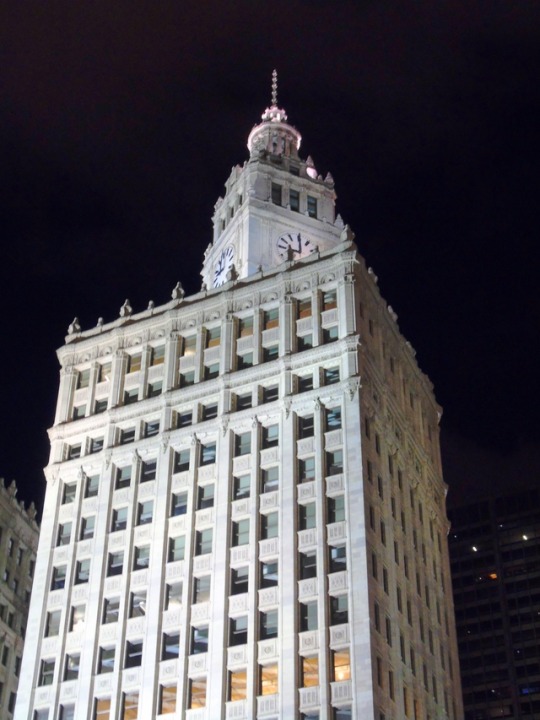
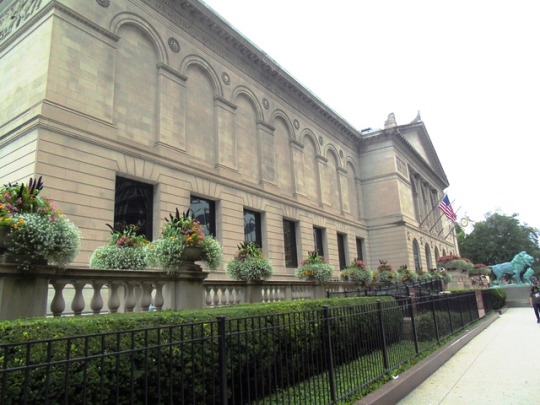





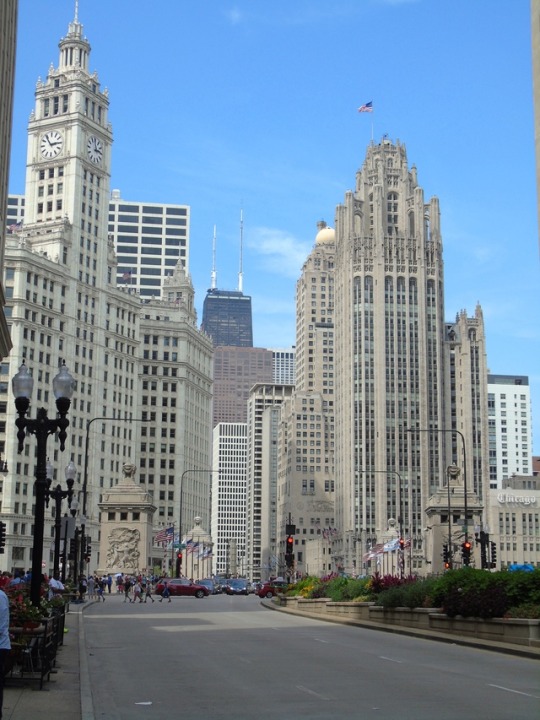


Michigan Avenue, Chicago (No. 6)
The Historic Michigan Boulevard District is a historic district in the Loop community area of Chicago in Cook County, Illinois, United States encompassing Michigan Avenue between 11th (1100 south in the street numbering system) or Roosevelt Road (1200 south), depending on the source, and Randolph Streets (150 north) and named after the nearby Lake Michigan.It was designated a Chicago Landmark on February 27, 2002.[1] The district includes numerous significant buildings on Michigan Avenue facing Grant Park. In addition, this section of Michigan Avenue includes the point recognized as the end of U.S. Route 66. This district is one of the world's best known one-sided streets rivalling Fifth Avenue in New York City and Edinburgh's Princes Street. It lies immediately south of the Michigan–Wacker Historic District and east of the Loop Retail Historic District.
Today the only building on the eastern side of Michigan Avenue in the Historic District hosts the Art Institute of Chicago. However, several interesting structures have been added to the northern part of the eastern side of Michigan Avenue in Millennium Park such as Crown Fountain and McCormick Tribune Plaza. The current "End Historic US 66" marker is now located along Michigan Avenue in this district to mark the official end of U.S. Route 66 in Illinois, but this and several others traverse Michigan Avenue within Grant Park because landfill has created two blocks of real estate between Michigan Avenue and the Lake Michigan shoreline. Also, the Fountain was relocated and is no longer easily seen from Michigan Avenue.
Among the current issues today is the trend to redevelop properties by constructing grand towers behind the facades of historic structures along Michigan and Wabash Avenues (the parallel street one block to the west). The most recent examples of this have been The Heritage at Millennium Park, Legacy at Millennium Park and the 80-story tower proposed as part of the YWCA building redevelopment at 830 S. Michigan Avenue. This trend is now endangering the Chicago Athletic Association Annex, which has been proposed for demolition to make way for a fifty- to eighty-story condominium tower across from Millennium Park. As a result, the building is listed first on the 2006-07 Chicagoland Watch List of the Landmarks Preservation Council of Illinois. On the other hand, many were concerned that the landmark district designation would stagnate development of the area. The purpose of the designation was to "keep the architecture there and encourage architecture like it and keep the wall of the park," according to the City's Department of Planning and Development. Thus, redevolpment for new uses will be part of the ongoing concerns for the neighborhood. Thus, buildings being renovated for condos and dormitories is a part of the present and future for the district.
Several of the buildings listed below have played a prominent role in the cultural history of Chicago.
The Blackstone has become part of Chicago's history as the city that has hosted more United States presidential nominating conventions (26) than any other two American cities. The Blackstone Hotel has hosted almost every 20th century U.S. President, and it has contributed the phrase “in a smoke-filled room" to American political parlance.
The Chicago Symphony Orchestra debuted on October 16, 1891 and made its home in the Auditorium Theatre until moving to Orchestra Hall in 1904. Theodore Roosevelt gave his famous Bull Moose speech in 1912 at the Auditorium and was nominated for President of the United States by the independent National Progressive Party. The Auditorium has hosted Jimi Hendrix, The Who, the Grateful Dead, and many others. The Auditorium Building is considered a milestone in the development of modern architecture.
The Chicago Cultural Center serves as the city's official reception venue where the Mayor of Chicago has welcomed Presidents and royalty, diplomats and community leaders. According to Crain's Chicago Business, the Chicago Cultural Center was the eighth most-visited cultural institution in the Chicago area in 2004, with 767,000 visitors. The interior includes ornate mosaics, marbles, bronze, and stained-glass domes designed by the Tiffany Glass and Decorating Company.
The Art Institute of Chicago is a fine-art museum well known for its Impressionist and American art.
Source: Wikipedia
#Michigan Avenue#Wrigley Building#Tribune Tower#DuSable Bridge#Michigan Avenue Bridge#flag#nightshot#daylight#John Hancock Center#architecture#cityscape#The Art Institute of Chicago#flower#blooming#the bean#The Cloud Gate#Anish Kapoor#public art#reflection#505 N Michigan Avenue#crown fountain#Jaume Plensa#chicago#usa#summer 2016#travel#photography#photoset#Historic Michigan Boulevard District#Illinois
7 notes
·
View notes
Text
Exhibition Proposals: the Basics (in progress)
Who is involved? Describe your intended work
Eleanor Díaz Ritson -
I will make large, water-based oil paintings on suspended, ‘patchwork’ cotton duck canvas. Painted tapestries (2 artworks: 98.4 x 120 cm each). I use a non-traditional oil painting style, influenced by raw material, charcoal drawings , woodcuts, and other traditionally water-based media. I am a figurative painter, representing my own image to communicate through gesture and expression.
I explore sociality as a land-space-place; the tangible body as land, and the intangible social culture as space–place. In this way, the outward expressions of force applied in social interactions are likened to the movements of energy that sculpt geological land-bodies. Through evolutionary ‘deep time’, our social interactions sculpt our bodies and minds too.
She exists in an interior landscape. A space where She is:
Dew dripped mountain crag. Squelching, slimy swamp. Beaten and carved cavity. Patient, molten core.
Rippling ash cloud. Salt scarred cliff face. Frozen and glistening glacial shard.
Ruby Wilkinson -
I intend to make paintings from memories, learning more about the unconscious. Memories are constantly changing, moving and evolving in people’s minds; creating endless false realities and recollections. I want to make work about social interactions, experiences, encounters and moments I have personally experienced in my life.
Two large scale paper drawings, 150cm x 100 cm. Using abstract drawing techniques combined with paint manipulation of paper there will be a balance of chance and control.
Steph Arrowsmith -
I intend to create large- scale prints which float in the space between figuration and abstraction and subvert traditional processes of image reproduction. I am exploring the potential for the prints being integrated with strange acid- etched sculptural metal frames.
I am influenced presently by early print imagery which depicts dark religious fantasies of apocalypse and doomsday, and the artificial realities constructed through reproduced colonial imagery of endemic avifauna, flora and landscape. I want to explore ideas around the fragile and intricate biosphere in the in-between space of devastating degradation and utopic regeneration, phenomena and noumena, and ghosts of past and apparitions of future coexisting as unseen undercurrents of accepted material reality.
Trantham Gordon -
The work that I intend to continue working through explores the redevelopment of image and SPACE. The sculptural object contains the tools to create a reconstruction of the world surrounding it, as the surroundings contain movement, so in turn, does the image.
In reality this object is a camera (built out of several cameras amongst other technologies).
The use of these technologies create a pulsating energy -through delay and feedback loops- which imbue into the image a warmth and life - a result that stands apart from the puppeteering and facade of life created by animation.
I am influenced by a continued exploration of our understandings of SPACE and LINE and IMAGE as well as the existence of time within an artwork. The final work should be able to reproduce a moving image of the world in front of it whilst commenting on the deconstruction and reconstruction of the image shown and seen.
Christian Dimick -
I intend to make medium scale conceptual drawings on wood panel. Through using a range of direct mediums such as oil stick, charcoal and found object I aim to dictate personal idiosyncrasies of perception and memory. The starting point for these drawings is always walking, which translates into experimental documentitive language and then finds its way into a visual form. I am infl]uenced by other artists/writers who use walking as a means of understanding space, time and connecting narrative with objects such as Susan Solint, Richard Long and Stanley Brouwn.
What is the concept for the exhibition? What ideas does it explore, what are its reference points?
Our exhibition could be seen as the creation of a materially represented limbo, a between space neither here nor there, in which time and material solidity loses its hold on accepted perceptions of reality. Memories of past and apparitions of future intermingle in a strange fog. The exploration of this space between nothing and something echoes and amplifies the seething atmosphere of this moment of existence, in which we seem to gaze into a chasm, a darkness which could be full or empty, beneath feet run unutterable undercurrents which disrupt and destabilise.
The work and the intended space cohabitate conceptually in symbiosis. The space is an entrance and exit point, a through- space, a solid, architectural in-between. We intend to explore unconventional lighting and installation , using the limitations of the non- gallery space as an opportunity to break with convention and influence what we create. This space is the mouth to the vast expanse of the great hall, which will be empty and filled with darkness. The acoustics of this space create a dense silence which will be a potent atmospheric facet.
Trantham: Space, time, movement, object, line, light.
Christian: Space, time, movement, object, perception, memory.
Steph: Space, time, movement, land, energy, degradation, regeneration, creature.
Eleanor: Space, time, movement, land, energy, sociality, figure, eternal.
Ruby: Space, time, movement, sociality, memory.
UNDESCRIED
Definition: not descried; not discovered; not seen.
Examples:
1. It seemed to the man and woman that they were the only living things in the world, its people, its sounds, its interests, were in some undescried distance where life progressed with languid pulses.
- The Emigrant Trail
2. Fade from suns to stars, from stars into darkness undescried.
- A Channel Passage and Other Poems Taken from The Collected Poetical Works of Algernon Charles Swinburne—Vol VI
MOVEMENT
Definitions:
1. The act of moving in space; change of place or posture; motion.
2. Motion of the mind or feelings; emotion.
3. The suggestion or representation of motion in a painting, sculpture, or design.
4. A particular rhythmic flow of language (CADENCE a poem's movement).
LACUNA
Definition:
1. An unfilled space; a cavity or depression; a gap.
2. A language gap, which occurs when there is no direct translation in the target language for a lexical term found in the source language.
Unseen/between spaces
Deconstruction and reconstruction
Layers/ undercurrents of reality
Individual perception
Sensorial perception
Quotes:
Henry Moore
“The mystery of the hole - the mysterious fascination of caves in hillsides and cliffs."
“One of the things I would like to think my sculpture has is a force, is a strength, is a life, a vitality from inside it, so that you have a sense that the form is pressing from the inside trying to burst or trying to give off strength from inside itself.”
"I admire most a disturbing element, a distortion, giving evidence of a struggle . . . . In great art, this conflict is hidden, it is unresolved. All that is bursting with energy is disturbing - not perfect."
“Turner can create almost measurable distances of space and air… The space he creates is not emptiness; it is filled with 'solid' atmosphere.”
W. J. T. Mitchell - Landscape and Power
“An empty space is not the same thing as an empty place. An empty place is filled with space, as if space were the negative void that rushes in when a place is vacated. It is the spectral absence that “fills” a hollow shell or a clearing in a forest.”
"Landscape exerts a subtle power over people, eliciting a broad range of emotions and meanings that may be difficult to specify. This indeterminacy of affect seems to be a crucial feature of whatever force landscape can have.”
“I aim to change “landscape” from a noun to a verb. (to describe an action, state, or occurrence) It asks that we think of landscape, not as an object to be seen or a text to be read, but as a process by which social and subjective identities are formed.”
Steph -
Bennet, Jane, ‘Vibrant Matter: A Political Ecology of Things’, 2009, Duke University Press
2009,
Janet Frame ‘Owls Do Cry’, 1957
Böhme, Gernot, ’The Aesthetics of Atmospheres (Ambiances, Atmospheres and Sensory Experiences of Spaces)
Wynyard, Mathew, ‘Dairying, Dispossession, Devastation: Primitive Accumulation and the New Zealand Dairy Industry, 1814- 2018, Counterfutures 8, 2019, Rebel Press, Wellington
Eleanor -
de Certeau, Michel. The Practice of Everyday Life. University of California Press, 1984.
Finn, David. As The Eye Moves… a Sculpture by Henry Moore. Words by Donald Hall. Henry Abrams Inc. Publishers, 1970, New York.
Langer, Susanne K. Feeling and Form, A Theory of Art. Routledge & Kegan Pail Limited, 1953, England.
Lefebvre, Henri. The Production of Space. 1971. Translated by Donald Nicholas-Smith, Blackwell, 1991.
Mitchell, W. J. T, editor. Landscape and Power. The University of Chicago Press, 2002.
Parker, David. Myth and Landscape. Words by Marina Warner and Ibrahim al-Koni. Kehrer Verlag, 2014.
Fehr, E. & Gächter, S. 2002 Altruistic punishment in humans. Nature 415, 137-140. (doi:10.1038/415137a)
Jensen, K. 2010 Punishment and spite, the dark side of cooperation. Phil. Trans. R. Soc. B (2010) 365, 2635-2650. (doi:10.1098/rstb.2010.0146)
Ruby -
Frichot, Hélène, ‘Olafur Eliasson and the circulation of affects and percepts in conversation’,2008
Moon So - Young, ‘Yun Hyong-Keun, retrospective abstract landscape of silence and sublime.’ 2018. Korean culture & arts
Böhme, Gernot, ‘Atmosphere, a basic concept of a New Aesthetic, In Atmospheric Architectures: The Aesthetics of Felt Spaces Chapter 1 pp 13 -35,’. (2017)
Pallasmaa, Juhani, ‘The meaning of Atmosphere and mood’. 2016
Trantham -
Arke, Pai. Nuugaarsuk alias Hulkamerafotografi alias Pointen (Nuugaarsuk alias Pinhole Camera Photograph alias The Point), 1990, silver/ gelatine on baryte paper print of Nuugaarsuk Point, Narsaq, 49.5 x 59.5 cm; collection of Brandts Museet for Fotokunst, Odense.
Alÿs, Francis. Bolero (Shoe Shine Blues), 2008. Video Work and Installation
Lefebvre, Henri. The Production of Space. 1971. Translated by Donald Nicholas-Smith, Blackwell, 1991.
Bachelard, Gaston. The Poetics of Space. 1954. Translated by Maria Jolas, Beacon Press, 1994.
https://sites.evergreen.edu/wp-content/uploads/sites/88/2015/05/Gaston-Bachelard-the-Poetics-of-Space.pdf
Mariana Bisti, Future Proof, 2015. Performance Piece
Christian -
Art In America: ‘Provisional Painting’, Raphael Rubinstien, 2009
Susan Solint, ‘A Field Guide to Getting Lost’, published 2006 Donald Judd, ‘Specific Objects’, Donald Judd: Early Work, 1955-1968, New York: D.A.P., 2002.
Images: what might be shown, conceptual drawings of what the exhibition might look like…
Identify the site for the exhibition and whether secured or aspirational. How does the site relate to the concept for the exhibition?
We are all making primarily wall-based, large scale works. This means we require a spacious exhibition area. We recognise all work as boldly individual, while supporting and enriching one another’s expressions through our various perspectives and interpretations.
First Choice: Block 10 Great Hall (10B09)
This space ties together our overarching concepts around sensory and individual perception in relation to space/place/time. The group wanted to use a space that pushed our practices out of the standard gallery setting, in our case the space becomes part of each of our works as they respond to its unique qualities such as size, lighting, reverberation and ambience.
Second Choice: 10A19 This space is also suitable for our group as it is large enough to fit all of our works.
How will the team work? Are there any organising principles? Are there prescribed roles/duties or are you organising yourselves in a different way?
We have no defined ‘leader’, instead we are supporting each other in sharing organisation tasks throughout the process. Concurrently we will work independently on our own projects, while frequently communicating our progress and artwork developments to one other.
A timeline: what needs to be done and by when?
Once we have secured an exhibition space, we will be able to plan further (layout, lighting, install).
In the meantime we will continue to work independently.
All works will be completed and ready to be installed before exhibition night (Friday 11 September).
TEXT FOR EXHIBITION DOCUMENT
Ruby
Forge the doctor note to get the night off work. Drive in silence. The car knows where to go. It drives so smoothly in fact it’s almost floating now. Bottle it up one more time and leave no residue until the final destination is reached. Listen to the noise and notice the patterns, Listen to the layers of skin. There is a warehouse filled with ammonium nitrate (2750 tonnes). Untangle the inner threads. Do not feel the need to explain yourself today they will understand. Put some lemon on the crumbed fish and allow the sand to fill up under your fingernails for protection. Share the space you have created but allow it to be tampered. Think about the lotto today, Call your mother. Prepare the surface for one week and allow it to breathe before applying the layers. Think about it again and again. Apply the layer of milk, Let the milk fill the void of silence. Relive the memory over and over in order to pay respect. Allow the memory to become distorted with the following factors; Schemas, Source amnesia, The misinformation effect, The hindsight bias, the overconfidence effect and confabulation. The arch will be there, swim within the milk.
Watch the paroxysm from a distance.
Christian
I step forward and open cognition, up two sets of stairs, under the lip of the earth.
Slip into mandatory nostalgia,
listen to the resonance of air.
Consolation in degradation, in memory afar. I step forward and open cognition, up hill ridges to watch the deep.
Having sympathy for surface, letting the hand relive the step.
Leave space for the solitary eye, but do not let it drag, keep moving. Locomote and arrangements will be made in the equilibrium. Represent singular impressions,
And their histories, all marks made before. I step forward and open cognition.
0 notes
Text
10 To Watch : Mayor’s Edition 2320
RICK HORROW’S TOP SPORTS/BIZ/TECH/PHILANTHROPY ISSUES FOR THE WEEK OF FEBRUARY 3 : MAYOR’S EDITION
with Jacob Aere
Super Bowl LIV is in the record books, but celebrations in Miami continue. On Monday night, HSBC and Rick Horrow present SportBusiness 50: Lessons And Leadership From Legends Of The Game. The event, held at the University of Miami, features panelists including Dolphins Vice Chairman Tom Garfinkel, NFL Hall of Fame President and CEO David Baker, and RISE CEO Diahann Billings-Burford. The “Lessons And Leadership” Series will draw on contributors to Horrow’s latest book, The Sport Business Handbook: Insights from 100+ Leaders Who Shaped 50 Years of the Industry. The collaboration between HSBC and Horrow kicks off in Miami, focusing on the greatest moments in South Florida sports history and how technology has disrupted the industry. “We are always looking for new and interesting ways to connect with our clients and support their personal and professional growth,” said Michael Rogan, Head of Corporate & Strategic Partners, Retail Banking and Wealth Management, HSBC USA. “Collaborating with Rick on the launch of his new book provides us with an exclusive platform to share insights, perspectives and solutions from luminaries in the sports industry that will help support the long-term business success of our clients and prospects.” We will share the top “greatest moments” next week.
A new report predicts that sports sponsorship spending will increase the most it has in a decade. Global spending on sports sponsorships by advertisers is predicted to total $48.4 billion this year, up 5%, according to a new report from marketing intelligence firm WARC. The 2020 Summer Olympics in Tokyo is expected to garner $5.94 billion in sponsorship dollars, with $1.95 billion coming from Olympic partners including Coca-Cola and P&G, double the amount sponsors spent at the previous games. The report also predicts that local sponsors in Japan including Canon, Asahi, and Fujitsu will spend $3.33 billion, four times the amount spent during Rio's 2016 games. The report also forecasts that brand investment in esports will total $795 million this year, up 23.1%, with $584 million going to sponsorships and $211 million to ad breaks. Further, NBC projects that the Summer Olympics in Tokyo will set a record by surpassing the $1.2 billion in TV commercials it sold during 2016 games in Rio de Janeiro, per Front Office Sports. The network has already booked $1 billion in ad revenue commitments, and the Games are still five months away.
Tokyo 2020 organizers enter the final stretch of a decade of Olympics planning. According to Japan Today, the organizers are dealing with fewer issues than their counterparts did in the build-up to Rio four years ago. But a few challenges still remain before the opening ceremony on July 24, including the city's notoriously hot summer weather. "Everything is coming together now, and we are extremely excited," Tokyo 2020 spokesman Masa Takaya told Reuters. "It has been a long journey, with some bumps here and there, but for the most part everything has gone well. Everything is where we wanted it to be with six months to go – sometimes in an even better place." Noticeably different from Brazil is the weight of public support behind the Tokyo Games, with almost 4.5 million Olympics tickets having already been sold on the domestic market. By contrast, the Rio Olympics were met with widespread criticism over the use of public funds, as money was poured into venues that have since largely become white elephants. The centerpiece of Tokyo's Olympics is the 68,000-capacity National Stadium, opened by Prime Minister Shinzo Abe in December.
A U.S. House of Representatives resolution targets minor league contractions in baseball. Less than two weeks before major league pitchers and catchers are due to report to spring training on February 12, a group of U.S. representatives led by Lori Trahan (D-Mass.) have introduced a resolution imploring MLB to "abandon its proposal to strip major-league affiliation from 42 minor-league teams across the country." The bipartisan legislation, according to the Boston Globe, is an "outgrowth of the 'Save Minor League Baseball' Task Force formed late last year." The measure is "non-binding, but after being assigned to a committee, the sponsors' goal will be to bring the measure to the floor of the chamber for a full House vote." Approval is "not guaranteed but the bipartisan support suggests passage would be more likely than not, an outcome that could stiffen headwinds MLB is already facing” in its talks with MiLB over a new working agreement. As baseball season inches closer and the 2020 elections heat up, look for more candidates nationwide to come out in support of MiLB and what it means to our communities.
The PGA Tour announced that the Tour and its tournaments have surpassed $3 billion in all-time charitable giving. The charitable total, which includes a record $204.3 million in 2019 to bring the all-time total to $3.05 billion, includes donations made by tournaments on the PGA Tour, PGA Tour Champions, Korn Ferry Tour, Mackenzie Tour-PGA Tour Canada, PGA Tour Latinoamérica and PGA Tour Series-China. “It’s truly a pleasure to thank our fans, sponsors, tournaments, players and volunteers for helping us generate over $3 billion for charity and positively impact millions of lives,” said PGA Tour Commissioner Jay Monahan. “Together, we look forward to continuing to reach – and celebrate – millions more.” That’s an impressive number – as is the winner’s take just announced for the 2020 Players Championship. The PGA Tour, according to the Florida Times-Union, has “boosted the purse" for the event to $15 million in total and restored it to its "position as the tournament with the richest purse in golf.” The 2020 winner will take home $2.7 million, up from $2.25 million for the 2019 event won by Rory McIlroy.
Snapchat promotes its ability to reach millennials and Gen Z during March Madness. While everyone else’s mind is on Super Bowl LIV, Snapchat is focused on March Madness. According to Snap Inc. internal surveys, as reported by Hashtag Sports, nearly 75% of Snapchatters who intend to watch the 2019-2020 NCAA Men’s Division I Basketball Championship use the messaging application while watching live sports. Additionally, over 65% of that group will use Snapchat to chat with their friends about the games. Snapchat saw incremental reach up 23% on average among its advertisers’ target audiences, according to Nielsen, and 72% of the app’s Gen Z reach was not reached by TV. Snapchat concluded, “Marketers can look forward to March Madness on Snapchat in 2020 because of the hyper-relevant content on our platform, Snapchatters’ engagement during live sports events, our proven ability to add incremental reach to TV advertising and the strong performance advertisers saw during March Madness in 2019.” Reaching a desirable young demographic, clearly, is a snap.
SoFi Stadium builders said that the venue is 85% complete, but "finishing touches will take up much of the construction horde's remaining time" before the Inglewood venue opens in late July. Rams Executive VP and COO Kevin Demoff told the Associated Press, "Everybody here feels confident about the timeline and how it will come together. There's been no indication to us that there's been any slippage." The Rams and Chargers will take advantage of the stadium's "late-summer concerts and their own preseason games to work out any quirks or adjustments before the regular season begins." The 298-acre Hollywood Park development surrounding the stadium will "take longer to complete, although construction is already underway on the 450,000-square-foot building that will house NFL Media" beginning in 2021. Crews also are "currently building the stadium's translucent roof, with roughly 40% of the panels already in place." USC School of Architecture Associate Professor Alvin Huang said, "They're going against the historic convention of stadium design where it is a closed roof or a retractable roof." He added, "You will literally have millions of people looking at it from above. The roof not only becomes an architectural signature, it also becomes a branding signature."
YouTube and Google sign an exclusive streaming deal with esports Activision Blizzard. According to The Verge, video game publisher Activision Blizzard will see the Google cloud platform power all of its game hosting and technical needs. As part of the deal, YouTube will become the exclusive streaming partner for all of the game publisher’s big e-sports titles, including the upcoming season of the Overwatch League and the Call of Duty League. The deal is a huge win for YouTube, which has struggled to compete with game streaming leader Twitch, despite YouTube being the largest video site in the world and the second most-visited website on the planet behind only its parent company’s search engine. Twitch has long been the go-to destination for live gaming entertainment. In the larger esports streaming context, it’s Amazon-owned Twitch competing against Google-owned YouTube, while Facebook is also trying to build out its own live-streaming platform to capitalize on the popularity of gaming content. It is only a matter of time before other big streaming players, such as Disney, HBO, and Netflix try to get more involved in the live-streaming and gaming spaces, so Twitch and YouTube need to solidify their foothold on the new industry quickly
The NBA makes major All-Star Game format changes that include a tribute to Kobe Bryant. According to Larry Brown Sports, the 2020 NBA All-Star Game will be broken into a series of mini-games in which teams can raise money for Chicago-area charities. Scores will be reset to 0-0 at the end of the first three quarters, with the winners of each of the first three quarters receiving $100,000 to donate to their charity. When the fourth quarter begins, the scores for each team from the first three quarters combined will be redisplayed, and the team that wins the All-Star Game will be the first to reach a target score in the untimed fourth quarter. That target score will be determined by the total score the leading team through three quarters, plus 24. The 24 is a nod to Bryant’s jersey number. The final score is worth $200,000, making the total game worth $500,000 for local charities. If one team leads the entire way through, the losing team will still get $100,000 to donate to its charity. In an effort to honor Kobe Bryant and contribute to local charities, the NBA will make sure to place the Lakers star center stage during this year’s All-Star game.
Adidas will launch new fabrics from recycled polyester and ocean plastic. According to Reuters, the new fabrics will be expanded into Adidas product lines after the success of shoes made with the eco-friendly Parley for the Oceans initiative. Adidas first teamed up with Parley in 2015 and gradually ramped up production of shoes using plastic collected on beaches and coastal regions to make more than 11 million pairs in 2019, still just a fraction of a total of more than 400 million shoes. The Ellen MacArthur Foundation says less than 1% of material used for new clothing is recycled, a loss of more than $100 billion worth of materials each year. Adidas will continue to make Parley-branded shoes and clothes out of ocean plastic in 2020 and will also launch “Primeblue” fabric containing Parley marine waste that it will use in existing lines like its popular Ultraboost shoes, with the aim of having 100% of its polyester recycled by 2024. In total, the German sports giant will produce 15-20 million pairs of shoes using ocean plastic in 2020. While recycled polyester costs about 10% more than the other material, Adidas ultimately wants to get the price down so more consumers can afford to choose sustainable products and help save the planet.
0 notes
Text
April and Joe’s Wedding Story
Here is a play-by-play for those who were unable to attend the wedding.
Being a gigantic comic book fanatic, Joe proposed to April at the Chicago Comic and Entertainment Expo on March 19, 2016. During the convention, their friends and family all wore costumes and held up signs that said “APRIL WILL YOU MARRY ME?”
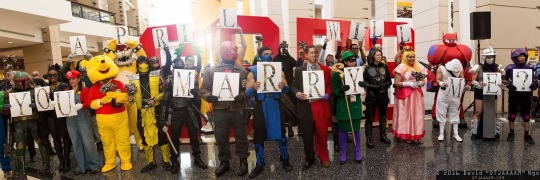
Prior to that date, Joe continuously worked with a jeweler Adam to custom design April’s engagement ring with the theme of “two lives becoming one.” The idea was to have two bands becoming one band as well as having the two ends encircle the diamond. Unintentional in design, the top view of the ring ended up showing a heart.

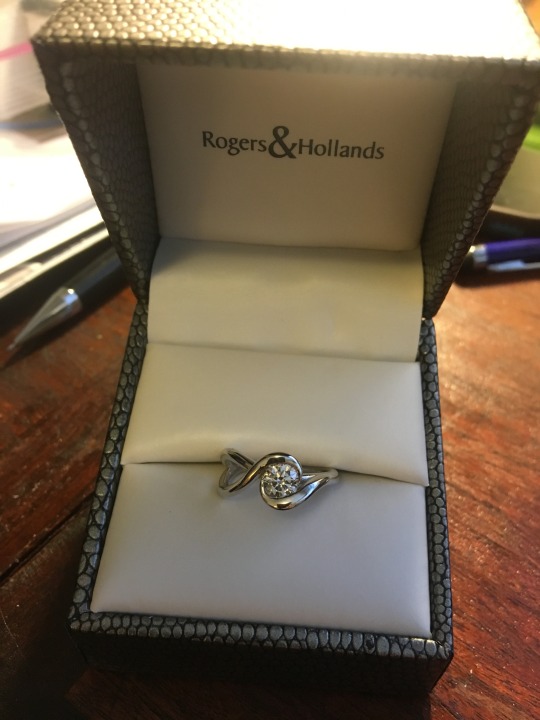
As all great stories go, she said “Yes!”
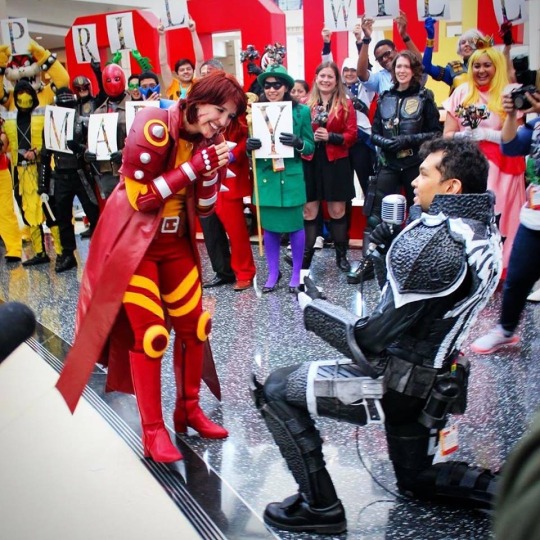
For those who wanted to see the proposal, here is a video of its entirety at the comic con. Please click on this LINK
Fast Forward to 2017 Wedding Planning!
One day, April and Joe were visiting a local comic book store and found a giant box of give-away comic books. In speaking with the manager, he agreed to give them the entire box of unsold comics, in addition to giving them more free boxes of comic books in later months. All these comic books would later be turned into various comic book decorations.
Comic Book Hearts
Their friends cut strips of poster board and modge podged them with comic book paper. The strips were then bent into heart shapes and clear fishing wire was attached to each so the hearts could be hung from the chandeliers in the room.
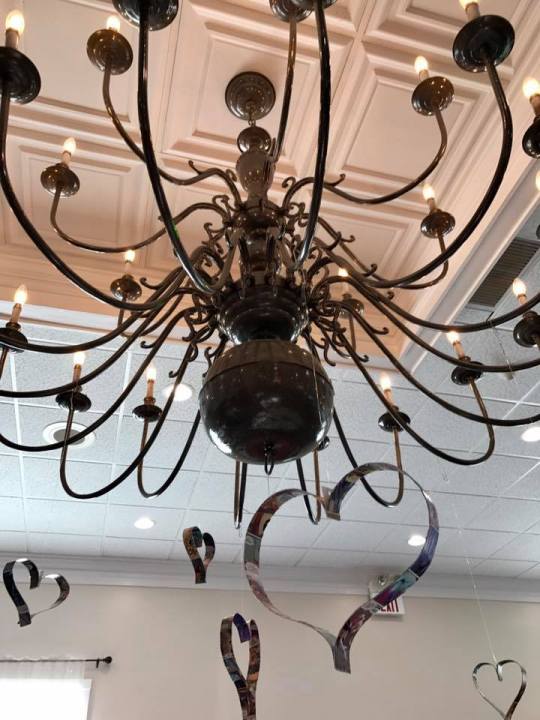
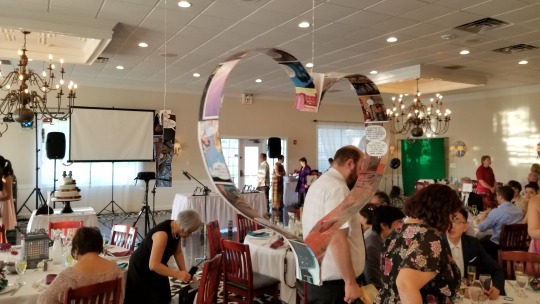
Comic Book Signs
April’s mom used her handy dandy Cricut machine to cut out hundreds of comic signs in various colors and sizes. April’s dad and friends took black paint marker and outlined each sign to accentuate them. Signs had various action words written on them as well.
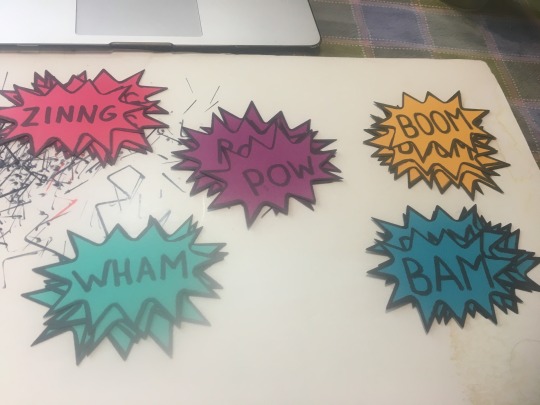
Signs were then glued onto sticks and poked into circular foam “coasters” that were modge podged with comic books.
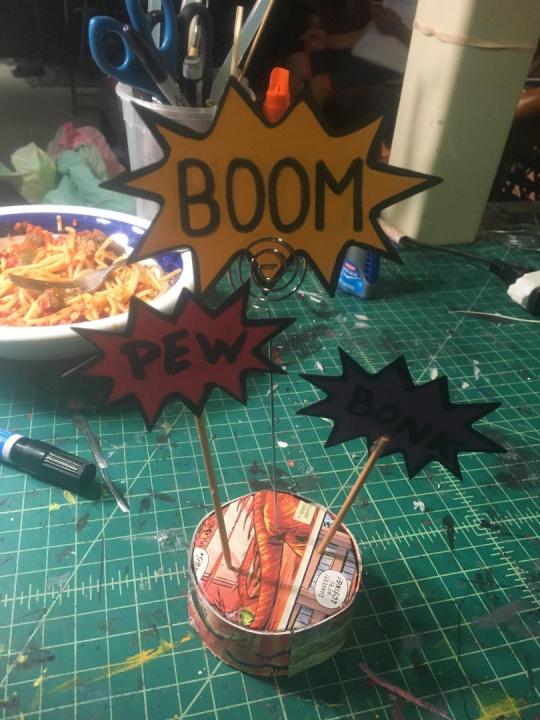
The smaller signs were used as seating charts.
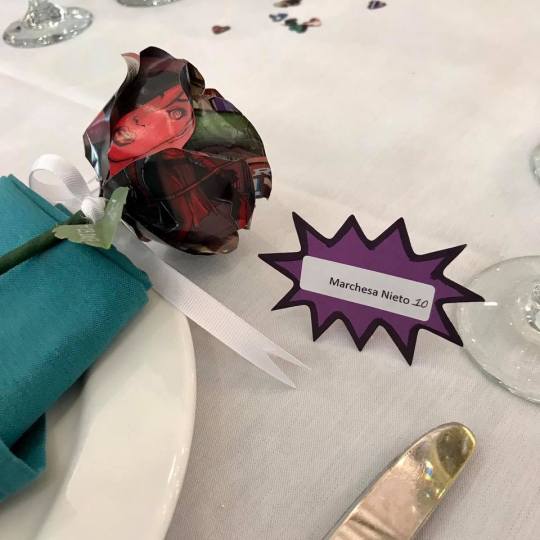
“Mr & Mrs” Sign
During the prior months before the wedding, Joe’s parents were replacing their kitchen so he took the drawers and April’s dad dismantled them.
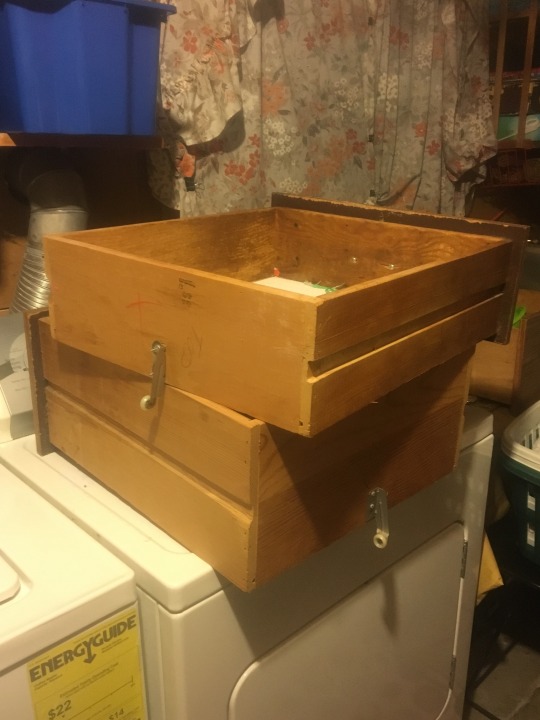
Joe drew the “Mr & Mrs” shapes on the boards and April’s dad meticulously sawed each of the words out and made holders for them.
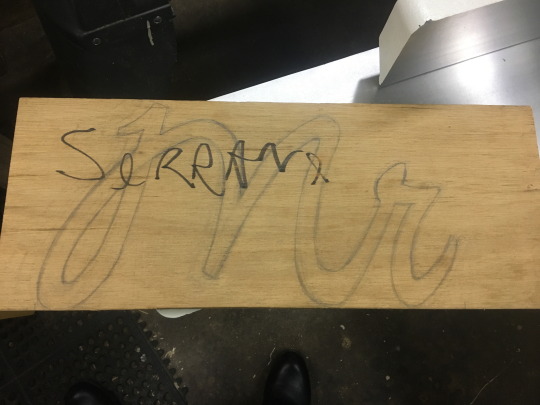
April and her mom then took comic books and modge podged each of wood pieces.
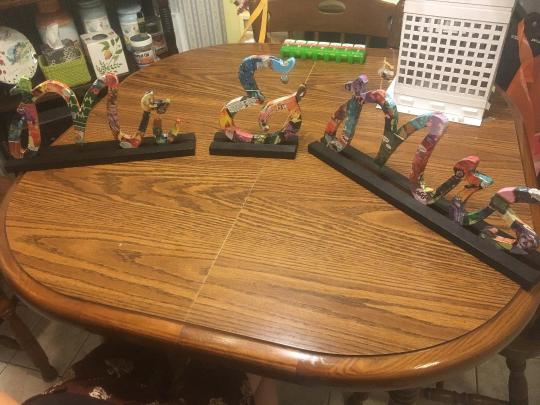
Flower Girl Basket
April’s mom created basket for April’s niece- the flower girl.

Flowers
Lilies
Joe taught his mother, April, and several friends how to fold the comic books into origami lilies of varying sizes.
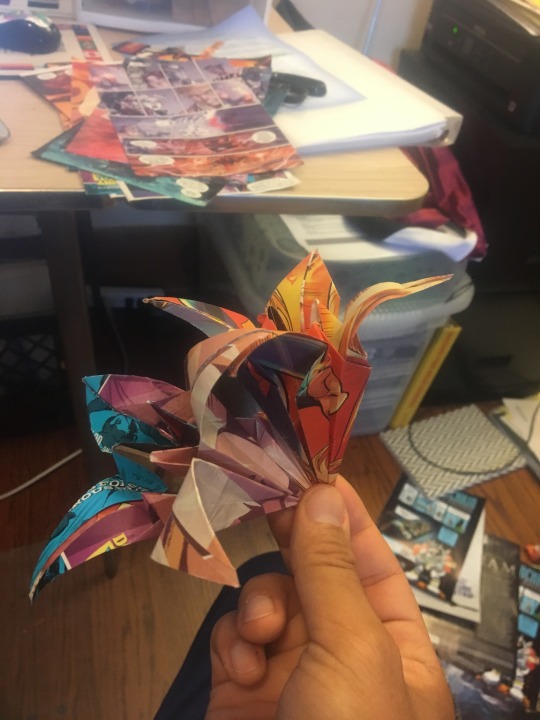
Each comic lily was hand glued by Joe’s mother onto tree branches that were cut by April’s father from their home in central Illinois. Green paper leaves were cut out and also glued onto the branches for accent.

The branches were then wired together and placed in 6 vases with colored ribbon.

Comic Book Rose Wedding Favors
From the plethora of free comic books, Joe’s mother spent countless nights searching, cutting out, gluing, and shaping each petal in order to create over 230 comic book rose wedding favors. Joe’s friends Stephen and Tori graciously helped him cut out leaves and write the names and wedding date.
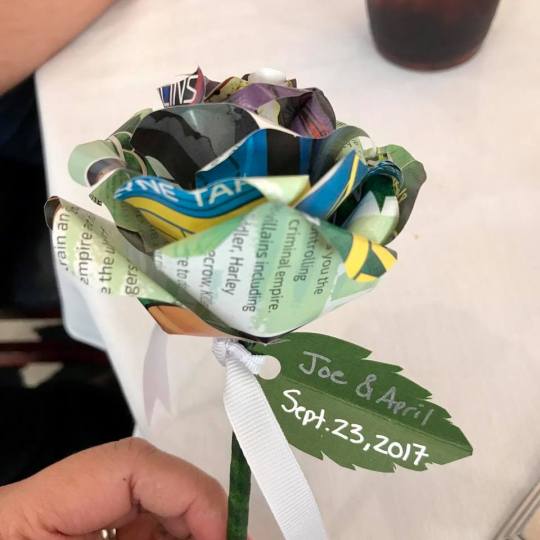
Bamboo Flowers
Joe’s mother repeated the same process and glued the petals to curved bamboo skewers in order to create 100+ bamboo comic book roses.

These flowers were then used for making various wedding decorations: cans, cake flowers, and decorations for ceremony chairs & gazebo.
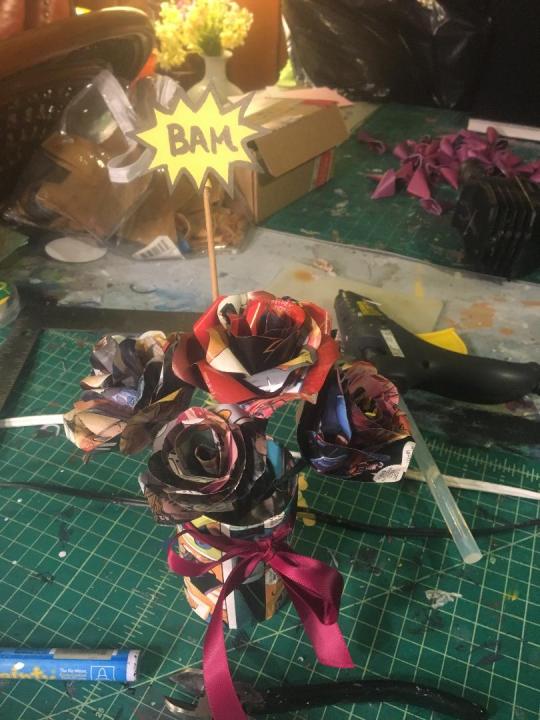
Gazebo flowers
Joe’s mother also created flower arrangements from giant origami kusudama flowers, comic lilies, and comic roses that would attach to the pillars of the gazebo. Long floral vines attached to them and then met at the center of the gazebo where April’s dad had created a custom designed wooden cross for them.

Cross
Joe and April had made a special request that April’s father create a cross for the ceremony to be hung above them. This beautiful piece of work was created from hard maple and walnut.

Wishing Well
Joe’s mother made the wishing well out of three boxes and decorated it with some wedding paper, ribbon, some reused flowers from another friends’ wedding, and previously mentioned comic flowers.

Bridal Party
For their wedding, Joe and April chose 5 groomsmen and 5 bridesmaids. Each bridal pair was assigned a specific color: Purple for the bride and groom, and then Blue, Orange, Light Blue, Green, and Red for the others. The bridesmaids wore jewelry, shoes, make up, nail polish, and a parasol in their designated color. The groomsmen were given a tie, pocket square, cufflinks, and converse Chuck Taylors (Joe’s favorite shoe) in their designated color to wear during the reception.

Boutonnieres
Joe’s mother searched through the mountain of free comic books to find the appropriate colors to handmake each boutonnière for his groomsmen and him. She also made comic book boutonnieres and corsages for herself and Joe’s father, April’s parents, April’s grandfather, and Joe’s childhood friends who would give speeches at the reception.

Bridal Bouquets
For the bridesmaids, they created paper bouquets in each of their designated color. The two tones of color per bouquet were origami Kusudama flowers, in addition to white origami Kusudama flowers. A little clear bead was also glued into the center of each kusudama and green floral tape was wrapped around each bamboo stem. Small comic origami lilies, designated color roses, and green paper leaves were inserted to fill in the gaps. A 7th bouquet was created using all the colors for the bouquet toss at the wedding reception.

April’s purple bouquet was a cascading style arrangement that used purple tones and shiny white paper to create origami kusudama flowers. Clear beads were glued to the center and long vines were attached to give the bouquet a cascading look.

Tall comic cylindrical containers with a complementary colored ribbon were also created to house each bouquet. During the wedding reception, the cylinders and the bouquets were placed around the sweet heart table.
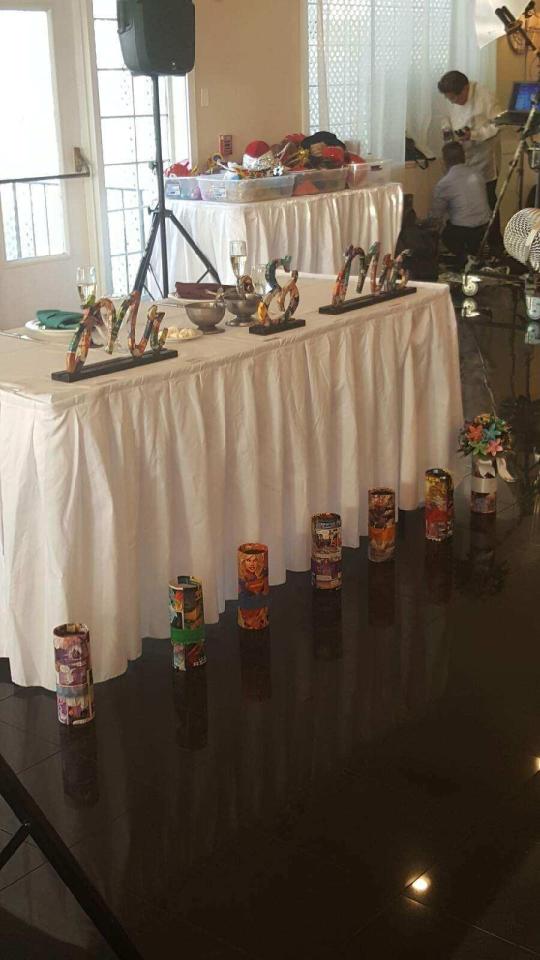
Cake Topper
Joe finished the wedding topper around 12:30am the night before the wedding. The deal between April and Joe was that if he was not allowed to see April in her dress prior to the wedding, she was not allowed to see the wedding cake topper he would create for them.

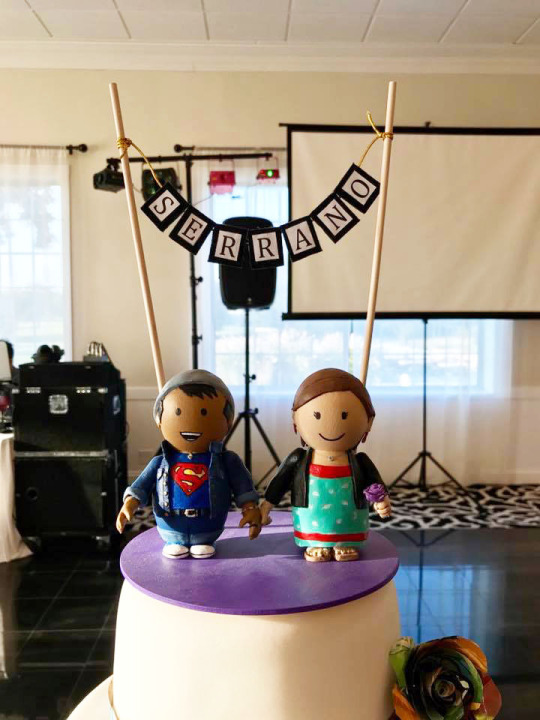
These cake toppers were modeled after outfits that the two typically wear. April’s father created the wooden platform while Joe sculpted these figurines from two wooden dolls and clay.
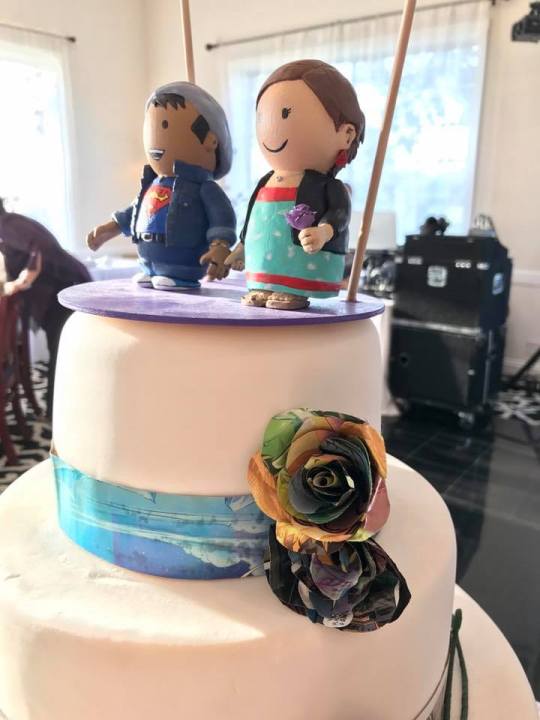
The delicious 3-tiered vanilla flavored cake was wrapped with strips of comic book paper and then decorated with several of the flowers that Joe’s mother had hand-made for the wedding.
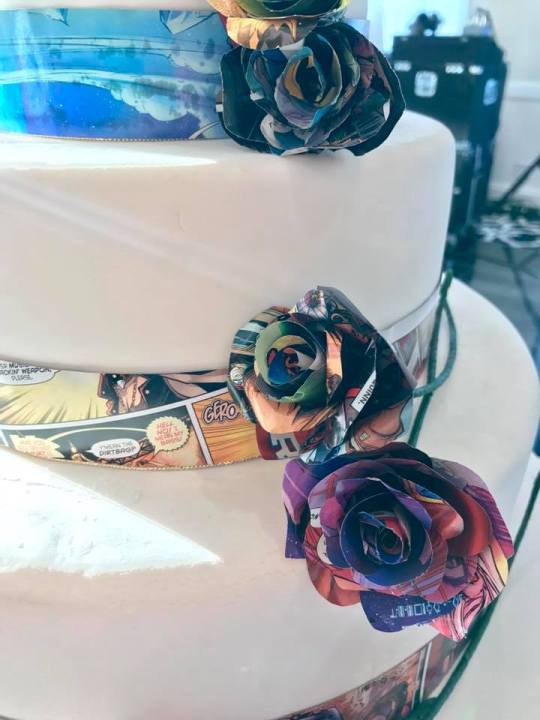
Table Centerpieces
Joe handmade 20 comic book themed centerpieces for the wedding with the help of his childhood friend Matt. Each centerpiece had a brief explanation on the opposite side of the table number. Each centerpiece was also able to light up with the use of an electric candle or electric tea light. Comic book confetti in the shape of hearts was sprinkled around each centerpiece.
Table #1 - DAILY PLANET
Daily Planet reporter Clark Kent becomes Superman, The Man of Steel, when evil threatens Metropolis.
Cast: Superman, Cyborg Superman, Bizarro, & Powergirl
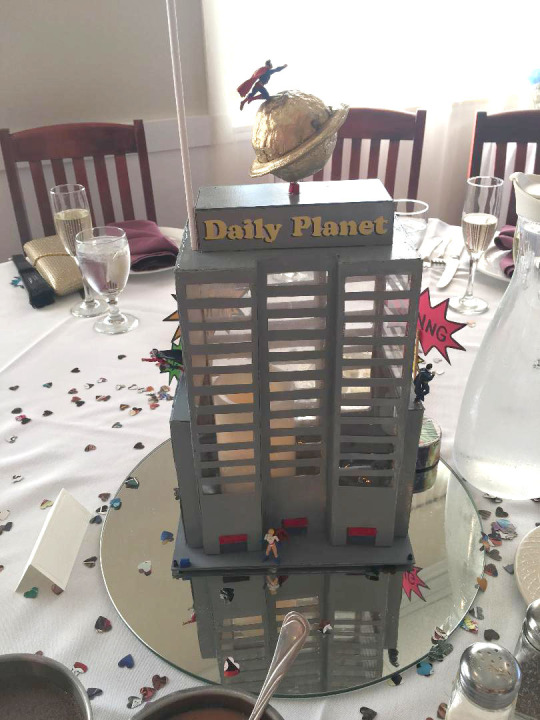
Table #2 - SAVAGE LAND
A pre-historic tropical region tucked deep within Antarctica, the dangerous Savage Land is home to dinosaurs, active volcanoes, and tribal natives.
Cast: Banshee, X-23, Gambit, & Sabertooth
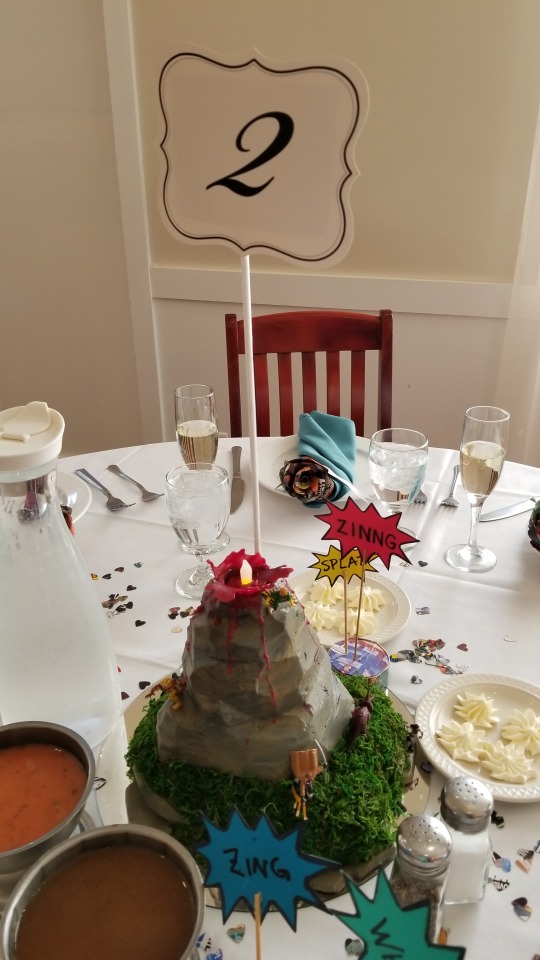
Table #3 - THE DAILY BUGLE
Daily Bugle photographer, Peter Parker, swings into action as the amazing Spider-man when New York is threatened.
Cast: Spider-man, Black Cat, Vulture, Hobgoblin, Lizard, & Electro
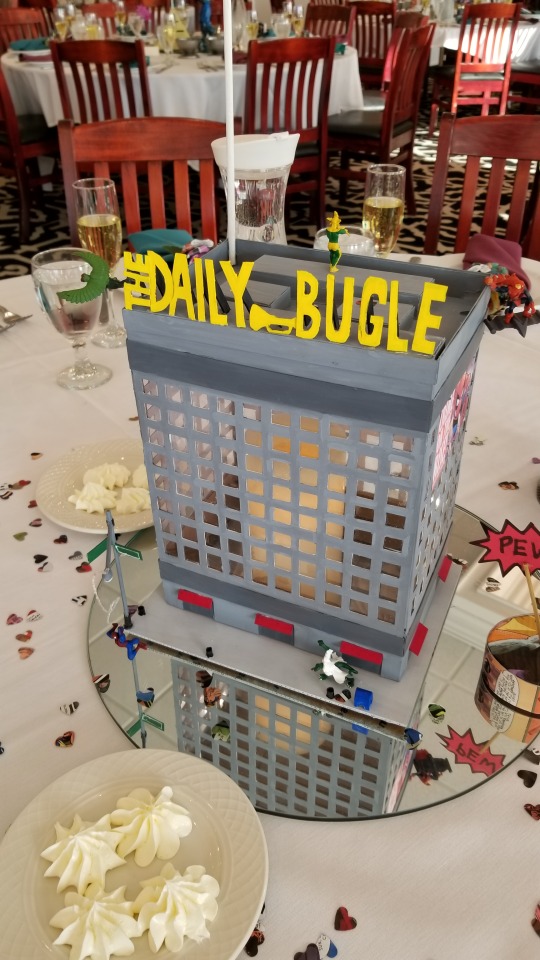
Table #4 - THEMYSCIRA
The hidden all-female island of Themyscira is home to Wonder Woman and the mighty Amazons.
Cast: Wonder Woman, Black Adam, & Killer Frost
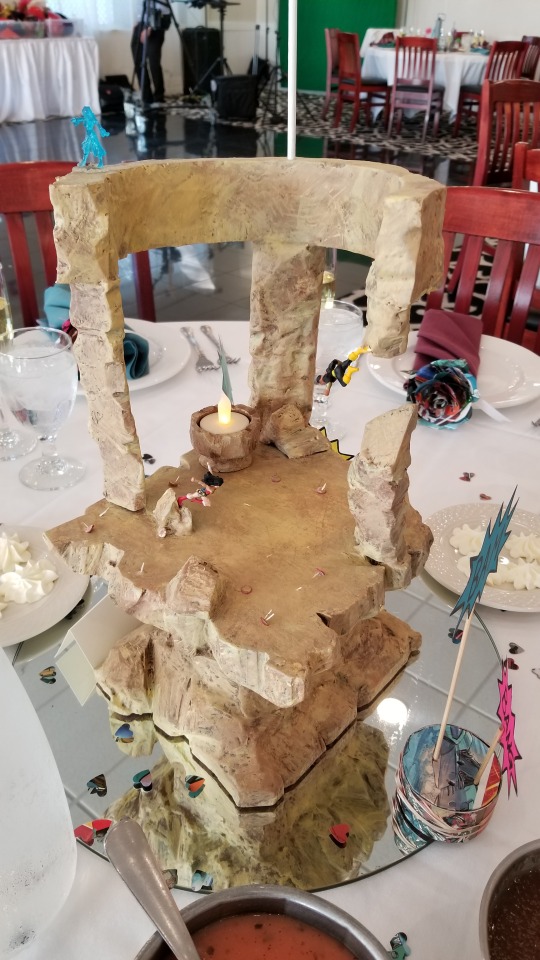
Table #5 - HALL OF JUSTICE
The Hall of Justice serves as headquarters to the all-star team of heroes known as The Justice League.
Cast: Dr. Fate, Hawkman, Firestorm, Zatanna, Captain Cold, & Atom Smasher
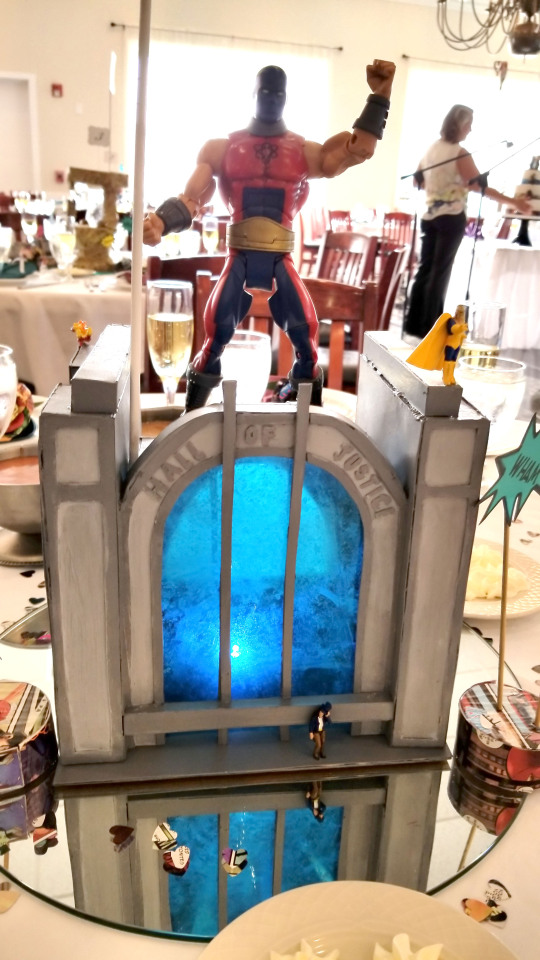
Table #6 - ATLANTIS
(In the hoopla of the day, no one remembered to release the fish from the bag prior to the pictures being taken. Joe noticed it mid reception, ran over, rolled up his sleeve and let those guys free stating “I didn’t come here for 99%!!!!.)
The underwater kingdom of Atlantis is hidden well below the destructive hands of surface dwellers.
Cast: Namor & Aquaman
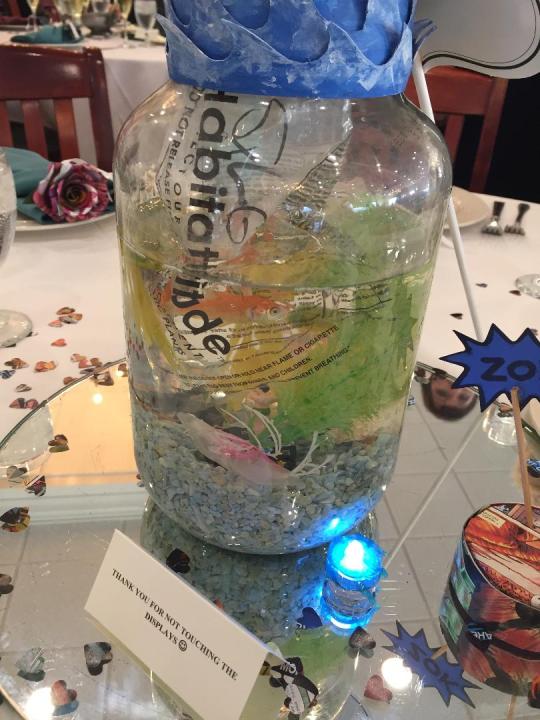
Table #7 - THE BATCAVE
Hidden beneath Bruce Wayne’s manor, the Batcave serves as home to the world’s greatest detective - Batman.
Cast: Robin, Batwoman, Riddler, & Two-Face
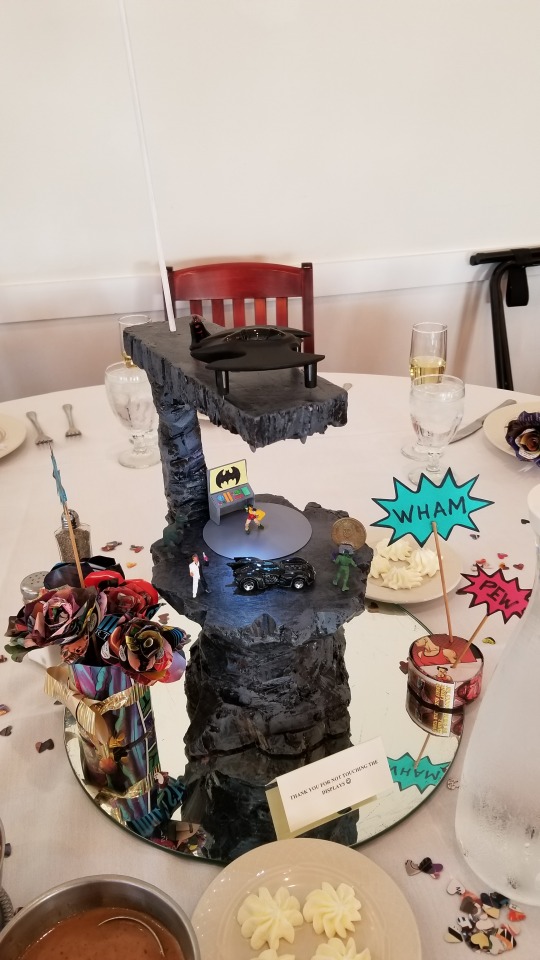
Table #8 - THE DANGER ROOM
Located within the Xavier Institute, the mutant team known as the X-Men hone their battle skills through the virtual reality simulations of the Danger Room.
Cast: Professor X, Storm, Havok, Blob, Pyro, & Mystique
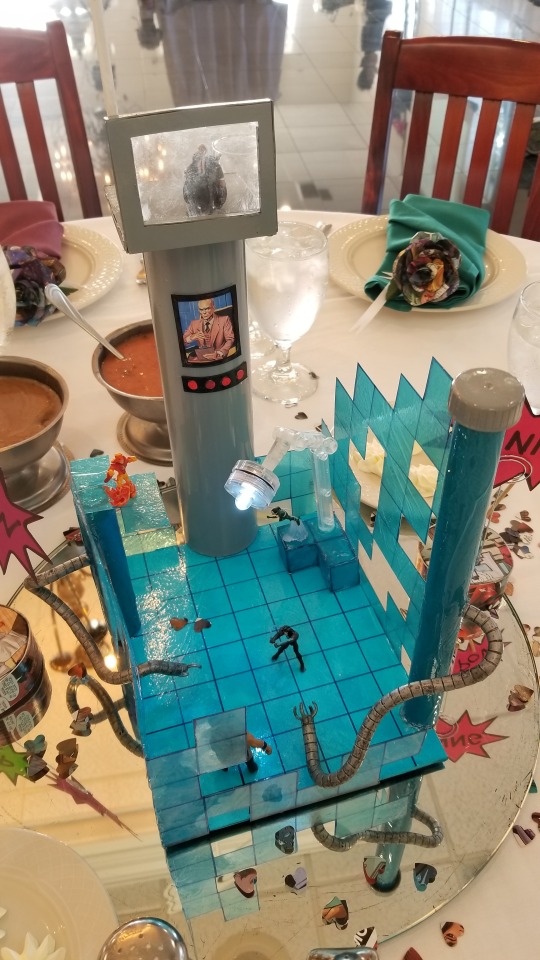
Table #9 - BAXTER BUILDING
The Baxter Building is the headquarters of the Fantastic Four, a 4-person superhero team that often defends Earth from Galactus - The Devourer of Worlds.
Cast: Invisible Woman, Human Torch, Dr. Doom, & Galactus
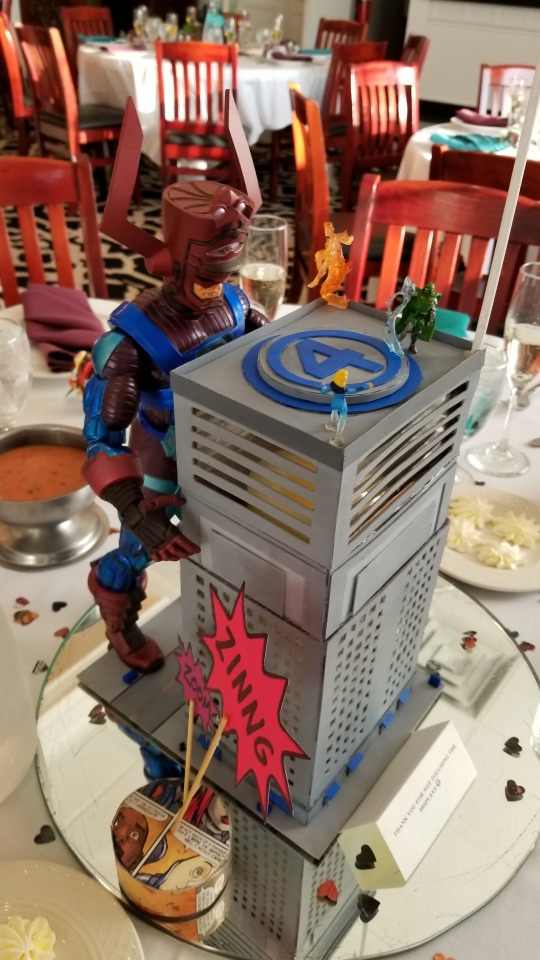
Table #10 - STARK INDUSTRIES
After surviving a near fatal injury to the heart, Tony Stark of Stark Industries dons his Iron Man armored suit to protect the world.
Cast: Iron Man, Mandarin, & Fin Fang Foom
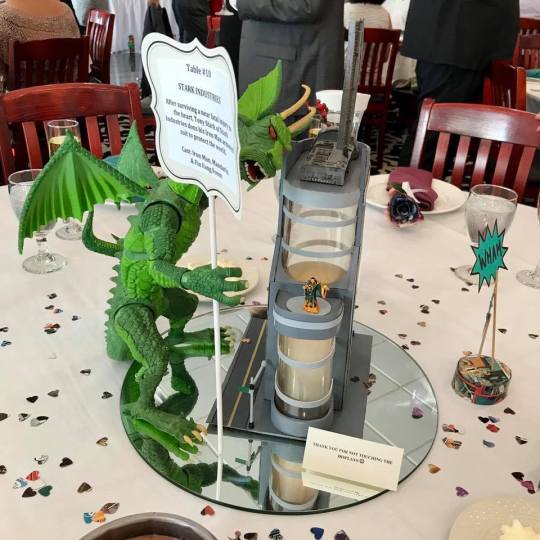
Table #11 - APOCALYPSE PYRAMID
Believing in the survival of the fittest, the villainous mutant known as Apocalypse was born thousands of years ago in ancient Egypt.
Cast: Apocalypse, Angel, Bishop, & Cable
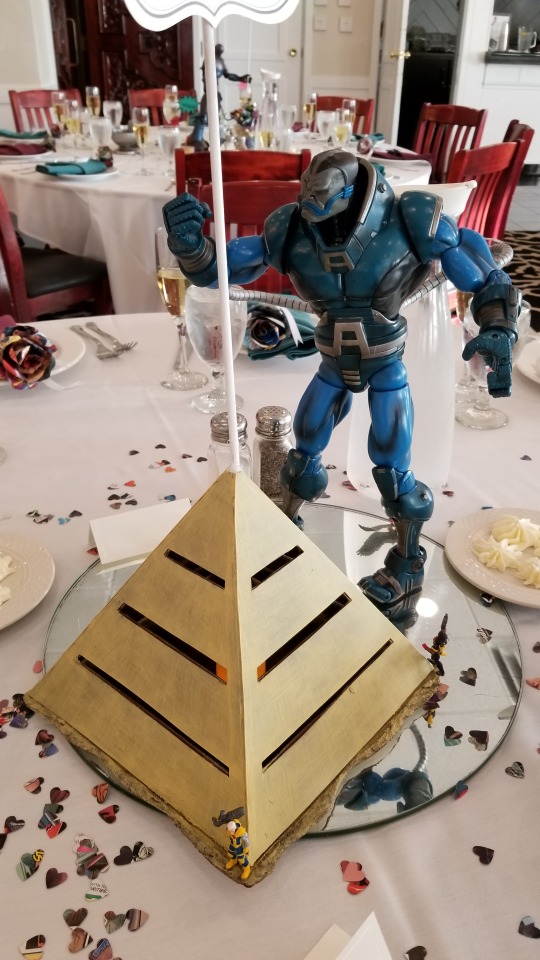
Table #12 - ARKHAM ASYLUM
Arkham Asylum is a psychiatric facility that houses the criminally insane of Gotham City.
Cast: Green Arrow, Black Canary, Scarecrow, & Deadshot
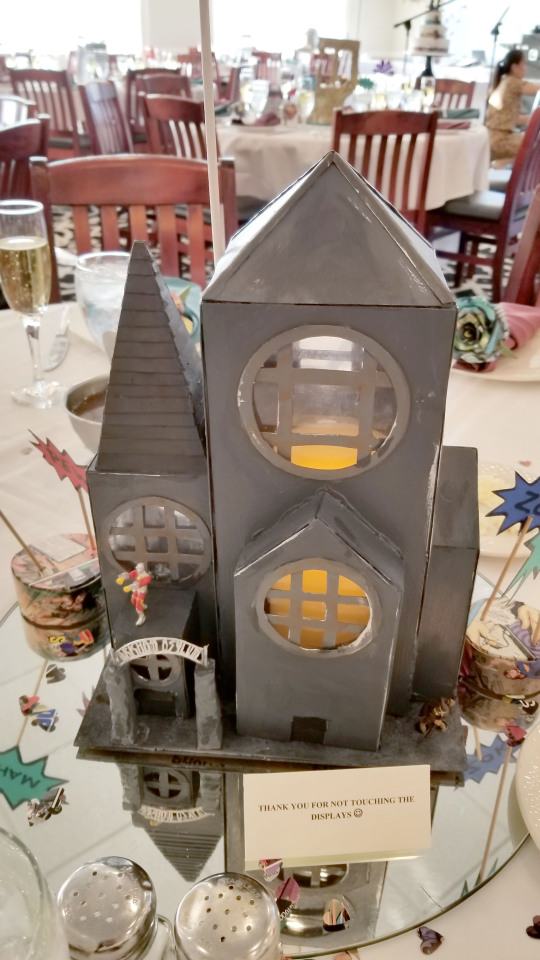
Table # 13 - OA
Chosen for their tremendous amount of willpower, the members of the intergalactic space patrol known as the Green Lantern Corp are bestowed their powers from the ancient Guardians of planet Oa.
Cast: Hal Jordan, Jon Stewart, & Manhunter
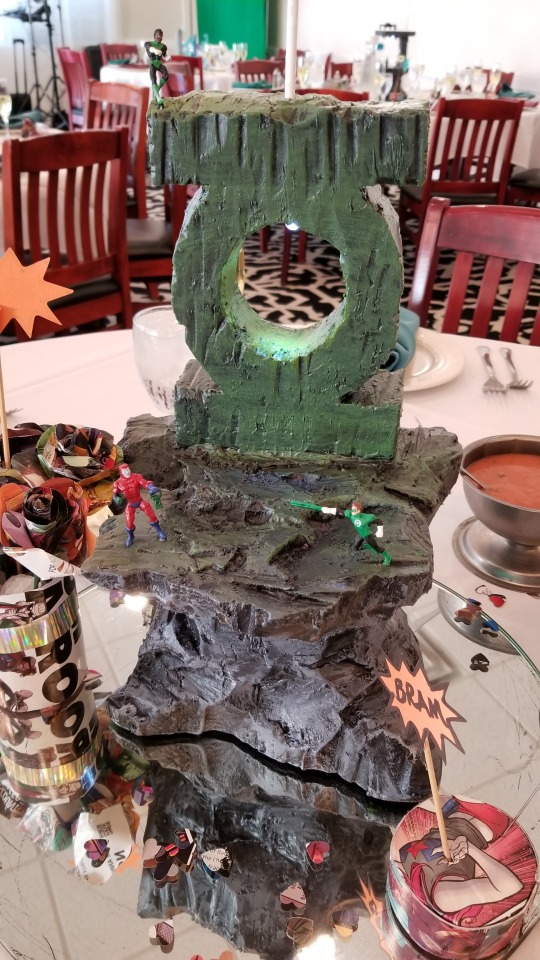
Table # 14 - ASGARD
The Rainbow Bridge serves as the passage into the mystical realm of Asgard, home of the Norse Gods and the God of thunder-Thor.
Cast: Thor, Beta Ray Bill, Ronin, & Hulk
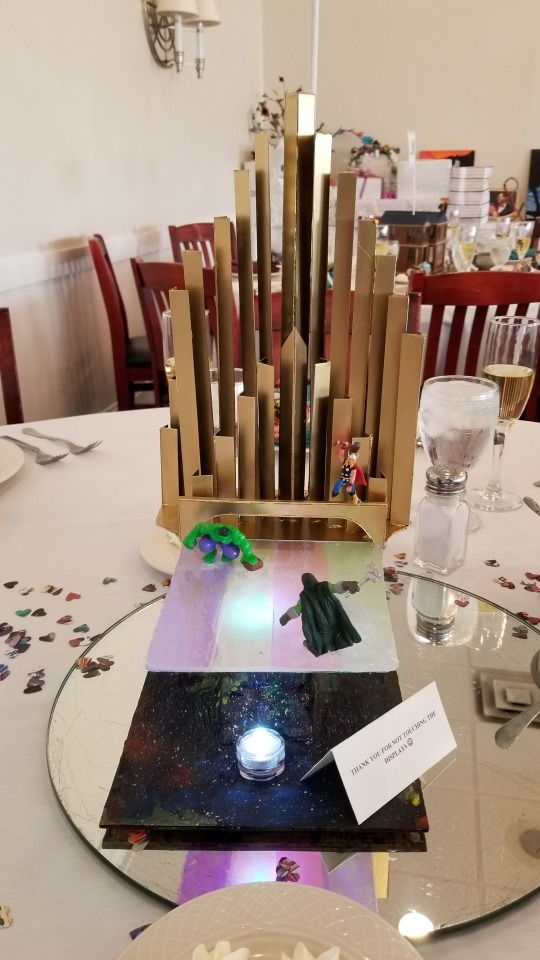
Table #15 - AVENGERS TOWER
Avengers Tower is the headquarters of the Avengers – Earth’s Mightiest Heroes.
Cast: Quicksilver, Giant Man, Ant Man, She-Hulk, Dr. Strange, & Wonder Man
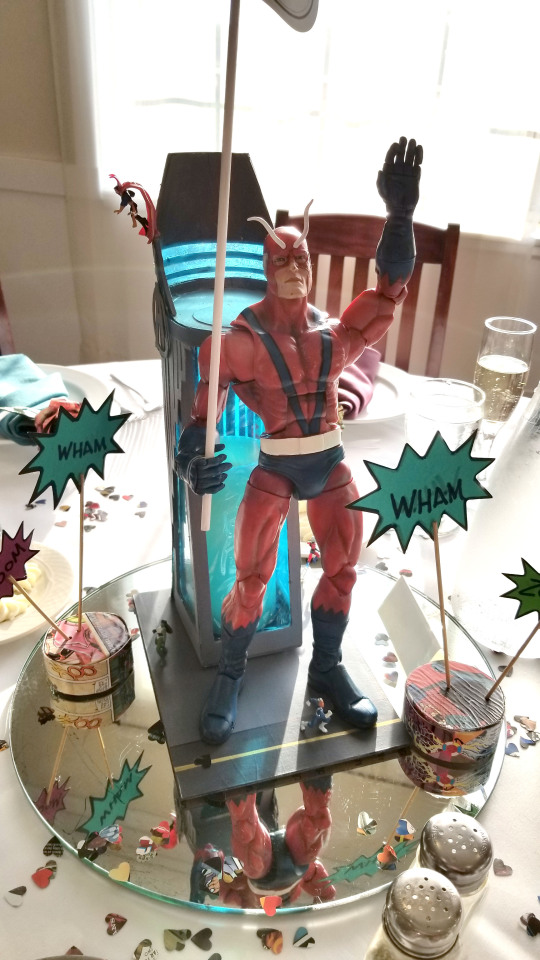
Table #16 - WAKANDA
The Black Panther protects his hidden kingdom of Wakanda from those who would threaten to take its precious resource Vibranium.
Cast: Black Panther, Hawkeye,& Ultron
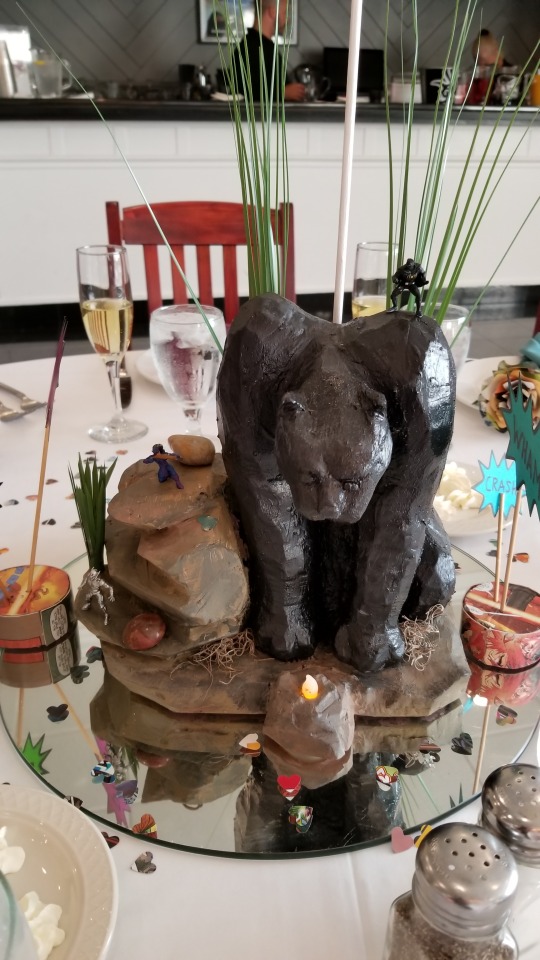
Table #17 - SENTINEL BASE
Out of mass hysteria, the government has created giant mutant-hunting robots to control, imprison, and destroy mutant kind.
Cast: Shadowcat, Jubilee, Iceman, & Beast
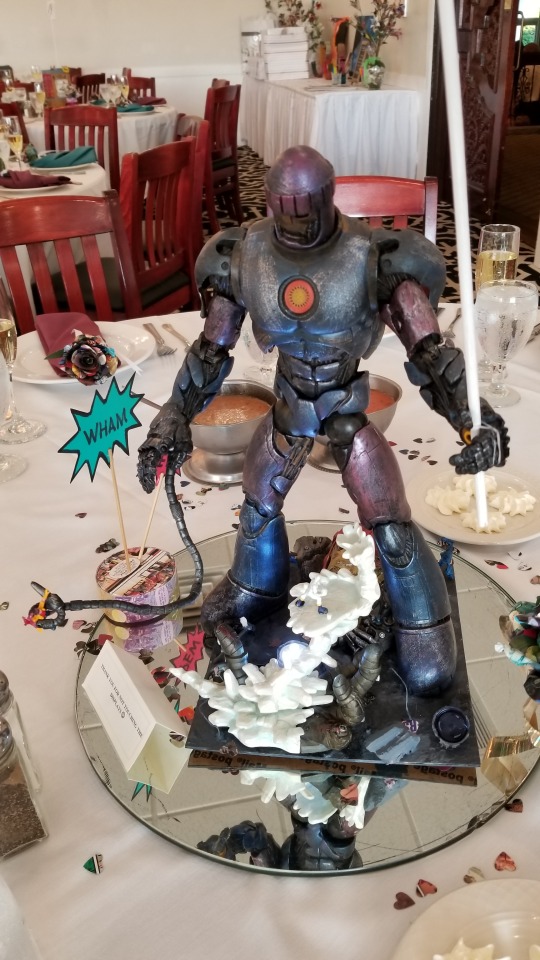
Table #18 - HYDRA BASE
Having amassed a plethora of weapons, soldiers, and resources over the past decades, Hydra has become a worldwide subversive organization dedicated to global domination.
Cast: Captain America, Falcon, Nick Fury, Red Skull, & Hydra Agent
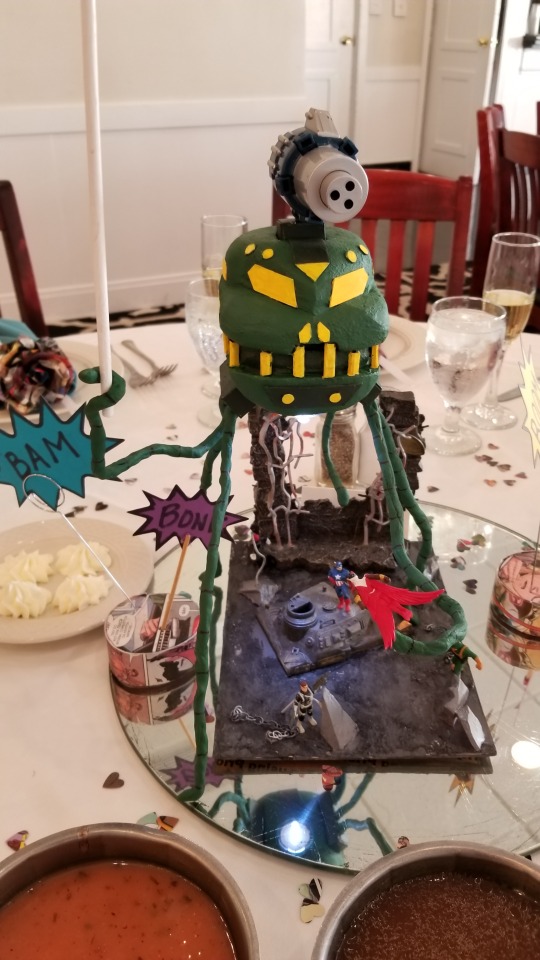
Table #19 - HELL’S KITCHEN
Hell’s Kitchen, the gritty, low-income neighborhood on the west side of midtown Manhattan, is protected by Daredevil – The Man Without Fear.
Cast: Daredevil, King Pin, Bullseye, Elektra, & Iron Fist
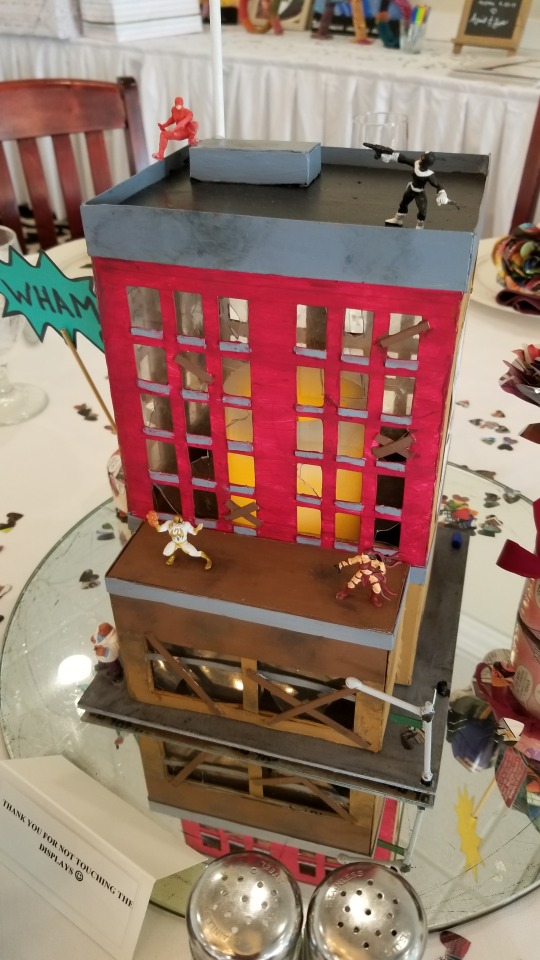
Table #20 - XAVIER MANSION
The Xavier School for Gifted Youngsters is the institute dedicated to training young mutants in controlling their powers and fostering coexistence with humans.
Cast: Cyclops, Juggernaut, Rogue, & Psylocke
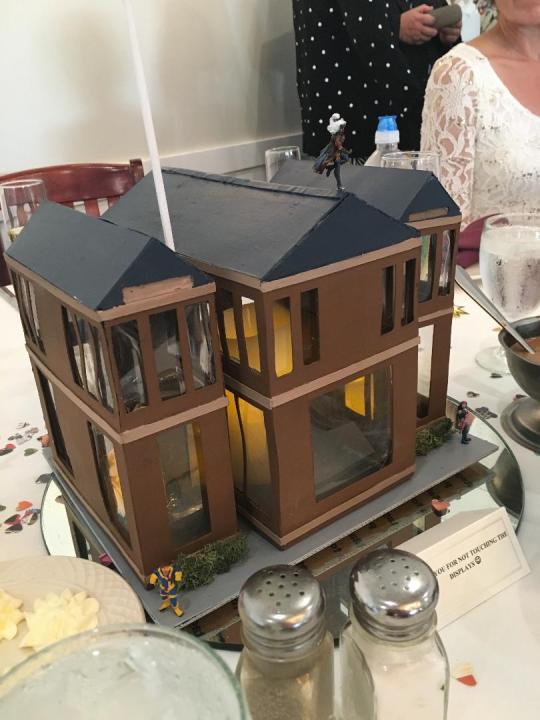
2 notes
·
View notes
Text
On President Obama: The Black Swan
“Black swan” is used a metaphor that describes an event that comes as a surprise, has a major effect, and is often inappropriately rationalized after the fact with the benefit of hindsight. I cannot think of anything that better describes President Obama. His win in 2008 was a surprise in every possible way. His win against Hillary Clinton in the Democratic Primaries was completely unexpected. His win against John McCain, even more so. No one at the beginning of 2008 would have imagined a young black man with the name Barack Hussein Obama would be elected, twice, as the president of the United States. As surprising as his elections were, the effect he has had on the country has been even more significant. Depending on what side of the political spectrum you belong, the effects of his presidency is either extremely positive or negative. What isn't up for debate is whether or not the effects are significant. He is also one of the most misrepresented, misunderstood, misaligned political figure in my lifetime, and an argument can be made in the past hundred years. As a black swan, President Obama went against the entire American history of presidencies. In every way, he stood out in contrast to his predecessor and opposition. From the first time I heard him speak at the Democratic National Convention in 2004 to his last days as President, he has reaffirmed my belief that America didn't deserve him or Michelle, but I'm damn glad they were here for us.
In early 2008, I was a Hillary Clinton supporter. I thought she had the necessary experience and qualifications to be a very good president. As the Democratic primaries played out, I saw something in Barack Obama that made me think he was what we needed at this time in our country's history. Not because he is a black man, I saw this was a secondary perk, but as someone who has a great grasp of history, ideals, and the importance of pragmatism. As a devout pragmatist, I rarely see politicians who fully grasp how moving the country forward as much as possible is more important than ideological purity. Like Justice Stewart's view of pornography, when it comes to pragmatism, “I know it when I see it.” The more I watched candidate Obama, the more I knew he understood progress in ways very few politicians have or do. After eight years of one of the worst administrations since Hoover, what America needed was someone who knew how to move us forward ethically, legally, politically in a rapidly changing world. As much as I liked and respected Hillary, I felt Barack was the one who could move us forward at that moment in our history.
On election night, when he came out on stage in Chicago's Grant Park to give his victory speech, I have never felt more proud of my country. As I wept, listening to him speak, I couldn't imagine how African-Americans must be feeling. As much as his election meant to me personally, I could not imagine the significance it had on Black America. I grew up seeing the violent police actions against peaceful Civil Rights protesters. Even though the Civil Rights Act became law, I have been well aware of how ingrained and widespread racism is in American society. I never, ever thought I would see a black person elected as president. Yet, here was the black swan president-elect in front of a quarter of a million people in Grant Park and millions more watching on t.v. and online laying out a shining beam of hope and a path towards progress. Telling everyone that we are all in this together and it is up to us to demand and work for change. It was everything I've believed in and worked for my entire adult life. At that moment in time, I felt America had finally turned the corner towards the equality, justice, and fairness promised in the country's founding documents. Within months, this feeling of hope was replaced with feelings of frustration. Frustration not at President Obama, but at the cabal of conservatives who met on the night of his inauguration to discuss their strategy of stopping and obstructing everything the new president proposed. A group that included: Republican Reps. Eric Cantor (Va.), Kevin McCarthy (Calif.), Paul Ryan (Wis.), Pete Sessions (Texas), Jeb Hensarling (Texas), Pete Hoekstra (Mich.) and Dan Lungren (Calif.), along with Republican Sens. Jim DeMint (S.C.), Jon Kyl (Ariz.), Tom Coburn (Okla.), John Ensign (Nev.) and Bob Corker (Tenn.). Along with former House Speaker, Newt Gingrich, and Republican consultant, Frank Luntz. Their meeting has been well-documented and their purpose was to make sure that Republicans not support anything and obstruct everything put forth by the new administration. Keep in mind that this strategy was laid out at a time when the country and the world was going through a serious economic downturn. Their efforts were focused on making sure the new administration failed. Even though he wasn't there, then Senate Minority Leader Mitch McConnell made it publicly known his main goal was to make Obama a one-term president. The GOP was on board, lock-step, to make sure President Obama, and by proxy, America fails. Not long after learning of conservatives' plans to obstruct President Obama, my frustration turned to the far left who turned on the new president because they didn't get what they thought was their due. They wanted single-payer health insurance, banks taken over, and bankers thrown in jail. Single-payer was never going to happen with a coalition of only sixty Democrats and Independents in the Senate. All it took was one to be against it and the whole deal fell apart. With Blue-Dog Dems like Jim Webb, VA, Landrieu, LA, and Ben Nelson, NE, and Independents like Joe Lieberman, there weren't the votes to get single-payer even put up for discussion, let alone voted on or passed. For reasons that can only be explained as a complete lack of basic civics knowledge, the far left blamed President Obama for these Senators never going to vote for single-payer. It doesn't matter that President Obama accomplished something every Democratic president since FDR had tried to do but failed, comprehensive health care reform, they were upset. Never mind the number of uninsured would drop to the lowest in history, they didn't care. They had their mind set on a unicorn and when they didn't get it, they blamed President Obama for not personally delivering it to their doorstep. The far-left had the same unrealistic attitude about the bankers. Never mind that most of the damage done from the mortgage crisis came from products and actions that were perfectly legal, the far left wanted heads on pikes. Never mind during his administration the largest fines ever imposed by the government have been against financial institutions. Never mind he helped get Dodd-Frank passed that is the strongest laws and regulations against the financial sector since FDR. Never mind he came up with the Consumer Financial Protection Bureau and put far-left hero Elizabeth Warren in charge of it, they didn't get the unicorns they felt was due them. While the right was organizing and whipping up the masses into an anti-socialism frenzy, forming the Tea Party, having town hall meetings around the country, and spreading lie upon lie on social media and in emails, the left was pouting. Democratic members of Congress ran away from Obama and the Affordable Care Act because they were scared to stand up to the crazies on the right. Progressives sat out the 2010 midterms because they didn't get their unicorns. The results of this have been catastrophic. Meanwhile, the black swan president kept finding ways to move the country forward. It wasn't just far-left progressives who abandoned President Obama in 2010, it was also many Democratic members of Congress who lost their spines and balls at the sight of a bunch of angry octogenarians at town hall meetings. They could have stood up for the Affordable Care Act, the stimulus, the auto bailout...but they didn't. They ran away from the President and his policies. Policies, now that he's left office, Democrats in Congress are saying have to be defended with every ounce of effort. Instead of touting how these policies helped the working class, these cowardly Democratic officials hemmed and hawed out weak ass explanations while the opposition was organizing and pushing outlandish talking points and lies that became ingrained in conservatives' belief systems. Meanwhile, the black swan president kept finding ways to move the country forward without help from lawmakers from his own party.
With no way to get anything passed in a now Republican-controlled House, President Obama moved the bar of progress forward anyway. He made sure the DOJ didn't defend DOMA. He expanded protections to the LBGT community. He had the DOJ investigate corrupt and racist police department practices. He got Syria to turn over its chemical weapons. He negotiated a treaty with Iran ending their nuclear weapons program. He did more to fight climate change than any president in history. He helped push a revolution in renewable energies. He expanded federally protected lands. He oversaw the longest positive private sector jobs growth in history. Whether it was the environment, health care, rights or jobs, President Obama did more than just about any modern-day president. And, he did it all with the least amount of help. FDR had major majorities in both houses of Congress every single one of his terms. President Obama had a slim majority in the Senate for a couple of months that was lost when Ted Kennedy got sick and eventually passed away. From that point on, he had no luxury of a working majority in the Senate and Republicans making sure nothing would get done.
Despite unprecedented political opposition, President Obama moved the bar of progress forward. Despite unrelenting racist attacks, he never lashed out. Despite the lack of support from members of his own party, he never turned on them. Despite having his legitimacy questioned from day one, he held his head up and acted with dignity. If you had to construct a president from scratch, you'd be hard pressed to construct one that would be better than President Obama. This doesn't mean he didn't have his flaws. Every president has them. However, his flaws were his willingness to believe his opposition had some bottom to the level to which they'd go, some basic ethical principles, some common ground from which he could work with them. Unfortunately, Republicans had no such limitations on their morals or conscience. It is easy in hindsight to blame President Obama for missing the nature of his opposition. That he wanted to believe the better nature of people could only be called a flaw by the most cynical of people. As the black swan president, Obama had to walk a razor's edge that no one in history has had to tread. He had to be twice as good, twice as nice, twice as everything in order to even be considered “normal.” If he would have been “No Fucks To Give Obama” from the onset, he would have accomplished nothing. His pragmatic nature knew and understood this. Unfortunately, like so many other things, too many progressives did not understand or appreciate not only the unique situation President Obama was in but how deftly he handled it to the betterment of us all. Unfortunately, the razor's edge he had to walk was not understood by even those who claim to have been his allies. Whenever I hear criticism of him from the left, I always ask, “What would you have done differently?” Inevitably, their response comes down to some idealistic act that completely ignores the realities and variables President Obama was faced with at the time he had to make his decision. “I would have pushed for single-payer!” Great, now explain how you would have got the Blue Dog Dems to even consider it so it would be discussed in committee, let alone reach the point where it would be voted on and passed. “I would have closed Gitmo!” Not without approval from Congress. “I would have jailed bankers!” Okay, on what grounds? A lot of the causes of the financial and mortgage meltdown were legal. “I would have helped those who suffered from the mortgage crisis more!” How? What mechanism would you have used and how would you have gotten the majority of Congress to approve it because it would have to have financial help and that has to go through Congress? It is easy to be a Monday-morning quarterback. Hundreds of thousands of fat, lazy, living off their self-perceived glory days of high schools sports do it every day on sports talk shows. Political decisions don't occur in a vacuum. They happen in a very complex environment with dozens of moving parts and hundreds of personal agendas. Wanting someone to do what you think should be done does not translate to what can be done. I've closely watched major political figures here and abroad for the good part of forty years. In this time, I've never seen anyone get more bang-for-the-buck than President Obama. Democrats had a workable majority (60 votes) for all of four months and one week in 2009. That is the amount of time President Obama had legitimately get all the things the left say he could/should have. For two hundred and eight weeks of his presidency, he had a workable majority for seventeen with an opposition party that refused to work with him on ANYTHING but please go ahead and tell me about how he should have done X or Y.
When the history books are written fifty years from now, when I am long dead and gone, I have no doubt that President Obama will be viewed as one of the most influential presidents in American history. Sadly, like other influential presidents before him like Lincoln, FDR, and Johnson, he was not truly appreciated in his time, even by those of his party and those who claimed to be his ally. I will always be proud of my vote for him, twice, to be our president. I will always be upset at those on the right and the left who tried to undermine him. I will always believe that America didn't deserve him. I will always be damn thankful we had him. He was the black swan. He came out of nowhere. He defied all conventions and history. He had and will have a dominant role in history. He will forever be my president.
When I think of President Obama, I am reminded of the scene at the end of “Excalibur” where King Arthur is talking to a mortally wounded Sir Lancelot: “You are that and much more. You are its greatest knight, you are what is best in men.” President Obama was our greatest modern-day president and what is best in men.
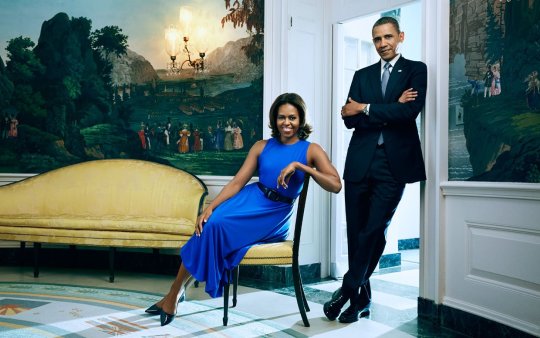
72 notes
·
View notes
Text
Something Doesn’t Smell Right...HB. 1398 (Proposed In The Virginia General Assembly)
In an America for which angry, vengeful, and populist driven politics appear to be the new order of the day, and for which there will be frequent protest and civil unrest in response to the rise of right wing populism’s newest presidential “standard bearer” in Donald Trump, there leaves much to be desired these days. The polarization of the nation as it stands today is essentially a showdown between those who have accepted Trump’s racial and economic nationalist message and early authoritarian actions, and those who view such actions as the lead up to a nation in which constitutional conventions and civil rights gains are eroded. As such, over the next four-year period we can expect to see more live footage than we have seen in decades of marches, rallies, town halls, and even riots. Such events as these will mark not only the sharp political divide of the right and left, but even more so the cultural divide which in part has its genesis in the cultural and ideological shifts that reached a boiling point in the 1960’s. Today, as it was so then, there are essentially two camps. One which views in the so-called “American dream” in a way more likened to the “days of old” when everyone “knew their place”. When whites (mostly males) came home from an 8 or 12- hour job at the office or steel mill and brought home the bacon to well-manicured suburban enclaves and apron wearing wives. This, such white men did secure in the knowledge that they would never really have to compete with other races or genders for jobs or housing, and that the government would enforce such a handicap against other groups with either unparalleled violent vigor (Jim Crow south) or at the very least, nonchalant acquiescence (Jim Crow north). The other views the “American dream” in terms that are more absolute. In terms that force the nation to meet its high minded and self-congratulatory ideals with real life practice. When this came to the fore in the form of young African American led student sit-ins, marches, and protest, only to be followed by much of the same from other minority groups including women, white mostly conservative males felt the world they once knew upended. This lead to the sort of “clash of civilizations” for which the decades of the 60’s and 70’s are known. From Selma, to Watts, from Detroit to Chicago to the campuses of UC Berkley and Kent State, the combative and often violent convulsions of social-political change and/or readjustment often took center stage in the form of protesters vs the police state apparatus. As with all societies in which police are transformed from enforcers of the law and guardians of the citizenry, into centurions of ideological “authority” the pretext for such actions was “rule of law”. Never was such a sentiment stated as clearly as it was by the late President Richard Nixon when he promised in 68’ to restore “law and order” in America, a promise that would be echoed decades later by candidate Trump during his republican nomination acceptance speech, and alluded to again by President Trump during his inaugural address. Couple this with the fact the current president has insulated himself with cronies of all sorts from the alt-right media’s racist-in-residence Stephen Bannon, to fake news provocateur and former army Lt. General and now National Security Advisor Michael Flynn, to his shadowy son-in-law and media/real estate heir Jared Kushner (to name only a few) and you have the makings of an corrupt inner court. What’s even more, is that with republicans as the majority in Congress, in governorships, and many state legislatures, those who are by nature looking toward re-election will undoubtedly either go along with the Trump doctrine or at the very least look the other way giving vague and cryptic answers when challenged on the dealings of their party’s leader in the White House. In this way, Trump’s presidency will be more of a populist kleptocracy than a dictatorship in the mold of such crazed ideologues such as a Hitler, Mussolini, or Stalin. Kleptocrats as they are defined, are people who utilize positions of power to enrich themselves at the expense of the people, or in this case, further enrich themselves. This typically involves creating layers of insulation from prosecution or critique. Trump has successfully done this. With his pre-emptive strikes against all critical media as “fake”, “biased” or “dishonest”, direct communication to his most ardent supporters via Twitter, a loyal and misinformed populist following, and his framing of America as a dark and corrupt place that only he can repair, Trump has either inadvertently or shrewdly come upon the blueprint for kleptocratic power. However, as protest continue to mount in opposition to his political abuses and inadequacies, one of the more immediate rungs in his layer of protection will be his framing of “law and order” politics, in which the police apparatus will be used to enforce and protect on the local levels that which is administered from the Oval Office. This may not only involve the ways in which the police state will be allowed to have free and careless reign (especially under a presumptive Attorney General Jeff Sessions with a man with a less than stellar civil rights record), but the way in which police and police departments themselves will be insulated from backlash brought about by protest and a critical citizenry. One example of the dawning of such an era comes in the form of a bill scarcely known, that was recently proposed quietly on the floor of the Virginia General Assembly (Virginia’s state legislature located in the capitol city of Richmond, VA…my home). HB (House Bill) 1398 Hate crimes; acts against law-enforcement officers, firefighters, and EMS personnel., is a bill introduced by republican Delegate Richard P. Bell of Virginia’s 20th district covering Augusta, Rockingham, and Highland counties, in the city of Staunton. In this bill, the purpose or summary is described as such : “Expands the definition of hate crime for the purpose of reporting hate crimes within the Department of State Police to include acts against persons employed as law enforcement officers, firefighters, or emergency medical services personnel”. The bill as proposed in full detail looks something like this (bold print on points of emphasis):
Be it enacted by the General Assembly of Virginia: 11 1. That § 52-8.5 of the Code of Virginia is amended and reenacted as follows: 12 § 52-8.5. Reporting hate crimes. 13 A. The Superintendent shall establish and maintain within the Department of State Police a central repository for the collection and analysis of information regarding hate crimes and groups and individuals carrying out such acts. 16 B. State, county and municipal law-enforcement agencies shall report to the Department all hate crimes occurring in their jurisdictions in a form, time and manner prescribed by the Superintendent. Such reports shall not be open to public inspection except insofar as the Superintendent shall permit. 19 C. For purposes of this section,: 20 "Emergency medical services (EMS) personnel" means the same as that term is defined in § 21 32.1-111.1. 22 "Firefighter" means the same as that term is defined in § 65.2-102. 23 "hate crime" means (i) a criminal act committed against a person or his property with the specific intent of instilling fear or intimidation in the individual against whom the act is perpetrated because of race, religion or, ethnic origin, or employment status as (a) a law-enforcement officer, (b) a firefighter, or (c) EMS personnel or that is committed for the purpose of restraining that person from exercising his rights under the Constitution or laws of this the Commonwealth or of the United States,; (ii) any illegal act directed against any persons or their property because of those persons' race, religion or, national origin, or employment status as (a) a law-enforcement officer, (b) a firefighter, or (c) EMS personnel; and (iii) all other incidents, as determined by law-enforcement authorities, intended to intimidate or harass any individual or group because of race, religion or, national origin, or employment status as (a) a law-enforcement officer, (b) a firefighter, or (c) EMS personnel. 33 "Law-enforcement officer" means the same as that term is defined in § 9.1-101.
This bill was proposed on January 11, 2017, approximately 9 days in advance of Trumps inauguration by a republican member of the Virginia Assembly, which though led by a democratic governor and lieutenant governor in the executive branch, is majority red in the legislature. The bill’s co-sponsors include 14 other republican delegates and only one democrat, (Kaye Kory – district 38, representing Fairfax County). It should also be mentioned that Virginia is not only a key battleground state in presidential elections, and neighbor to the nation’s capital, but that 2017 is an election year in which a litany of republican candidates will be setting their sights on the Governor’s Mansion. At least four republicans have declared their candidacy; former RNC chairman Ed Gillespie, businessman Denver Riggleman, Chairman of the Prince William County Board of Supervisors and former lieutenant governor candidate (circa, 2013) Corey Stewart, and State Senator Frank Wagner. There are also four more people on the list of potential candidates who may throw their hat into the ring for the republican nomination; former Lieutenant Gov. Bill Bolling, former House Majority Leader Eric Cantor, financial consultant and former U.S. Senate candidate (circa, 2014) Shak Hill, and former State Senator Jeff McWaters. Meanwhile, the democratic party has only two candidates at the forefront of the race for governor, current Lt. Gov. Ralph Northam and the most recently announced Tom Perriello, former democratic congressman and diplomat under President Barack Obama. There are two other names that have received scant attention for the democrats in the race, U.S. Congressman Gerry Connolly and Virginia’s Secretary of Public Safety Brian Moran. However, considering the lower profiles of the latter two, it may well come down to a battle of 8 against 2. Considering such a political landscape both nationally and state wide and considering that it’s quite arguable that as such a state like Virginia goes, so goes the nation, it’s plausible that the introduction of this bill could in part be a wink and nod to the Trump administration’s call for “law and order”. What’s more, if republicans win back the Governor’s Mansion not only does this bill stand a greater chance of being passed to the detriment of future protesters, but Virginia may very well stand as a “shining example” of similar laws to be implemented in other states, something Trump would potentially single out for praise. But besides the sheer politics of it all, what makes this bill detrimental? Well for one it begins by drawing a false equivalency couching it in terms of “hate crimes”. As is well documented hate crime laws on the federal, state, and local levels, arose from civil rights legislation which were used to fight segregation and the extra-legal violence toward Blacks in the south. Such laws, bills, and policies were later expanded to include protections for other minorities. In this way, these were laws that were responses to systemic ills, many of which were (and are) enforced by many police departments themselves, at the behest of the state of course. Furthermore, police officers already have protections under the law that hand out severe penalties considering the dangers of their job. For instance, in Virginia it is a class 6 felony to assault a police officer, murder of a police officer is classified as capital murder and is punishable by death or life in prison, not only this but Virginia is one of 14 states that have adopted the Law Enforcement Officer’s Bill of Rights provision into its state statue. This was first set forth in 1974 following the Supreme Court ruling in the cases of Garrity vs. New Jersey (1967) and Gardner vs Broderick (1968). This is essentially intended to protect police officers from investigation and prosecution arising from conduct during official performance of their duties and provides them with privileges based on “due process” not normally afforded to regular citizens. The most glaring feature of this law, is that it prevents the creation of civilian oversight and review boards and under this policy police officers are judged only by other officers. With such protections, already in place for police officers, it seems outlandish if not redundant, that a bill such as the Virginia Assembly’s HB 1398 would even be proposed. But, what if you are a member of the dominant political party in the nation on the state level, and you want to give a wink to police officers and your “law and order” president? What if seeing the protest that are bound to continue under Trump’s presidency, you decide you want to build in protections from protester critique? This brings me to the key aspect of this bill and its potential threats. Its vague language and the unjustified leeway in which it could potentially be applied. To begin with, it doesn’t state the specifics as it pertains to “criminal acts”. If there are criminal acts outside of the realm of which police officers are already protected from by law, what are these acts? How are they different specifically? Are these stated criminal acts considered more heinous or more reckless than the one’s already defined in the current penal codes that protect officers? If so, then how? Such unanswered questions and sweeping generalizations are dangerous in that the law can be applied to nearly any situation. This is of interest when police officers are faced with civil unrest and protest like that which has happened in the wake of news breaking police brutality cases. The state could very well say under such a law, that mass protest (or some portion of it) is a criminal act, particularly where the police are involved. To what extent could this infringe upon the public’s right to assemble, and freedom of speech? To that I answer, more than quite a bit! In addition to this, the provisions from the Law Enforcement Officer’s Bill of Rights explicitly state that police officers can govern themselves which is to say that they have their own code of justice. Another problematic aspect of this law is that if enacted, those deemed in violation of these said “hate crimes” will be placed in a data base not open to the public, except at the “superintendent’s” discretion. In this case, it would mean the lead officer or department in charge of the investigation of such a hate crime. Given the history of policing in the United States, it’s fair to say that if one was convicted of something for which one wanted to dispute and needed access to “evidence” to prove his or herself innocent, the chances of receiving such information are probably slim to none. If that sounds like something that could lead to a McCarthy like blacklisting of citizens for dissenting, then you may be right. The bill goes on to speak of criminal acts with “the intent of instilling fear or intimidation”. This piece of the bill rings problematic for two reasons. First, police officers though entitled by human nature to feel fear, are or should be trained in how to handle it. The job of an officer is to protect and serve his or her citizens from crimes of and violations of all sorts and as such being trained properly both psychologically and physically should prepare one for the potential dangers that could be faced. What’s more is that most people who are familiar with litigation in some form, know that one of the harder things to prove in a court of law is intent. Who’s to say what a person’s intentions are unless there is hard evidence that can point to it, or a witness that can substantiate it. And even in the case of the latter, witnesses are still subject to variables such as self-interest (non implication, bribery, etc.) that could play a role in a testimony. By the sound of the proposed bill however, it seems as if the intent of another could just as easily be decided by the victimized officer themselves. How many times has points this loophole been abused? Way too many. Lastly, along with the term “any illegal act” which in and of itself is broad, the most troubling and telling words of this proposed bill are; “all other incidents, as determined by law-enforcement authorities”. Law enforcement officers are called such because quite frankly, it is their job to enforce the law. There are a set of laws put forth in the U.S. Constitution as well as each state’s own constitution or statue that are supposed to work in unison with local policy to protect the rights of citizens, and the job of an officer is to see to it that such laws are being enforced. But, creating or determining what incidents constitute as illegalities is beyond the wheelhouse of any police officer and to put it bluntly, illegal. Yet this is what some in the Virginia Assembly (and probably other state legislatures if this passes) want to put forth as a justifiable bill. In the age of Trump’s “law and order” doctrines, and in the face of the criticism and protest he some colluding republicans will inevitably receive, such a play reeks of a kleptocratic government in the works which understands that on the federal, state, and local levels, it will at many points need reinforcement of the police state. Whether the United States of America will become a full-on banana republic remains to be seen, and comparisons to such governments may or may not be a bit premature. But, if this bill that has been proposed in Virginia is to take root, and spread like wildfire to other states, this, coupled with some of Trump’s own statements (one telling quote in which he threatened to “send the Feds” into a “carnage” ridden Chicago) are yet more red flags for the future of equal protections and democracy in this country.
#donald trump#blacklivesmatter#police state#ourrights#blacktivity#protest#the more you know#info#virginia#2018iscoming 2020to www.theblacktivity.com 4DC wegotus
1 note
·
View note
Photo

New openings:
Administrative Assistant, Apple Music (Apple - Culver City)
Apple is seeking an energetic Administrative Assistant with a high level of professionalism to support the Apple Music team in an extremely fast-paced, dynamic environment. This is an exciting opportunity for a candidate who is very motivated, hardworking, articulate, organized and able to work autonomously. This person must have the ability to handle any responsibility calmly while under pressure.
Business Operations Associate (EventBrite - San Francisco)
The newly formed Business Operations team is the special forces of data-driven efficiency for Eventbrite. Historically, Program Managers have sat within each team to use data to solve problems and increase efficiency within each team. As our business has grown, so has our need for data-driven, cross functional problem solvers to tackle challenges that span multiple teams. On this team, you will work with leaders across Engineering and Product, Sales and Marketing, Finance, and Design to own mission critical, high priority projects from end to end.
Public Relations/Marketing director (WM Studios - Las Vegas)
Music industry Public Relations/Marketing director to represent a recording artist. Proactively develop pitches and cultivate relationships with media.
Manage/coordinate artist schedule, events, meeting & performances.
Draft and distribute press releases; media follow up calls to garner coverage. Develop talking points and interview preparation.
Develop and maintain media relationships (locally, regionally, nationally and internationally) to result in editorial coverage for artist.
Marketing Associate (Community School of Music and Arts - Mountain View, CA)
The Marketing Associate works closely with the Marketing & Communications Director and is responsible for marketing, advertising, public relations, community outreach and events, website content and maintenance, social media and data reporting to support CSMA’s strategic marketing efforts. This position works to establish CSMA’s brand, programs and identity throughout the region and increase audience in all programs. This position also researches, recommends, develops and implements creative communication strategies and outreach.
Education & Community Engagement Manager (Seattle Symphony Orchestra)
The Education & Community Engagement Manager, Community & School Programs plays an essential role in managing the Seattle Symphony’s Community Connections program which builds bridges between the Symphony and diverse communities across the Puget Sound Region through Symphony concerts, music making, and co-created community performances. This position is also responsible for developing school programs and professional development training. The Education & Community Engagement Manager provides comprehensive management of Link Up: Seattle Symphony residency and concert program, Open Rehearsals and Professional Development and Training programs for Teaching Artists, classroom teachers and staff.
Marketing Manager (Sonicbids - Brooklyn)
The marketing team at Sonicbids is responsible for building brand awareness, focusing on growth and retaining our user base of musicians and music opportunity owners. We are looking for a creative, technical, strategic and analytical inbound marketing professional to join the team as our User Acquisition and Conversion Manager (Marketing Manager). The role will report to the Director of Marketing (whom we think is stellar) and partner with our heads of content, outbound marketing, account management and key accounts to achieve our marketing and growth ambitions. You will be tasked with demand generation, traffic growth, and conversion optimization using inbound marketing tactics such as SEO, SEM, retargeting, email and messaging workflows. You will setup and use comprehensive analytics to support your strategy and execution of user growth. As a company we really value problem solvers and being able to learn a new technical skill (in a day).
Sponsorship Coordinator (Live Nation - Sponsorship Coordinator)
This position will provide support and sales assistance to Local Sponsorship Sales, overseeing the fulfillment of local, regional, and national accounts by ensuring the delivery of contractual elements and providing excellent customer service. Coordinators will also be responsible for managing all sponsorship inventories.
Head of Marketing (SMG World, Tucson Arena/Convention Center - Arizona)
SMG, one of the world’s largest entertainment companies and operator of the Tucson Arena, Convention Center, Music Hall and Leo Rich Theater in Tucson, Arizona is looking for a Marketing Manager. The Marketing Manager will oversee the planning and implementation of a complete marketing campaign for the facility and all events including group sales, sponsorships, advertising, direct mail, promotion, publicity, and social media. This position will also develop and implement an in house agency to act on behalf of the facility.
Visiting Assistant Professor of Music (Washington and Lee University - VA)
The successful candidate will be expected to teach first-year music theory, direct the University Jazz Ensemble, teach a jazz history course, supervise a senior composition recital, teach a special topics course of her/his design during the University’s 4-week Spring Term, and administer the SonoKlect Concert Series.
Account Executive (Soundcloud - NYC)
We're looking for a versatile advertising salesperson, responsible for closing new business and growing existing business with advertisers and ad agencies alike. Each of our Account Executives manage a regional territory account list, and should have a minimum of 3 years experience working with advertisers and ad agencies in the NY/Tri-state area. You’re not opposed to travel, and you have a profound understanding of the advertising marketplace. Bonus points if you have prior experience within music, lifestyle, mobile and/or emerging digital platforms.
Manager, Urban Artist Relations (iHeartMedia - NYC)
Oversees national artist promotions for iHeartRadio's portfolio of Urban stations.
Represent iHeartMedia at album release events, concerts and showcases
Hosts weekly calls & meetings with labels to discuss priority projects
Provides detailed proposals and recaps to managers and labels in support of all national urban programs
Assists Urban Brand Management Team with day to day projects, correspondence, arrange meetings and events as needed
Spearheads artist asset management around ongoing artist programs, theater and tentpole events
Local production oversight for national content captures, acting as the first point of contact for all visiting Urban artists at LA and NY stations
Music Business Affairs Executive (Amazon Studios - Santa Monica, CA)
The business affairs executive will work closely with the Head of Music and Studio Music Division in negotiating original and licensed music deals for film and television, including deals for composers, music supervisors, recording artists, and soundtrack labels; and will work closely with Studio legal affairs to assist in finalizing agreements and dealing with music-related issues as they arise during the production and marketing of the Amazon programs. The ideal candidate will have a demonstrated ability to effectively negotiate and interact with agents, managers and outside attorneys and be able to efficiently communicate status and tradeoffs with other members of the Amazon Studios team including Creative, Production, Marketing, Accounting, Finance, and Legal, as well as Amazon executives outside of Amazon Studios.
Mixer (Radio One - Dallas, TX)
Radio One is currently looking for a Part-Time Mixer to join our team! A Mixer performs activities in the radio studio and control room to ensure technical quality of sound for programs originating in the studio, syndications, and/or from remote pickup points.
Older listings...
Market Development Manager (Beats by Dre - Chicago)
The Market Development Manager (MDM) is responsible for representing Beats by Dre by building relationships with and supporting a designated number of retail partners within a region and hiring, managing and motivating a staff of Assisted Sales Representatives (ASRs). Retail partners will rely on MDMs for management and associate product training, communication with the brand for feedback and support, in-store promotional event planning and general relationship building. In turn, for the brand the MDM is expected to provide retailer feedback and qualitative and quantitative data, strengthen partnerships, increase merchandising opportunities and grow brand advocacy in market.
To help support retailers, the MDMs will manage a staff of ASRs to execute in-store promotional events, train store associates and build brand awareness. Excellent management skills will be crucial to maintaining an enthusiastic, skilled and productive team that meets its goals.
MDMs must be able to organize a very tight schedule and operate in an efficient manner in order to meet all goals defined by regional managers. Flexibility and ability to work under pressure will be key to success in this position.
Artist Services Assistant (Songkick - Nashville)
We have an immediate opening for an ambitious graduate to join our Artist Services team. We’re looking for someone who has excellent time management skills, is passionate about the music business, and has a great attitude. In this role, you’ll be on the front lines, helping the Artist Services team build a direct relationship between our artists and their biggest fans through our innovative, direct-to-fan ticketing campaigns.
Artist Marketing Manager (Red Bull - Santa Monica, CA)
Red Bull’s Artist Marketing department is a team of passionate, arts-driven creators and curators committed to inspiring artist development and innovation in music. The Artist Marketing Manager role at U.S. HQ is focused on artist- and industry-facing custom projects that develop and sustain the brand’s high volume of artist relationships. He/she is an excellent project manager first, an expert at converting creative ideas into realistic timelines with actionable tasks that deliver tangible results. Secondly, he/she is a creative manager with diverse music taste and a solid network of 1:1 music industry and artist relationships.
Marketing Coordinator (UMG - Los Angeles)
Aftercluv is seeking an ambitious and eager Marketing Coordinator for its US division, with a passion and knowledge of dance & electronic music. This role will include, but is not limited to:
Assistant to Managing Director
Marketing budget management
Domestic and International Marketing, Brand Partnerships and Event Planning. Coordination of marketing plans in the US and international, communication with our offices in 9 countries, monitoring of marketing campaigns, travel coordination for our artists, creation of deck presentations, event planning and coordination, creation of marketing and advertising materials. The ideal candidate is a greatly organized, highly motivated, creative with an entrepreneurial spirit, great networking in the electronic dance world/industry, be able to work in an intercultural environment, have a positive attitude and be a team player.
Assistant, Music Brand Partnerships (CAA - Los Angeles)
As an Assistant supporting an Executive in the Music Brand Partnerships department, you will be handling brand outreach, deal logistics, contracts, creative projects and scheduling on behalf of clients. This is a marketing focused role in which you will have the opportunity to learn how to pitch and create deals between our roster of music clients and brands.
Marketing Coordinator (Mix 247 EDM - Colorado, Springs)
If you have a passion for electronic dance music? Mix 247 EDM is a rapidly growing company media company searching for an exceptional individual who shares our values and vision. This position will work closely with the Marketing Team to provide administrative and organizational oversight on many ongoing projects. Mix 247 EDM is seeking goal-oriented, successful sales candidates who possess an entrepreneurial spirit and enjoy working with people in the music and fashion industry.
Coordinator, Writer/Publisher Relations (BMI - Nashville)
Coordinate all aspects of events facilitated by the Nashville BMI Office. Provide administrative assistance to BMI songwriters and publishers.
Artist Relations Coordinator (C3 Presents - Austin, TX)
The Artist Relations Coordinator is responsible for assisting in the coordination and management of non-production details for artists/talent performances and appearances and staff travel assistance
Responsibilities:
Assists Artist Relations Manager (AR Manager) in the coordination and management of production and non-production details for artists/talent performances and appearances
Assists AR Manager in collection and distribution of event advance details for Artists/Talent, including but not limited to: contract details that pertain to spending line items in the Artist Relations, Transportation event budgets, festival and event information distribution to talent and event staff, event area hiring and timeline management
Assists AR Manager with day of show management with an emphasis on artist services, adherence to time schedules, and cost containment
Assists in consultation and communication with C3 Talent Buyer department to ensure consistent information from artist and their representatives
Assists in maintenance of performance talent schedules and deal points as directed by AR Manager and Talent Buyer
Coordinates department internship program and screen applications to ensure company requirements are being met
Tracks, codes and reconciles department expense reports and PO submissions
Assists Travel Services Manager with maintenance of event staff travel details and meeting set up
Music Coordinator (Encompass Music Partners - Calabasas, CA)
The ideal candidate must excel at multitasking, be self-motivated and confident, friendly and outgoing, possess highly developed organizational skills, strong attention to detail, problem-solver, superior verbal and written communication skills, a professional demeanor and the ability to work well as part of a team. Willingness and desire to learn new tasks with the company is essential.
We are a music production team that specializes in helping to coordinate, package, budget, produce, and record music. We work with the music industry’s leading professionals on a daily basis to contract live events, motion picture scoring sessions, and various other projects requiring live musicians.
Booking Agent (Gotham Artists - NYC)
Gotham Artists is an agency that books speakers, comedy, and music for corporations and colleges. GA brings knowledge, valuable insight and inspiration to audiences everywhere.
We are looking to expand our team with a new booking agent! The Agent must be an excellent salesperson with a passion for live events and entertainment. Prior sales experience is required and experience with booking entertainment is preferred.
What we are looking for: Self-motivated, hard working individuals with prior sales experience who are are not afraid of being on the phone or being rejected. The people who will excel at this position know how to hustle, have a good personality and are quick thinkers. Prior booking and sales experience and a keen understanding of current events, politics, technology, business and pop culture is required.
Studio Manager (DubDub - NYC)
We are seeking a full-time Studio Manager in New York City, who possesses experience producing video content and familiarity with the influencer and blogger space. The primary responsibilities of this role is to manage studio bookings and events at dubloft NYC, while assisting dub creators to film, edit and upload video content onto the dubsuite platform. You have a keen eye for visual content, a knack for organization and are excited to work in an entrepreneurial environment.
Even though our apps are designed to be used by inexperienced users, dubdub wants to provide creators with help, support, and give them editorial ideas so their videos become an attractive, powerful marketing and sales tool for their social media channels. It will be up to you to educate dub creators about our technology and keep them coming back to dubloft for more through studio events and brand product programming.
Marketing and Metadata Coordinator (Sounds True - Louisville, CO)
Sounds True, a multimedia publisher specializing in spirituality and holistic living, is seeking a marketing and metadata coordinator to join our sales and marketing team. Our trade sales and marketing team connects Sounds True books, audios, and music to a vibrant community of readers and listeners. Our marketing and metadata coordinator balances a passion for accuracy and detail with a love for books, a genuine interest in our content, and an ability to coordinate multiple projects at once, including metadata distribution.
#music industry job board#jobs#job board#music jobs#music careers#careers in music#marketing#mixing#radio#publicity
0 notes